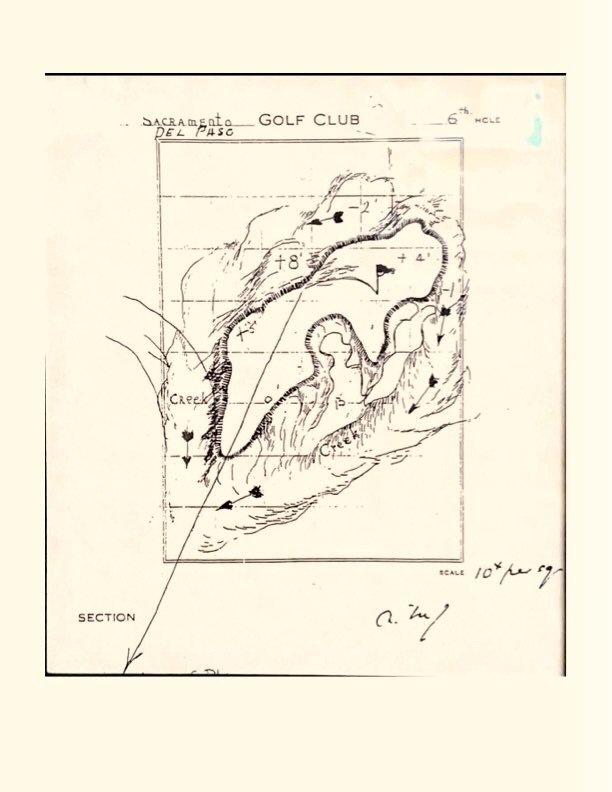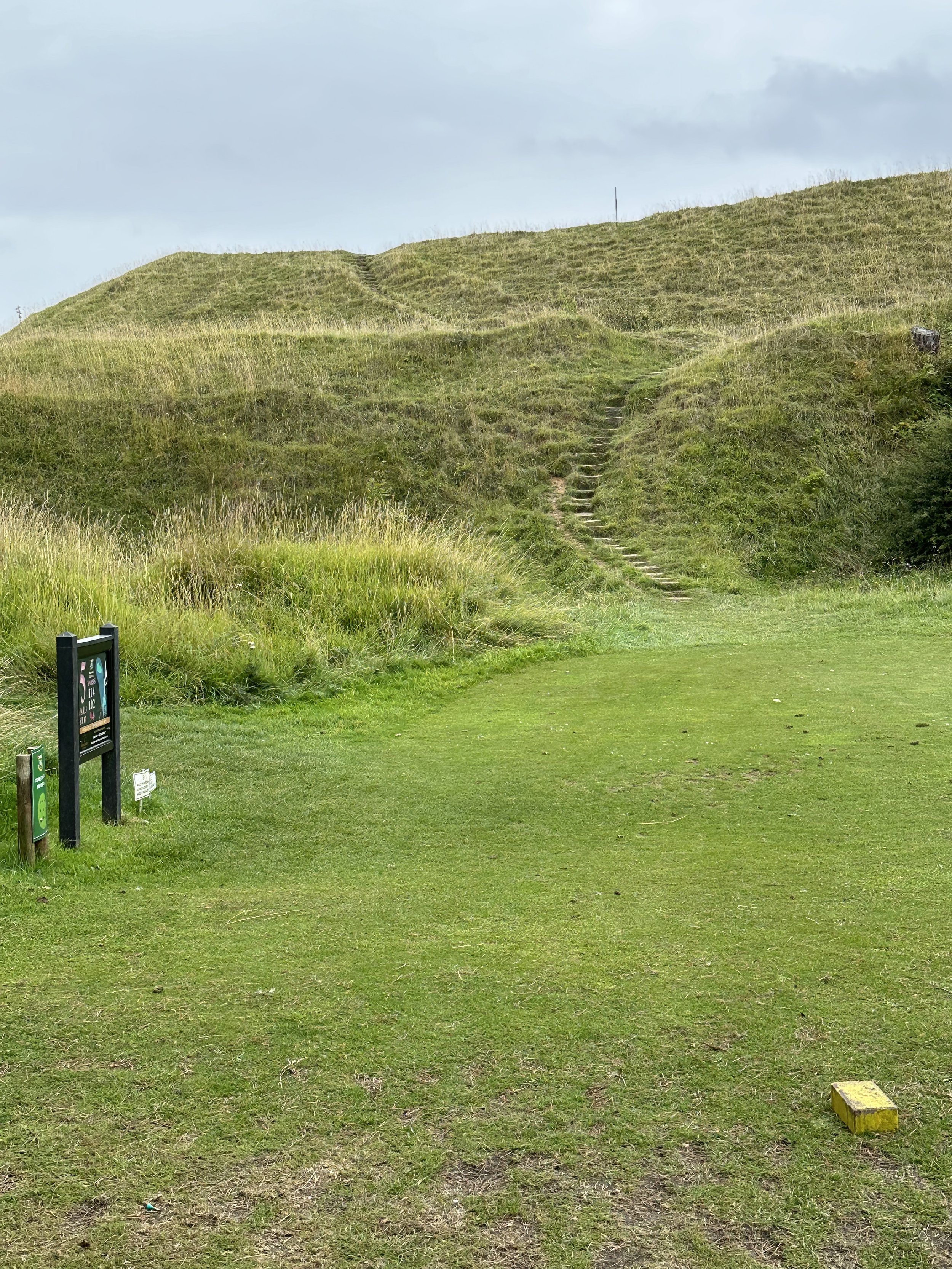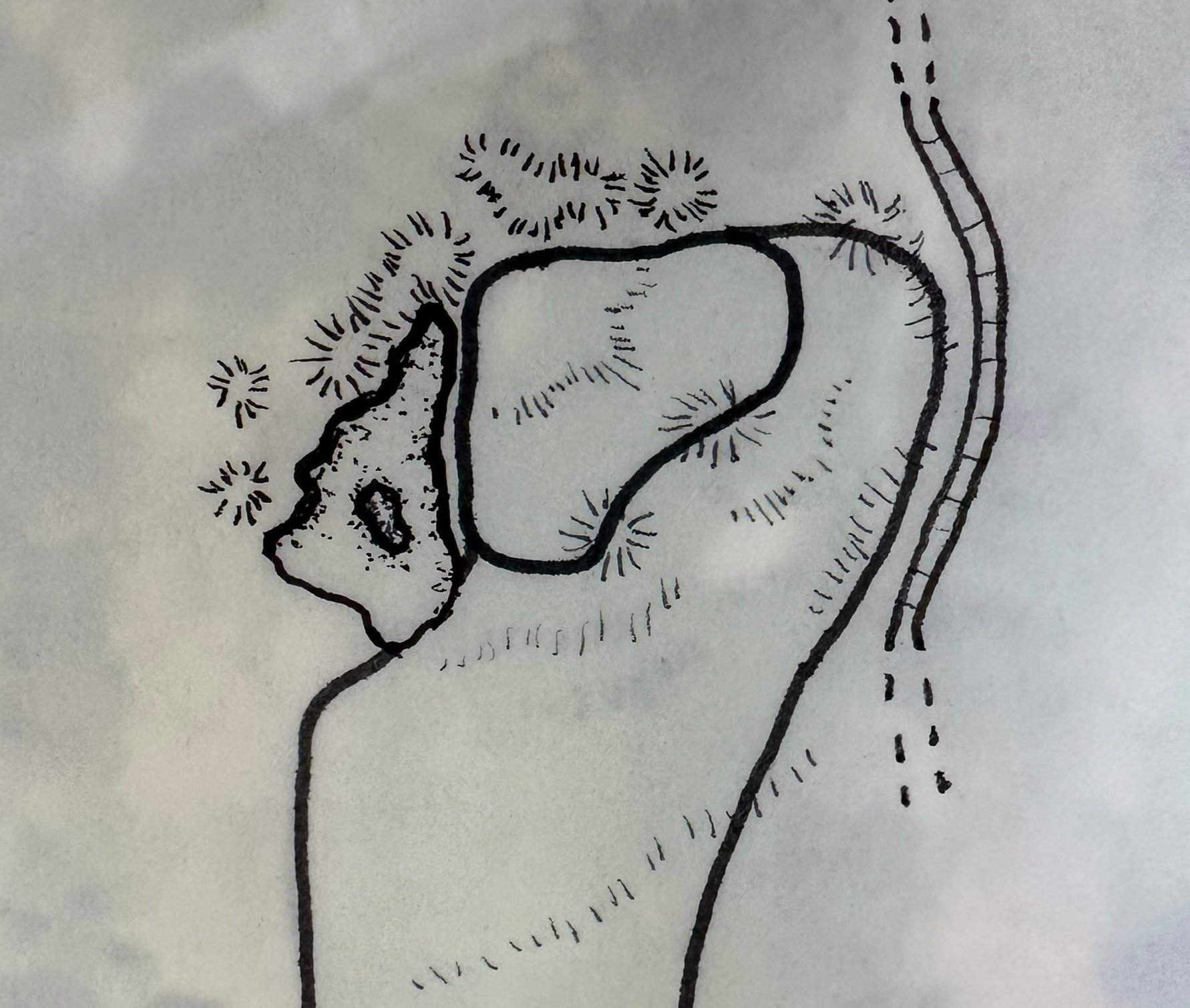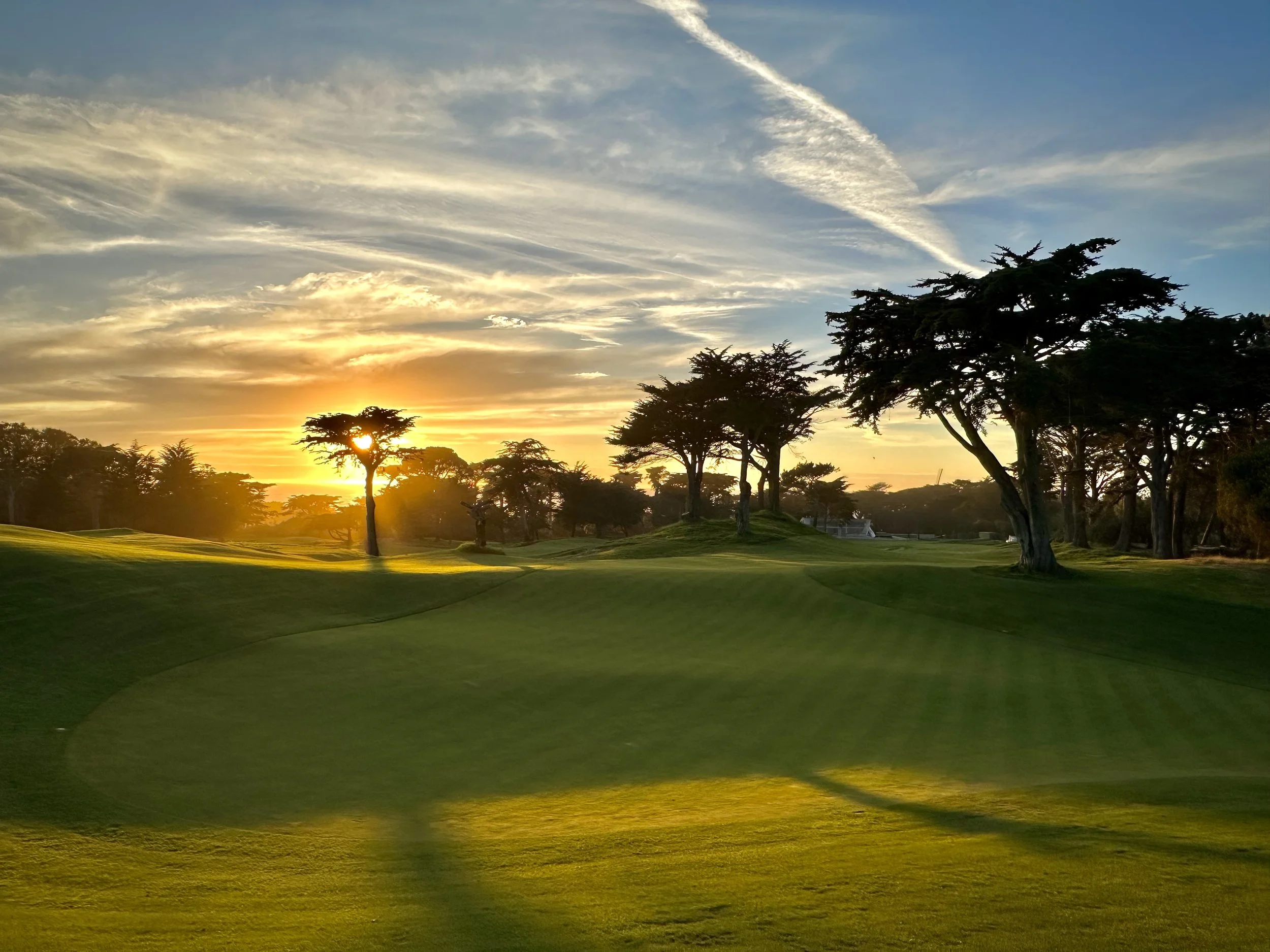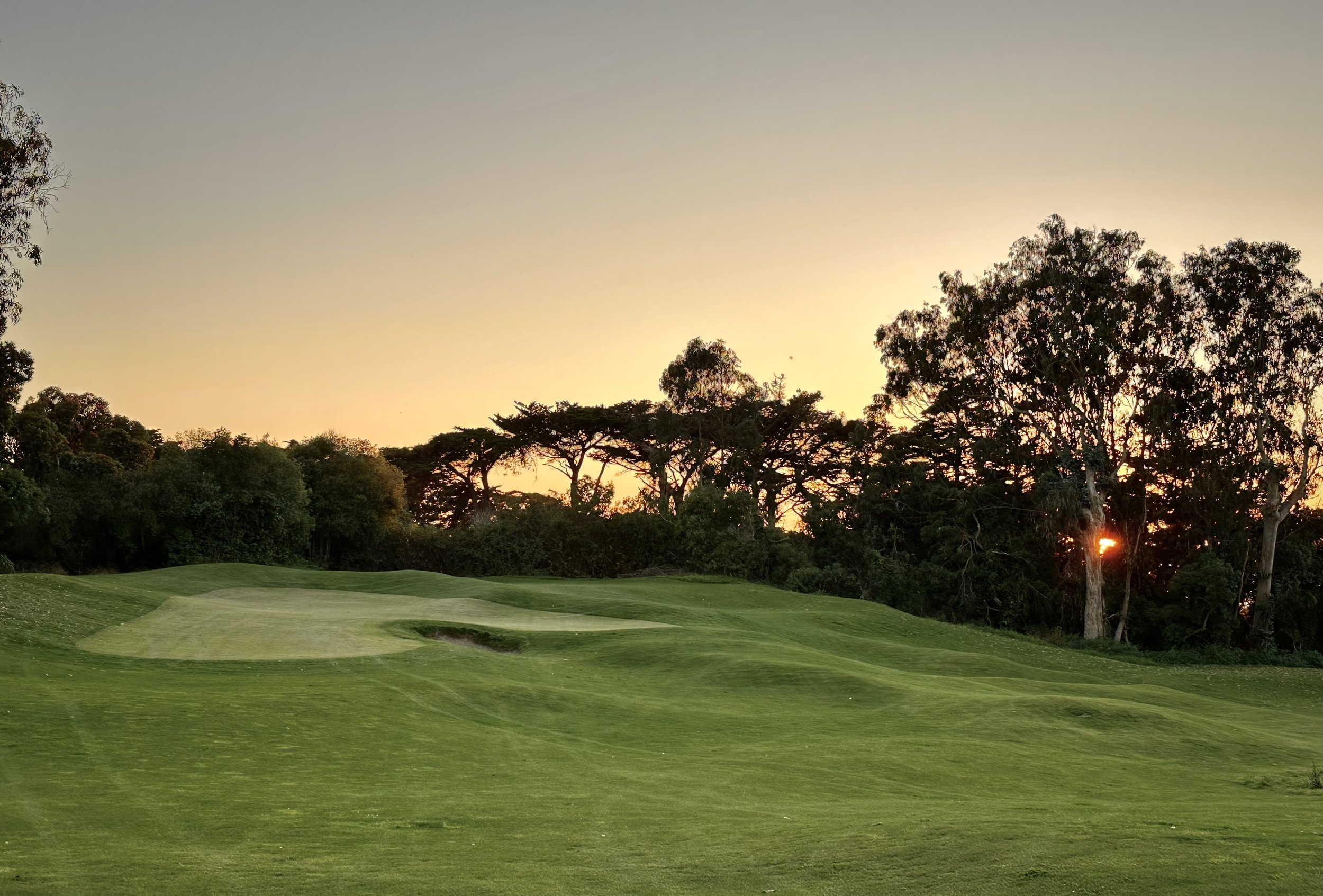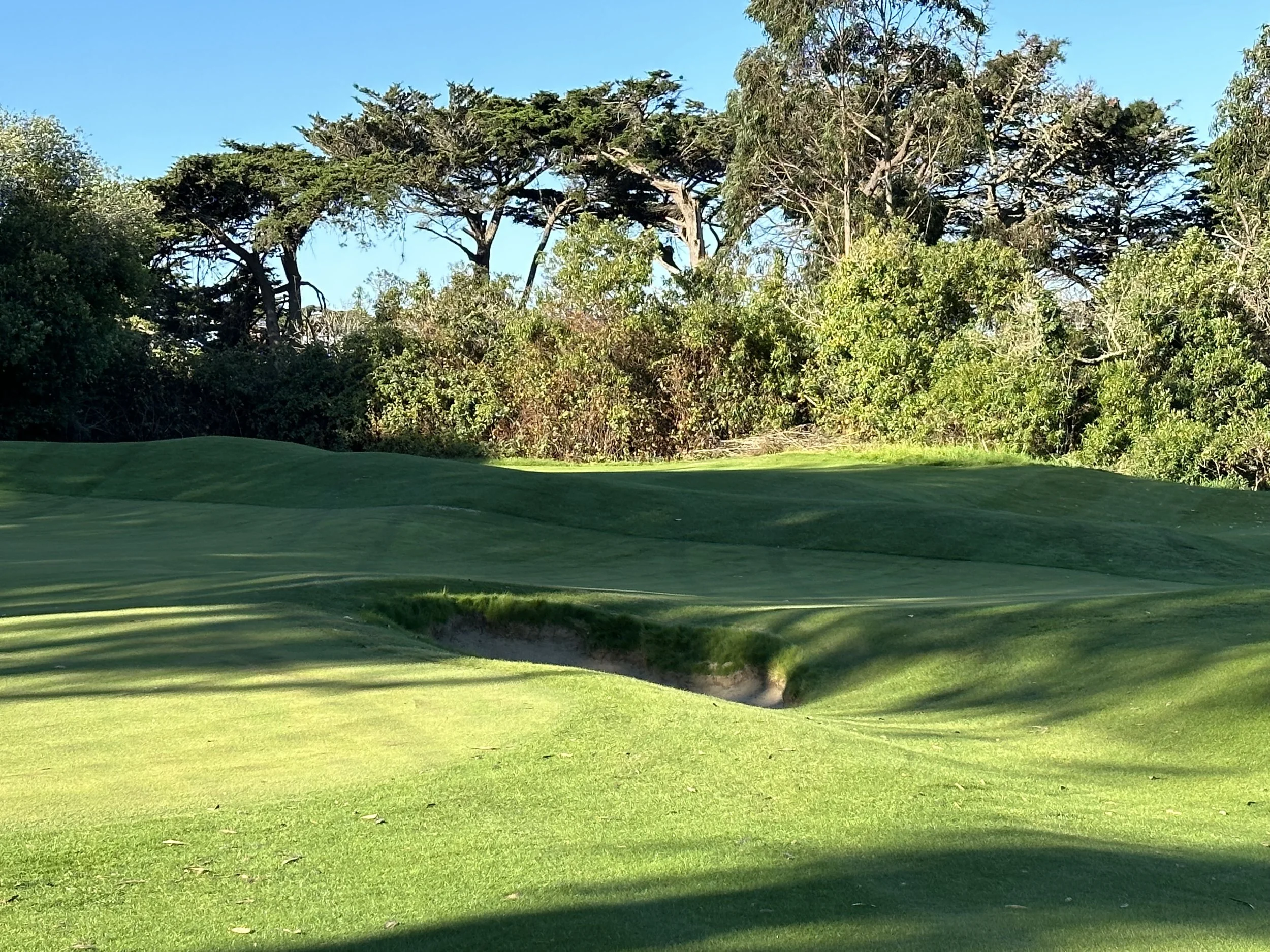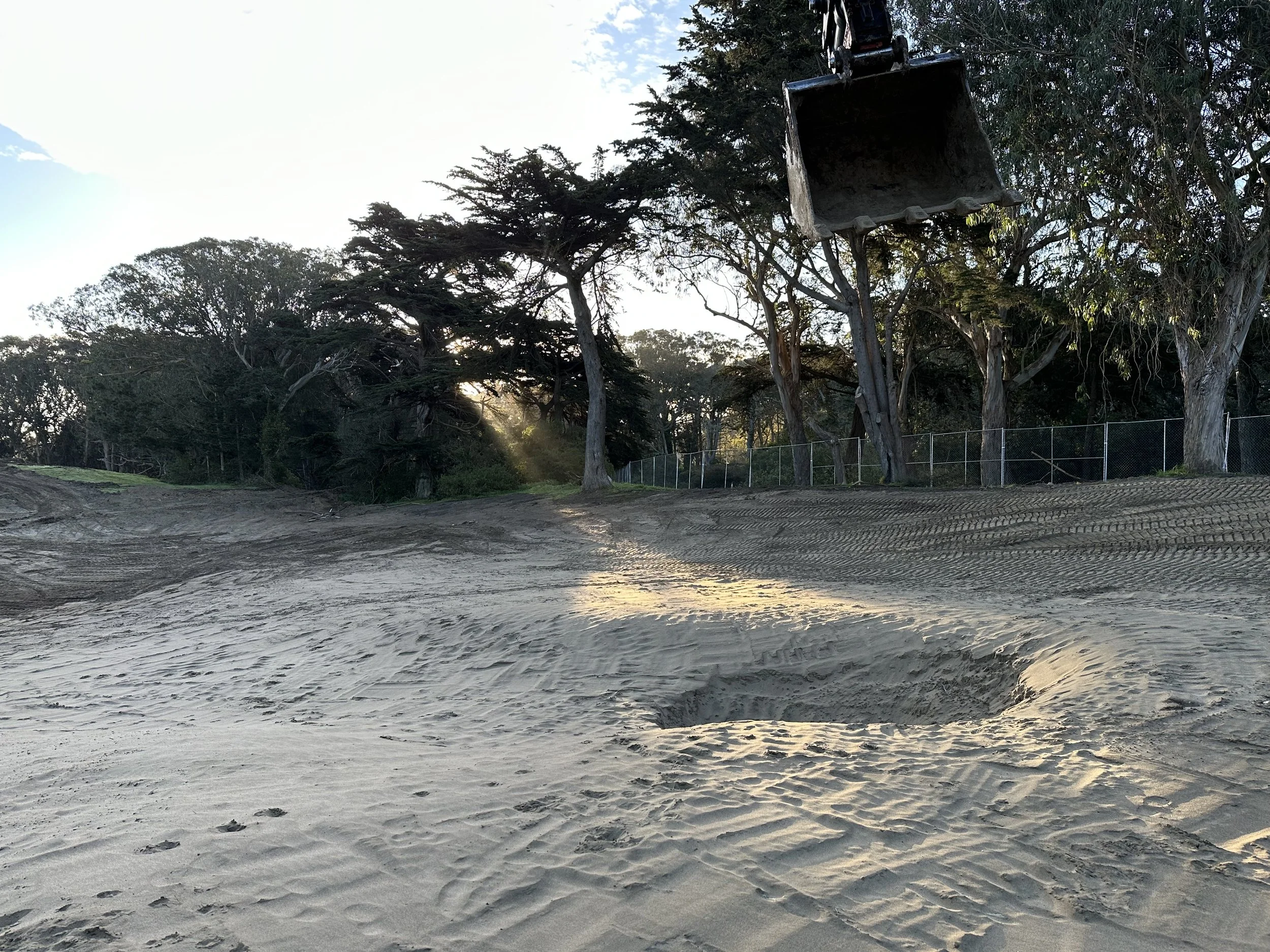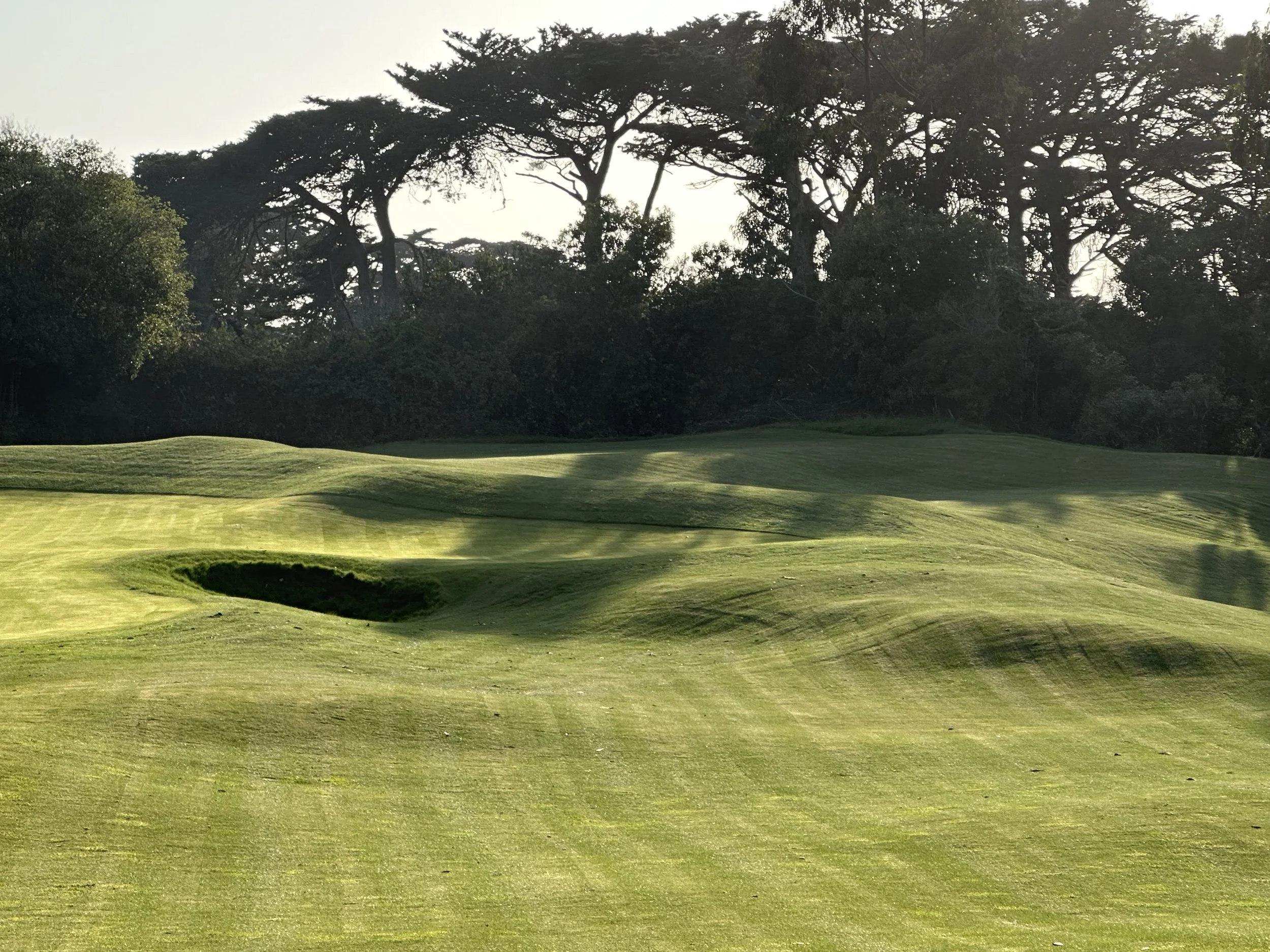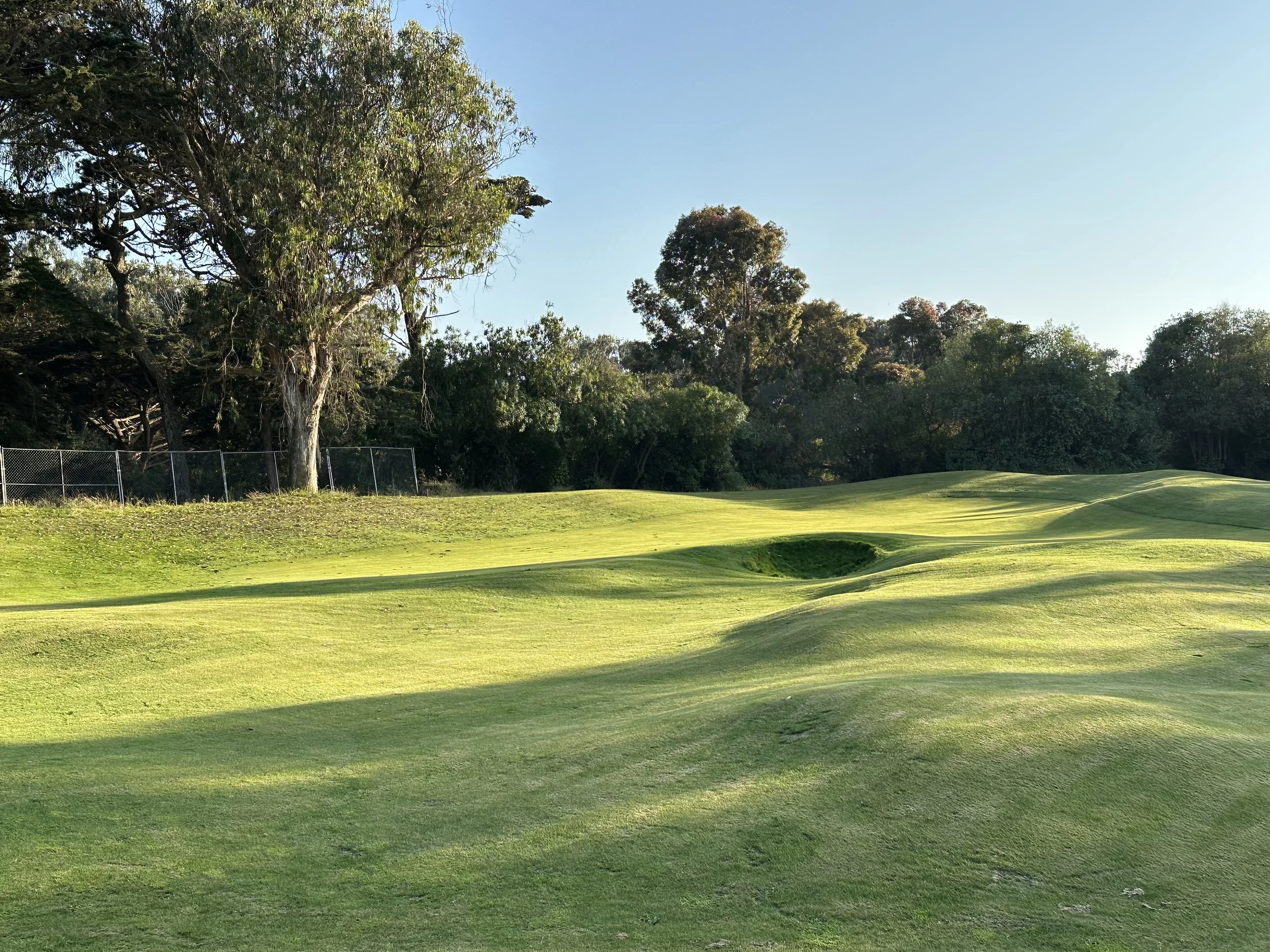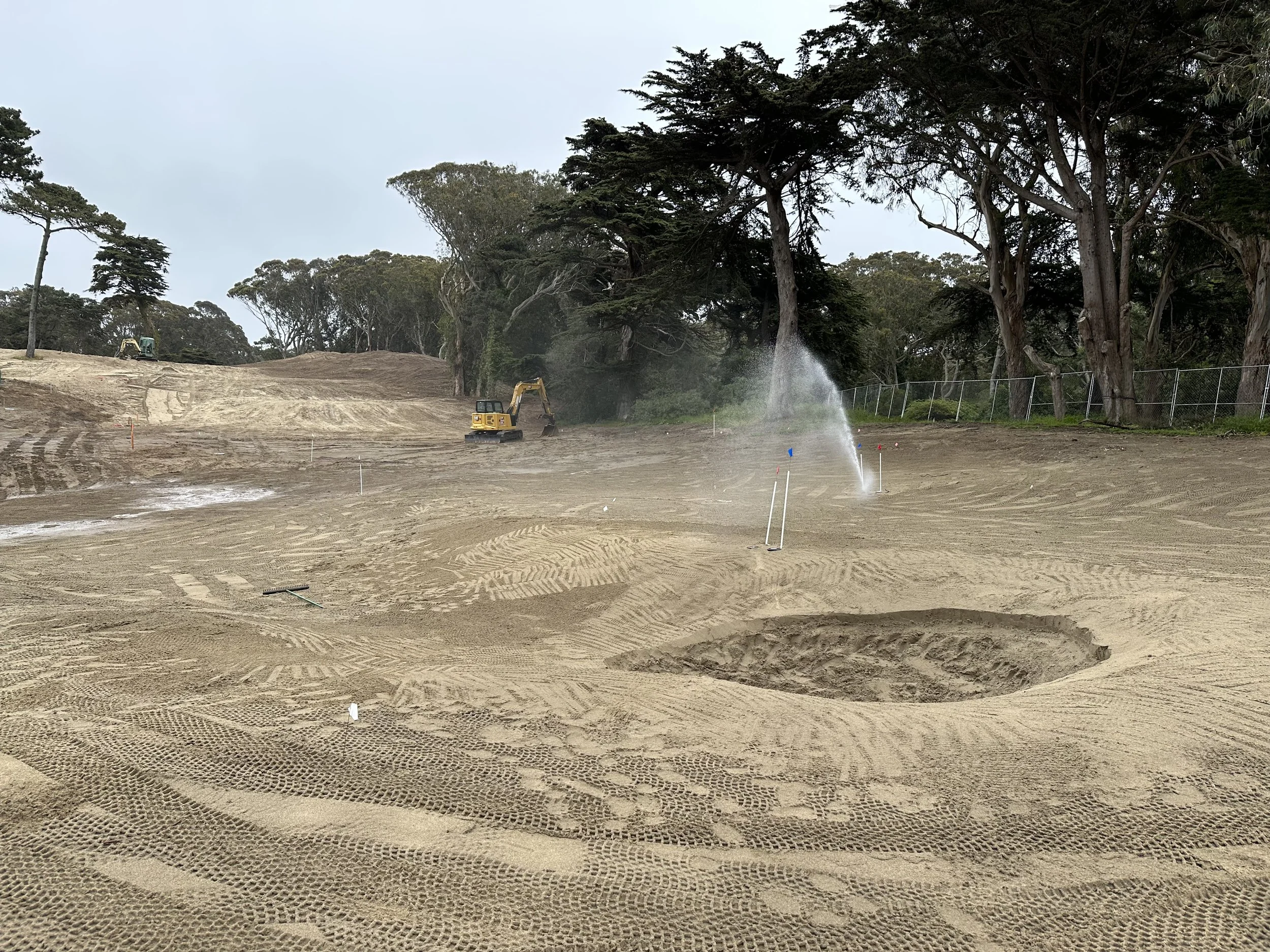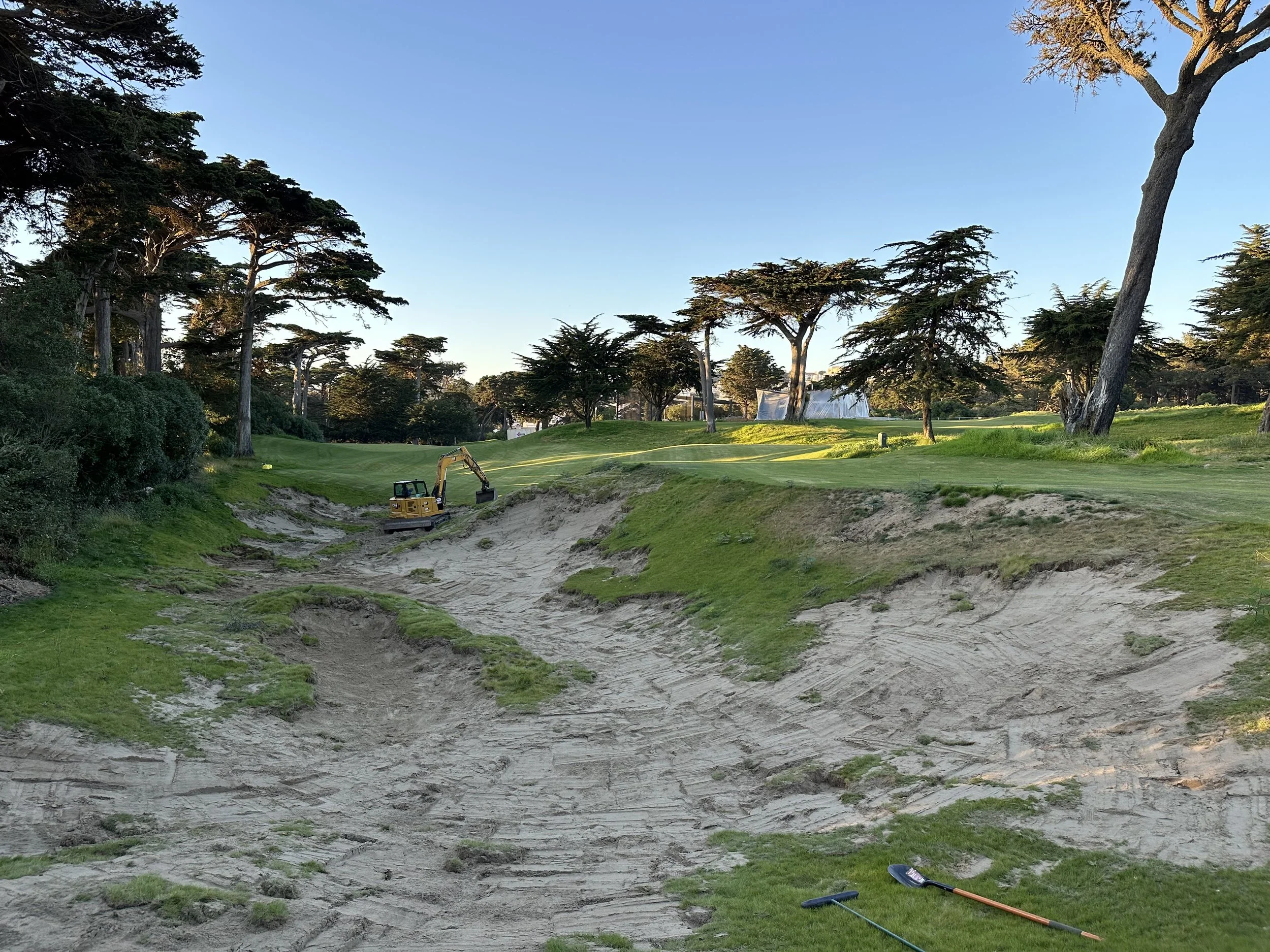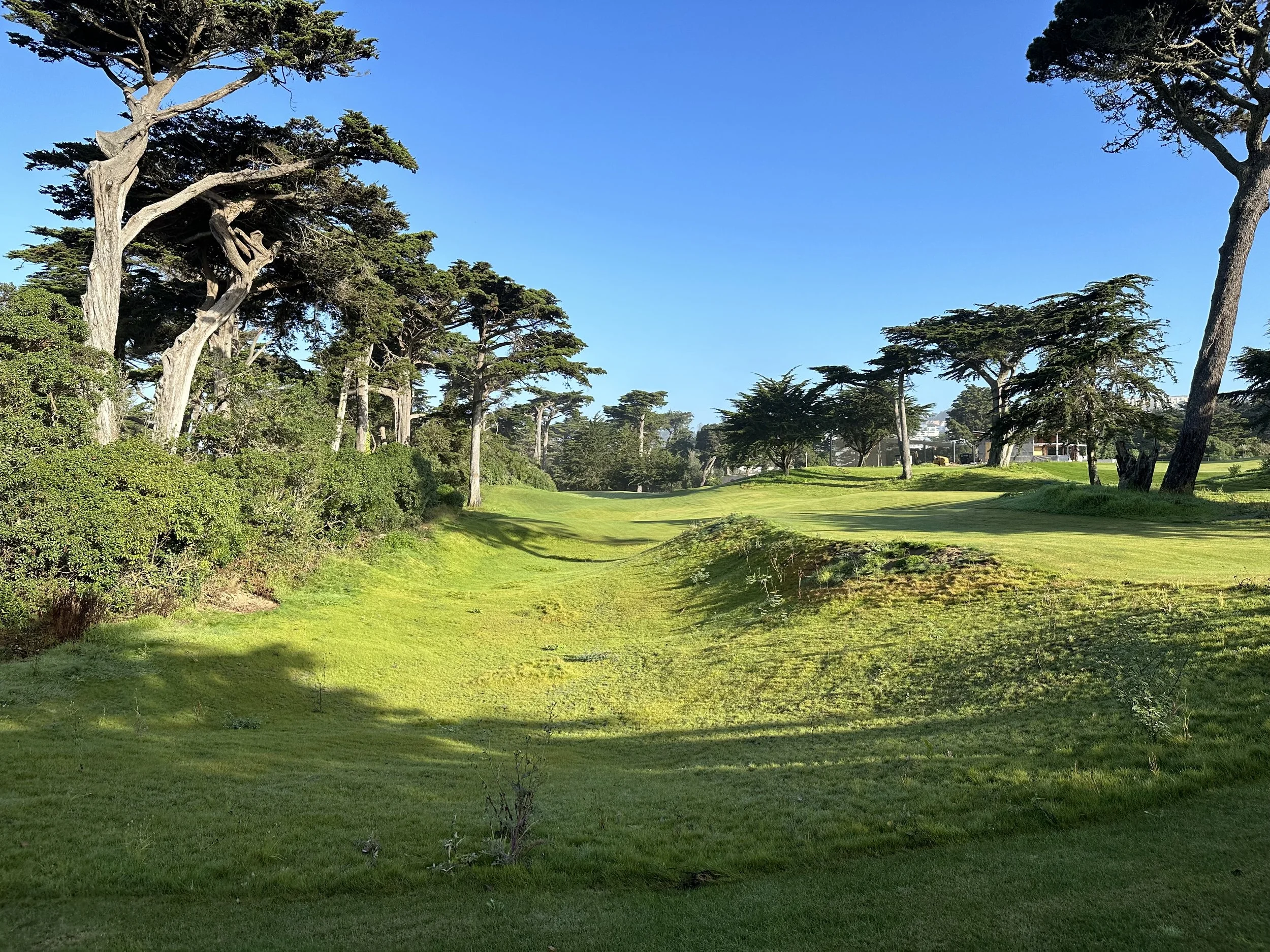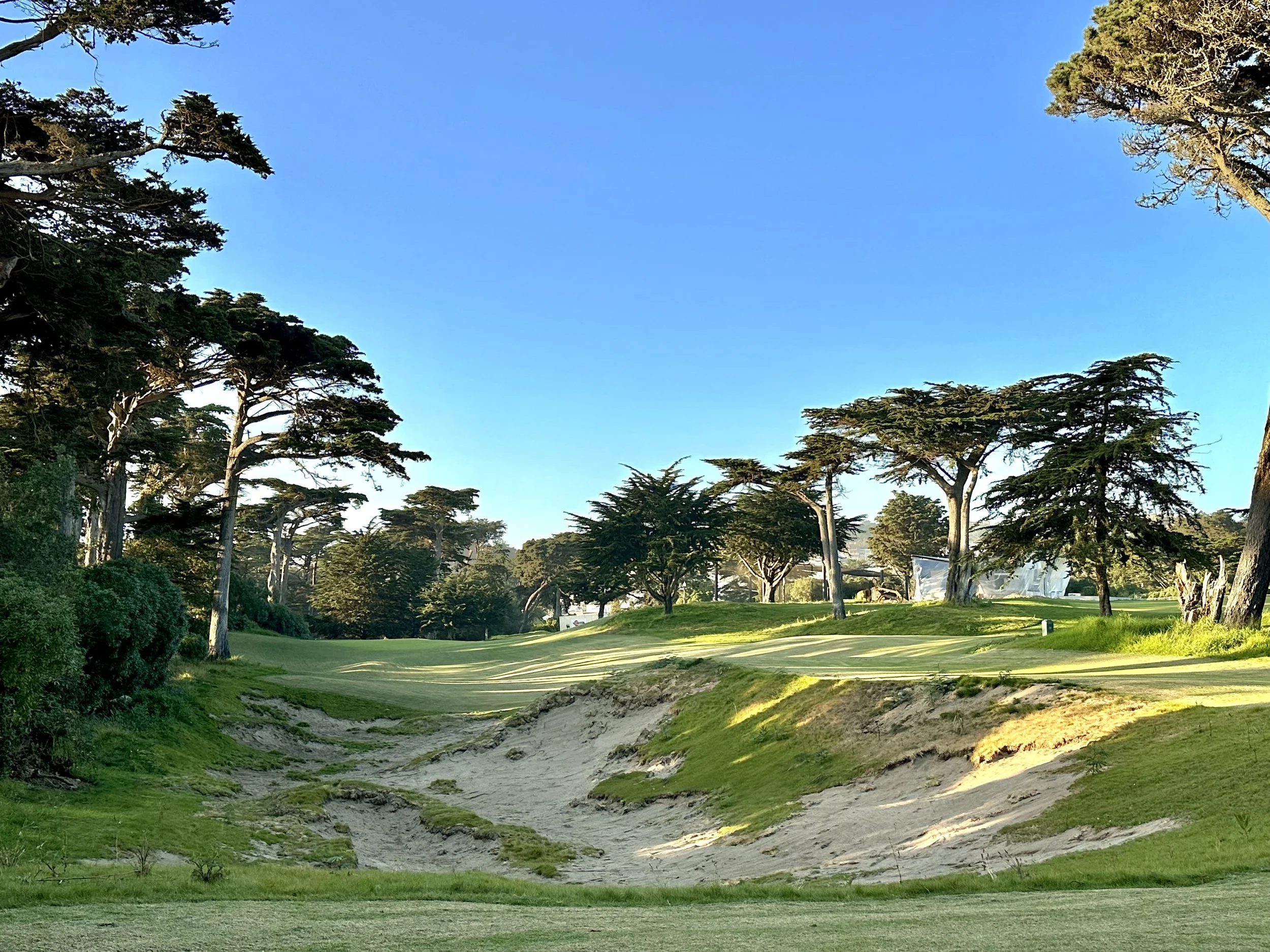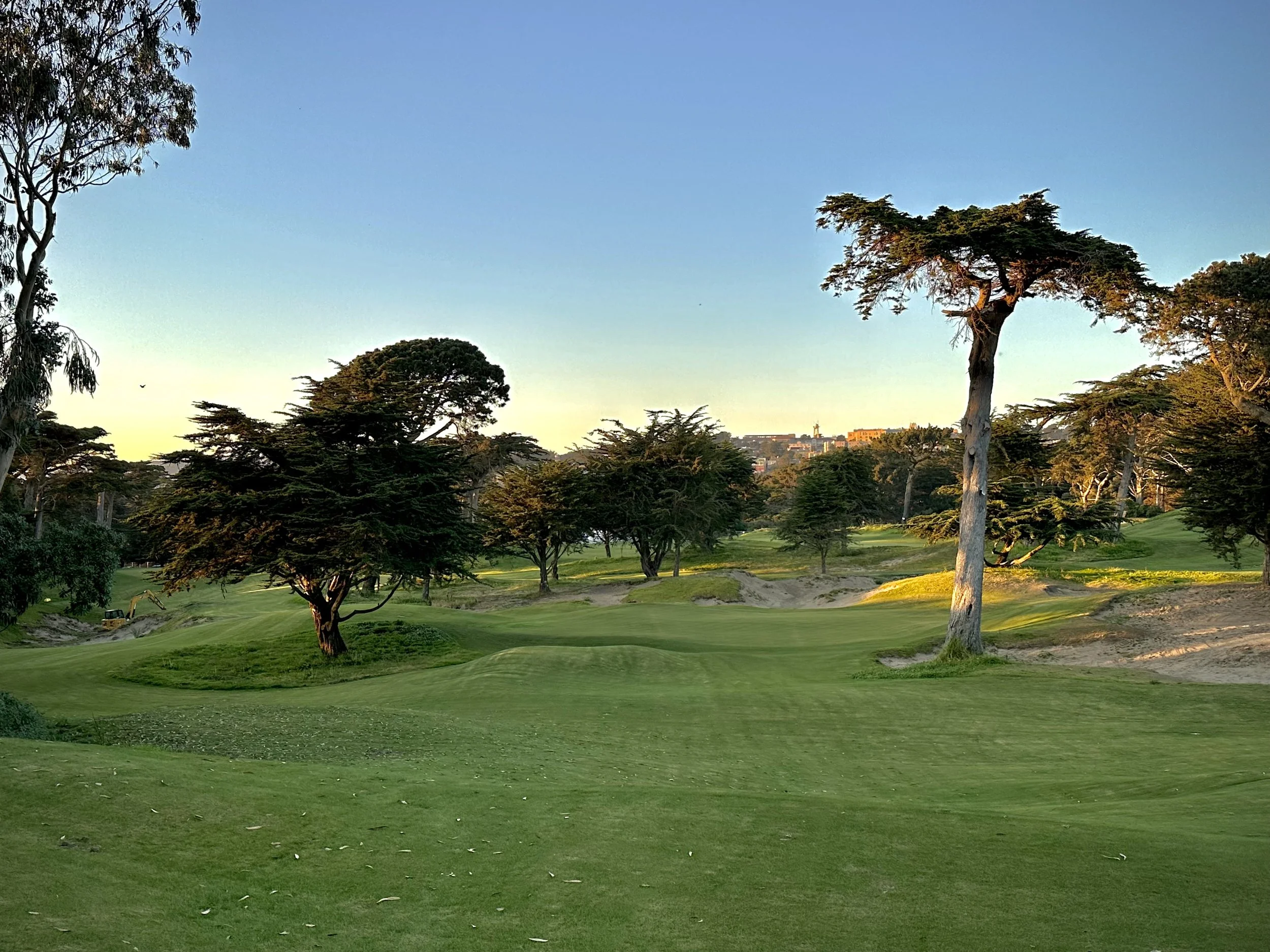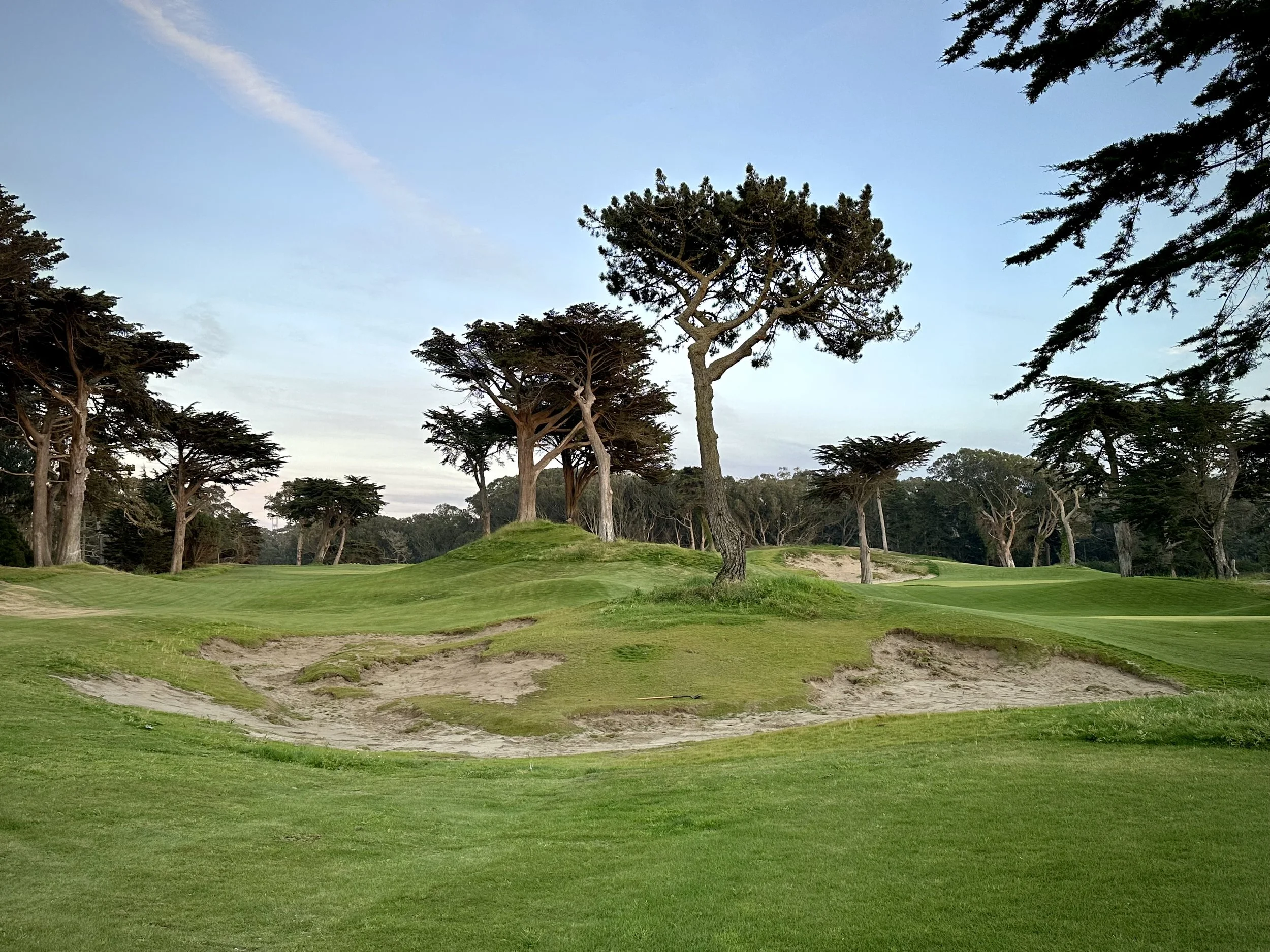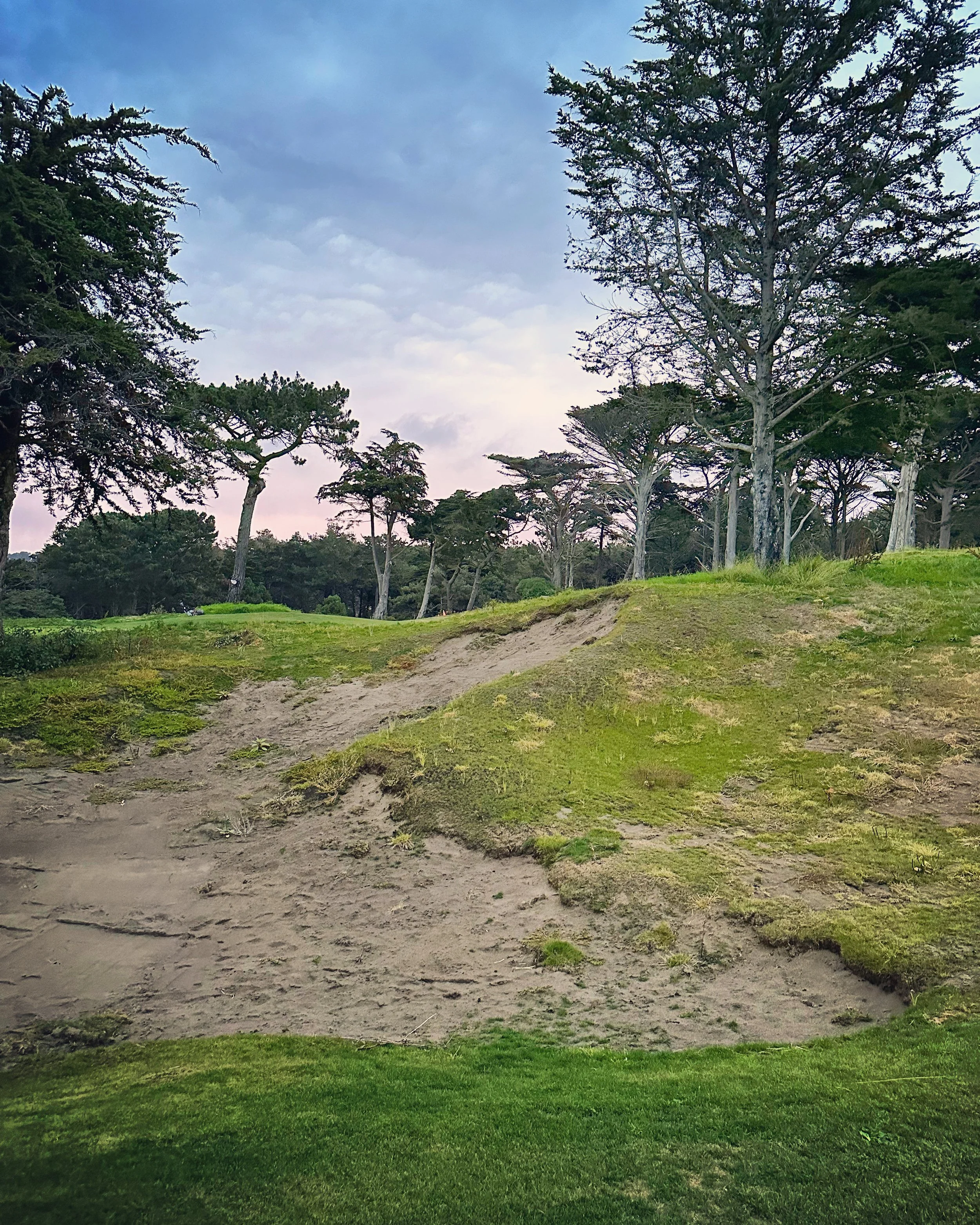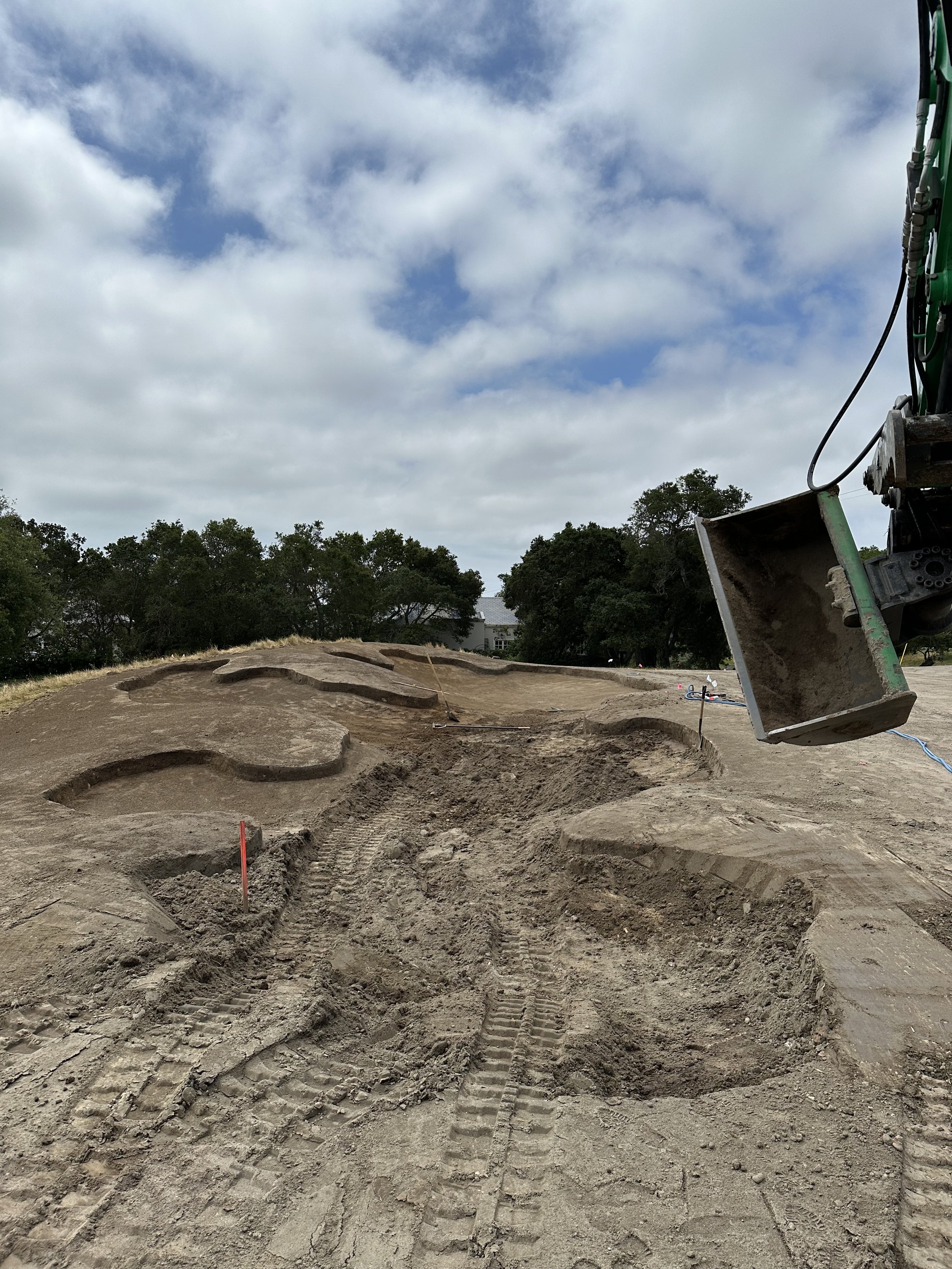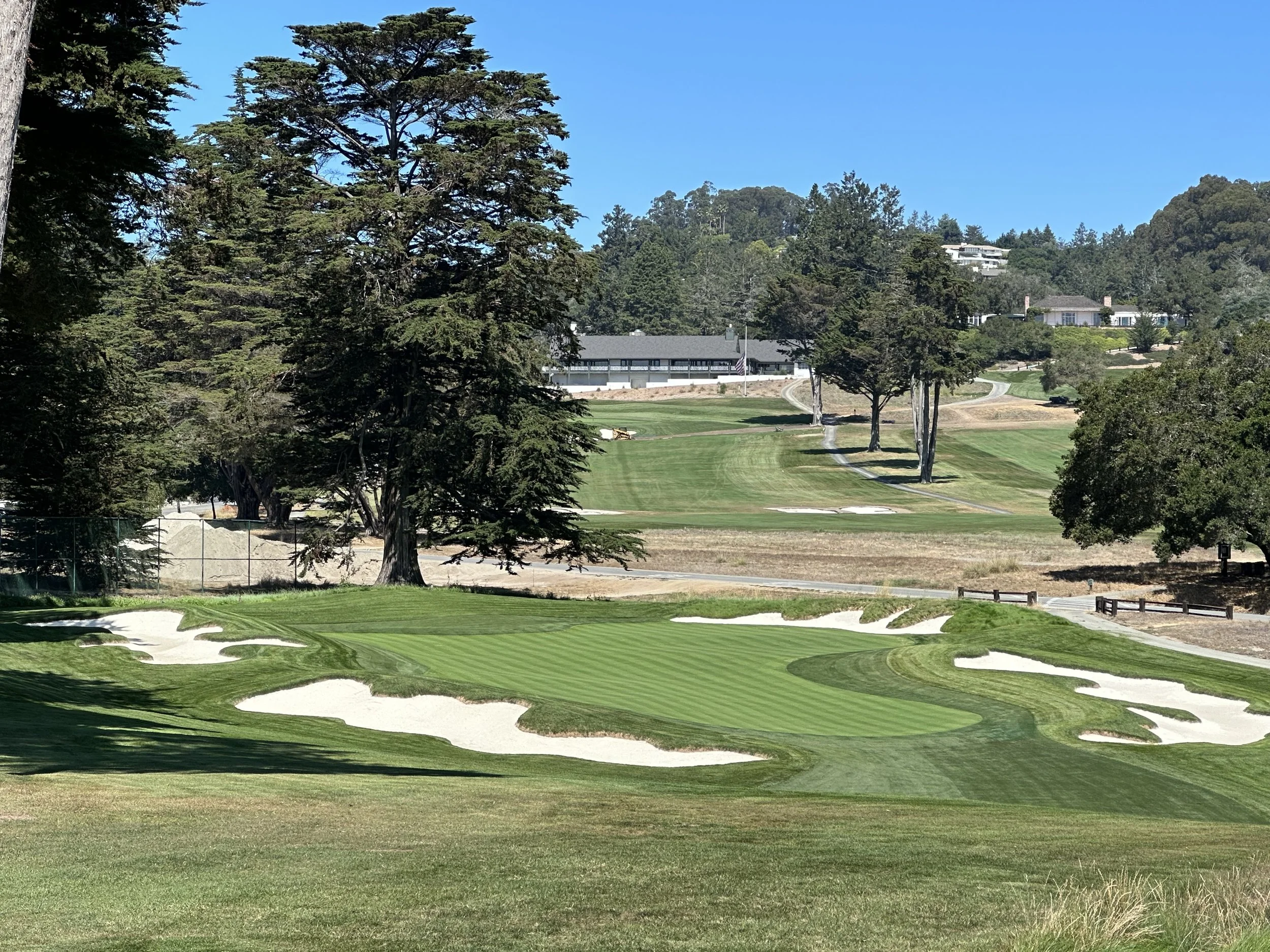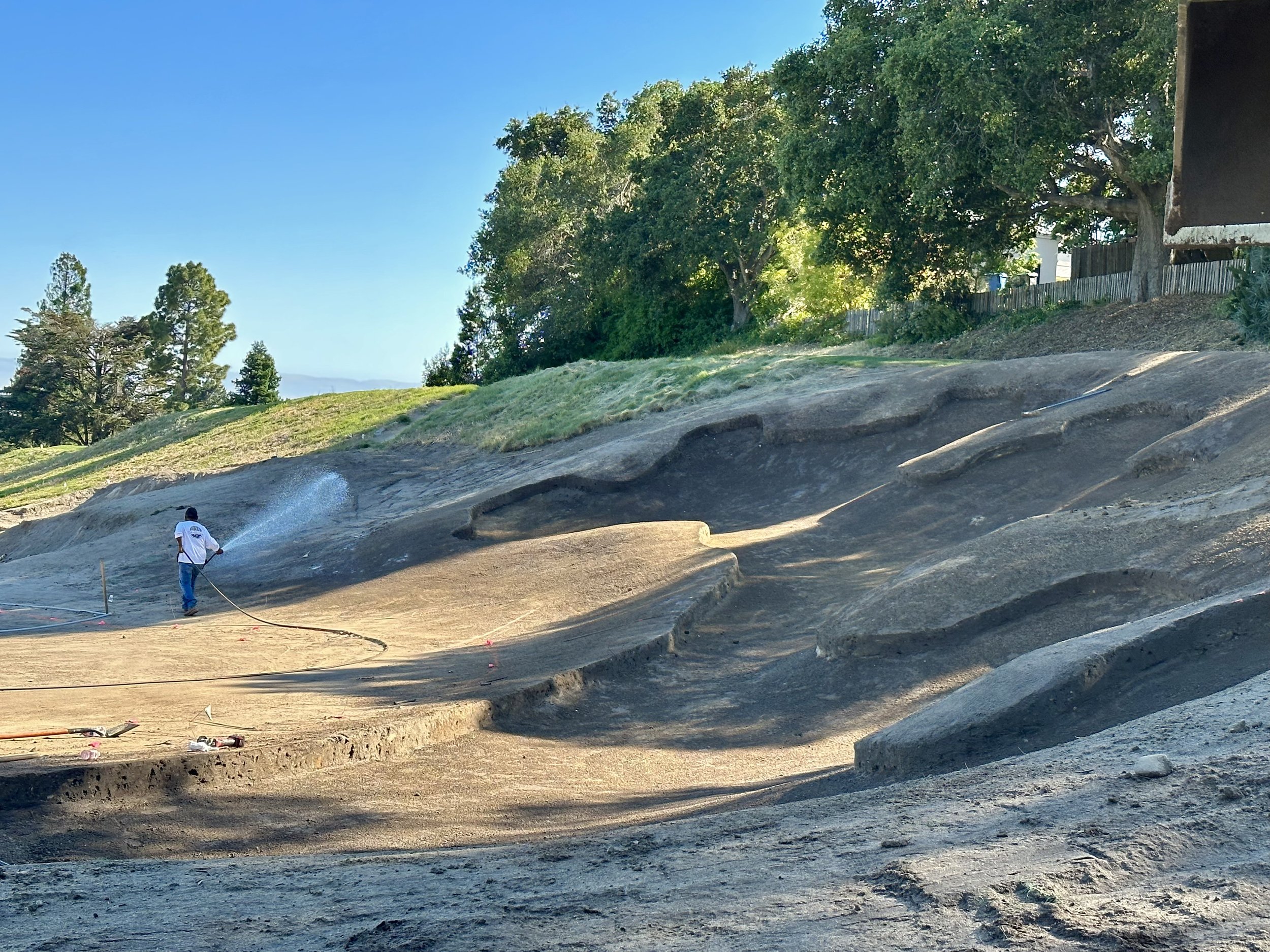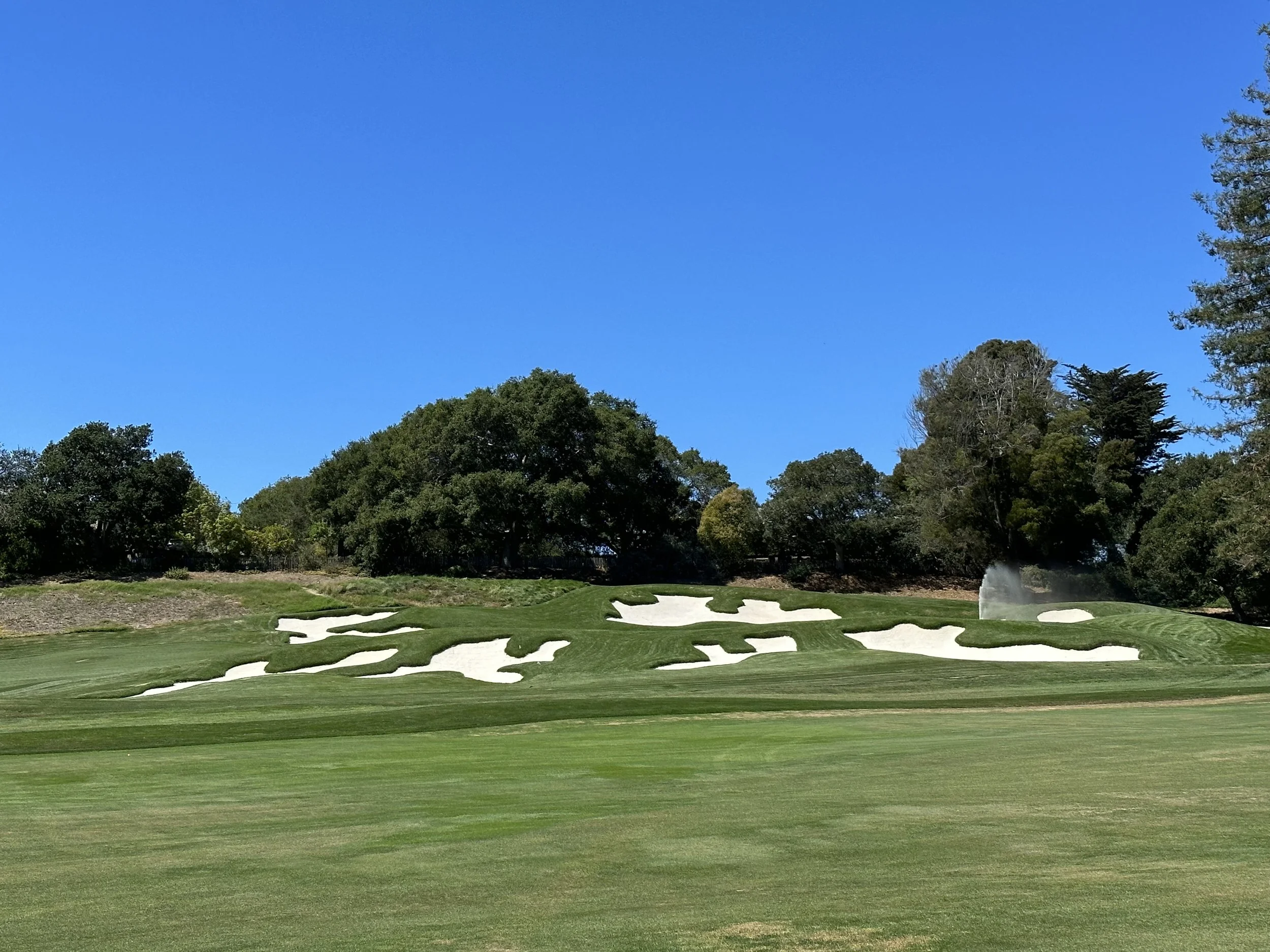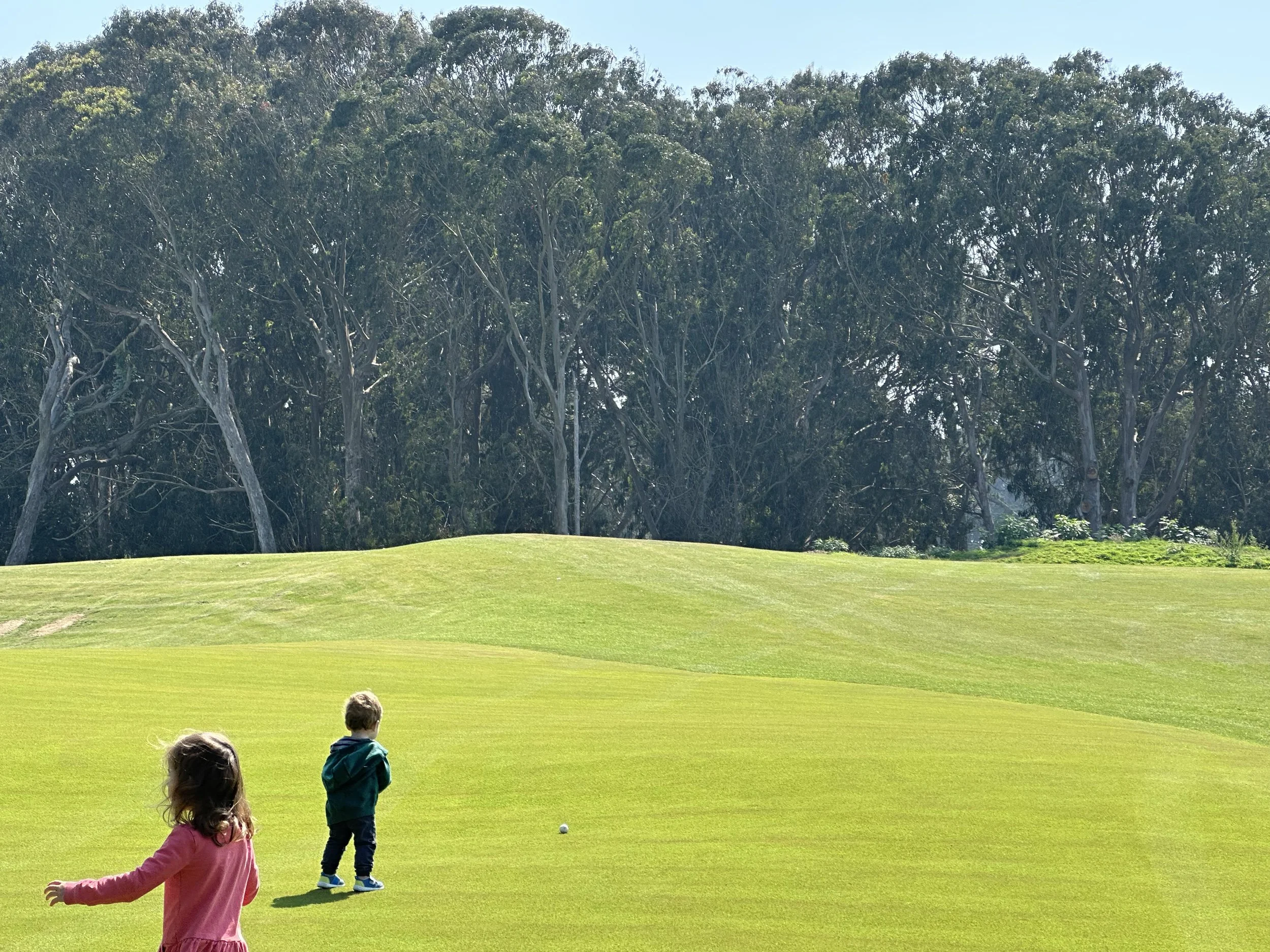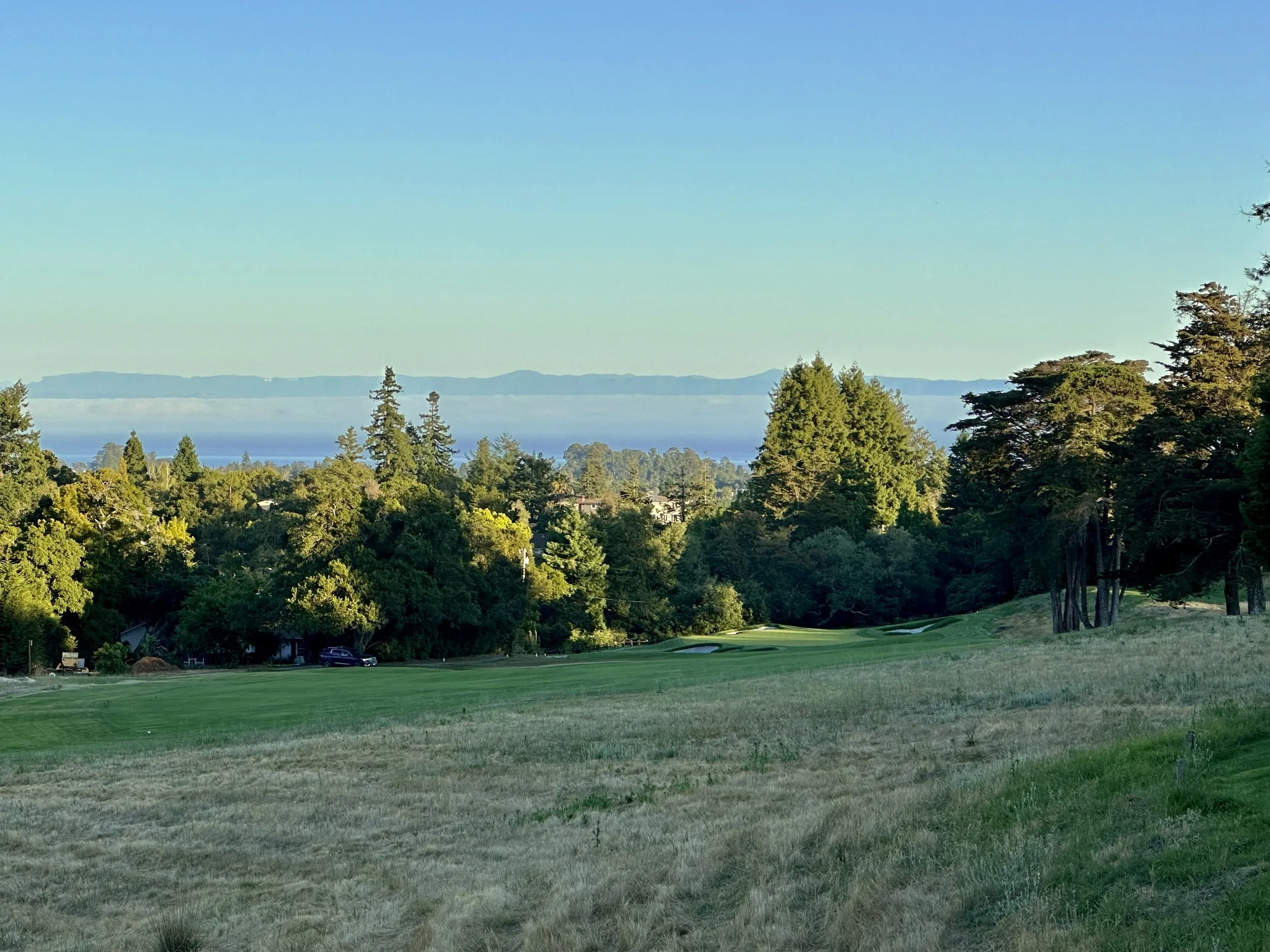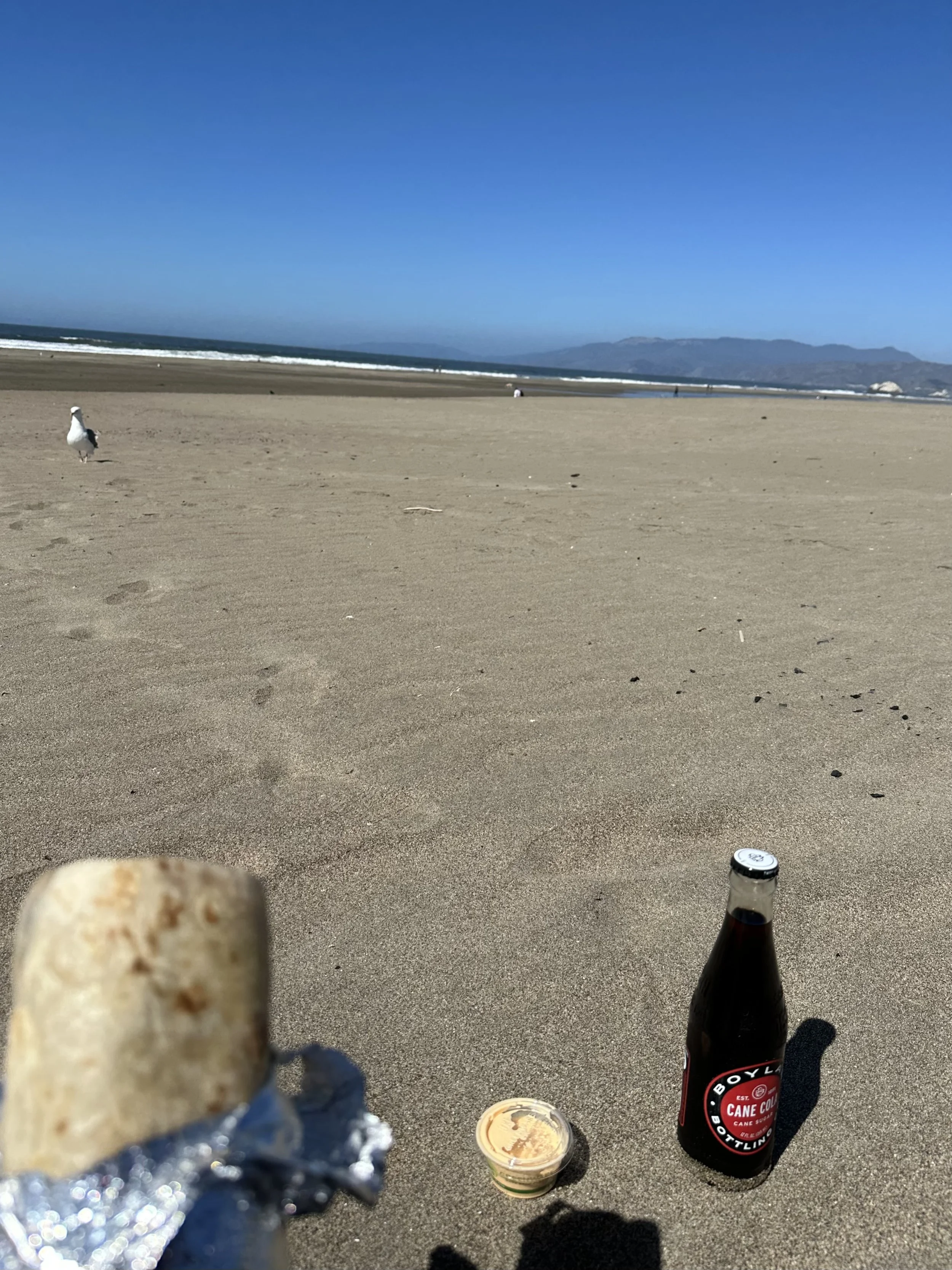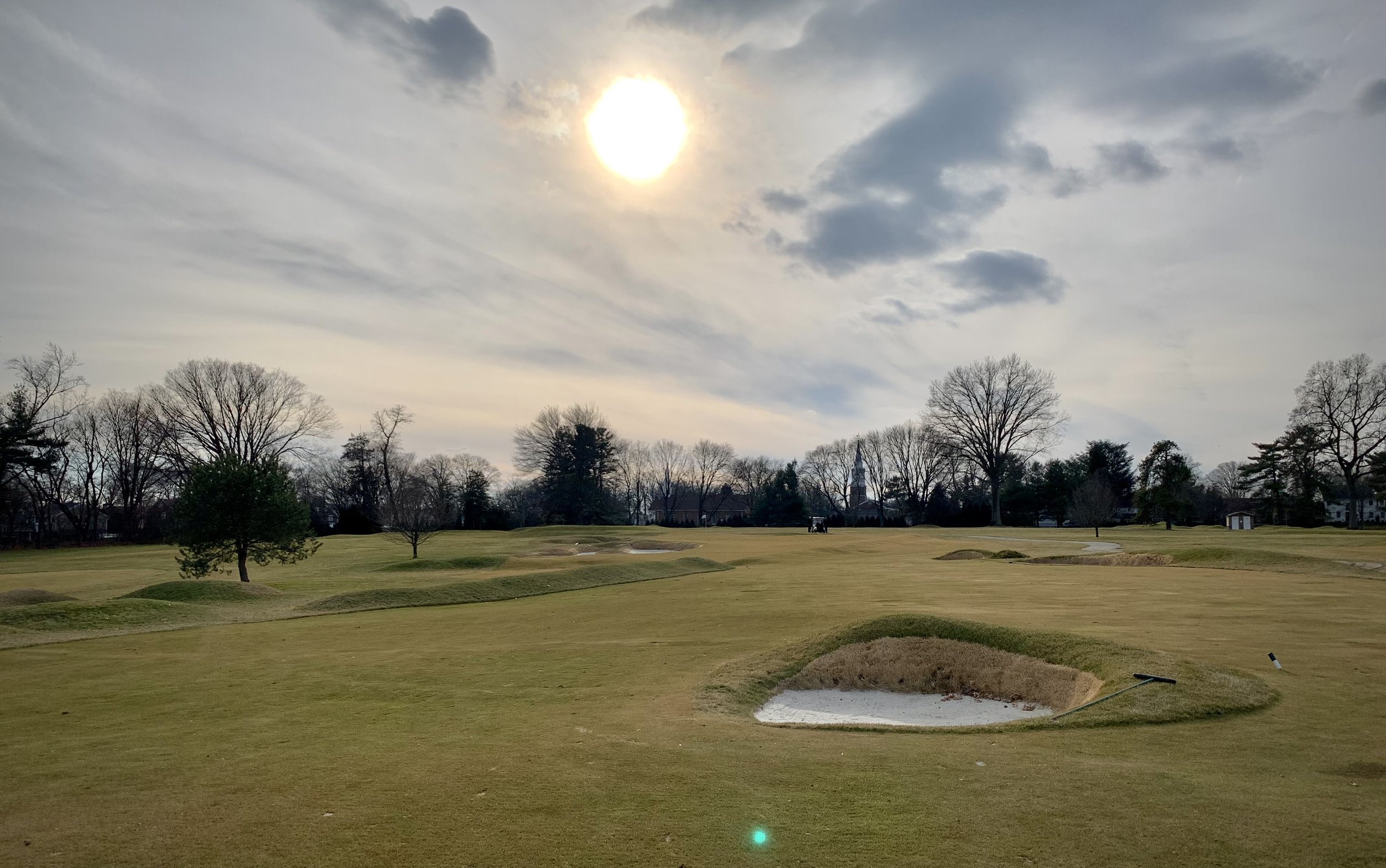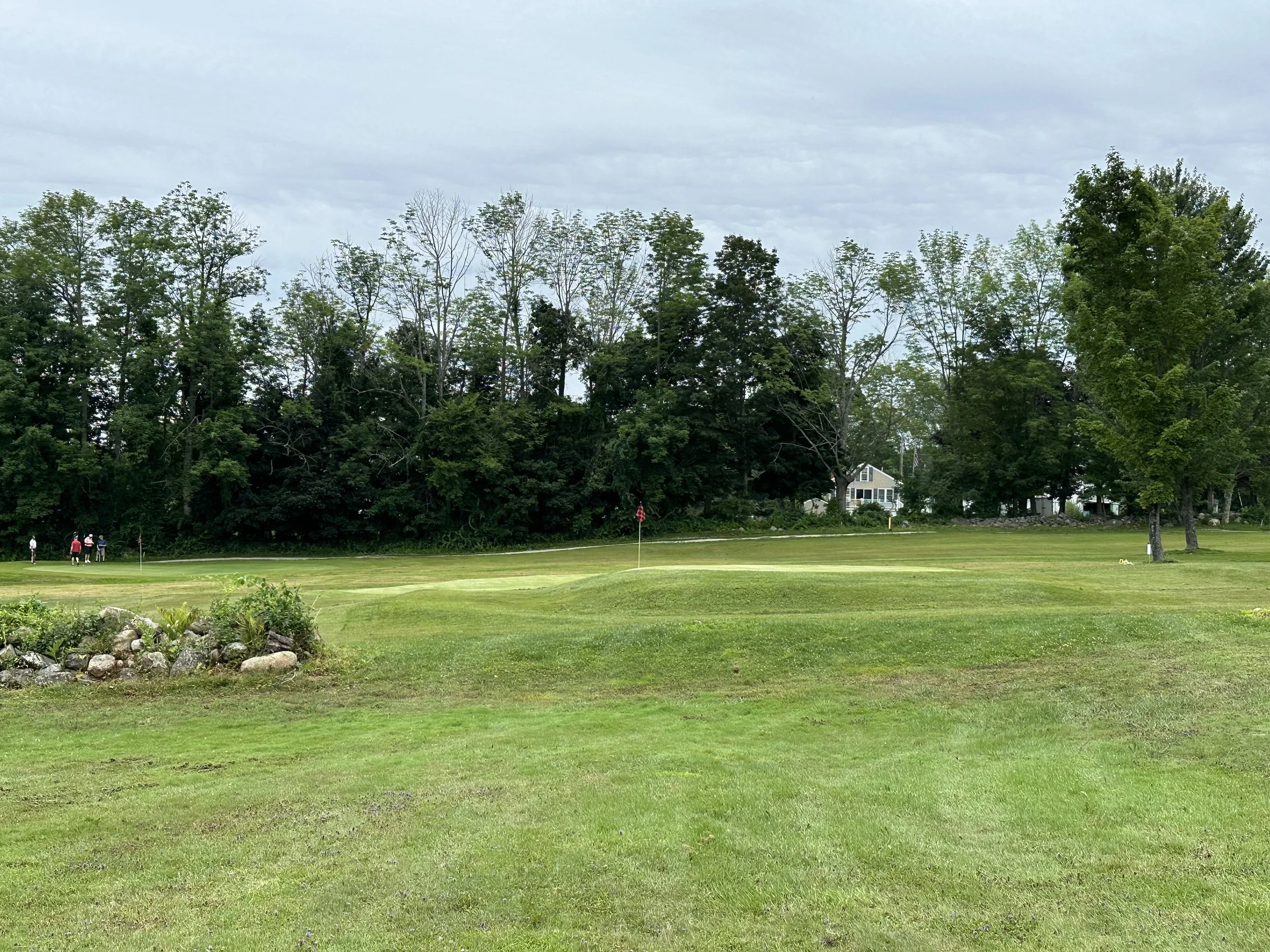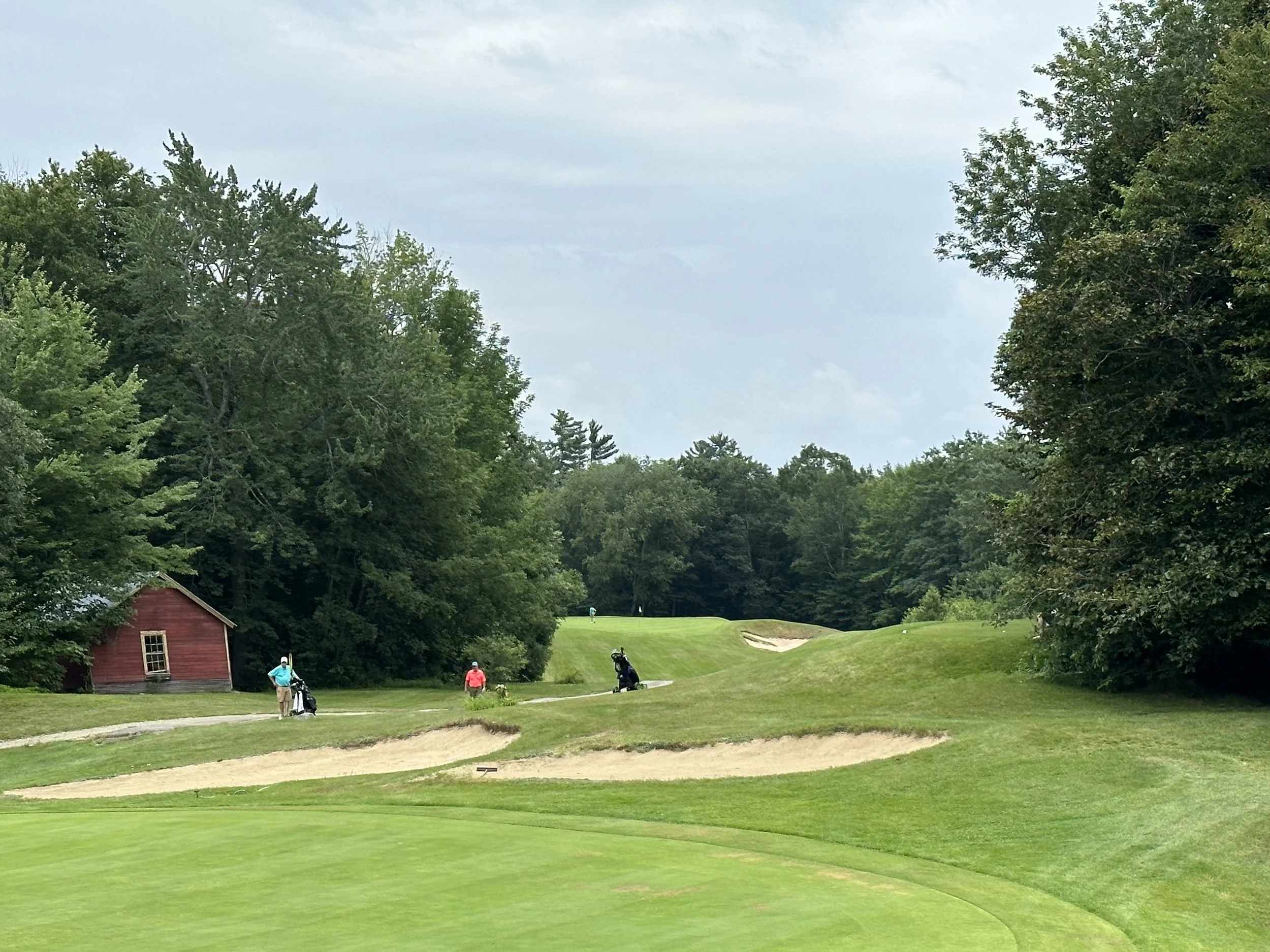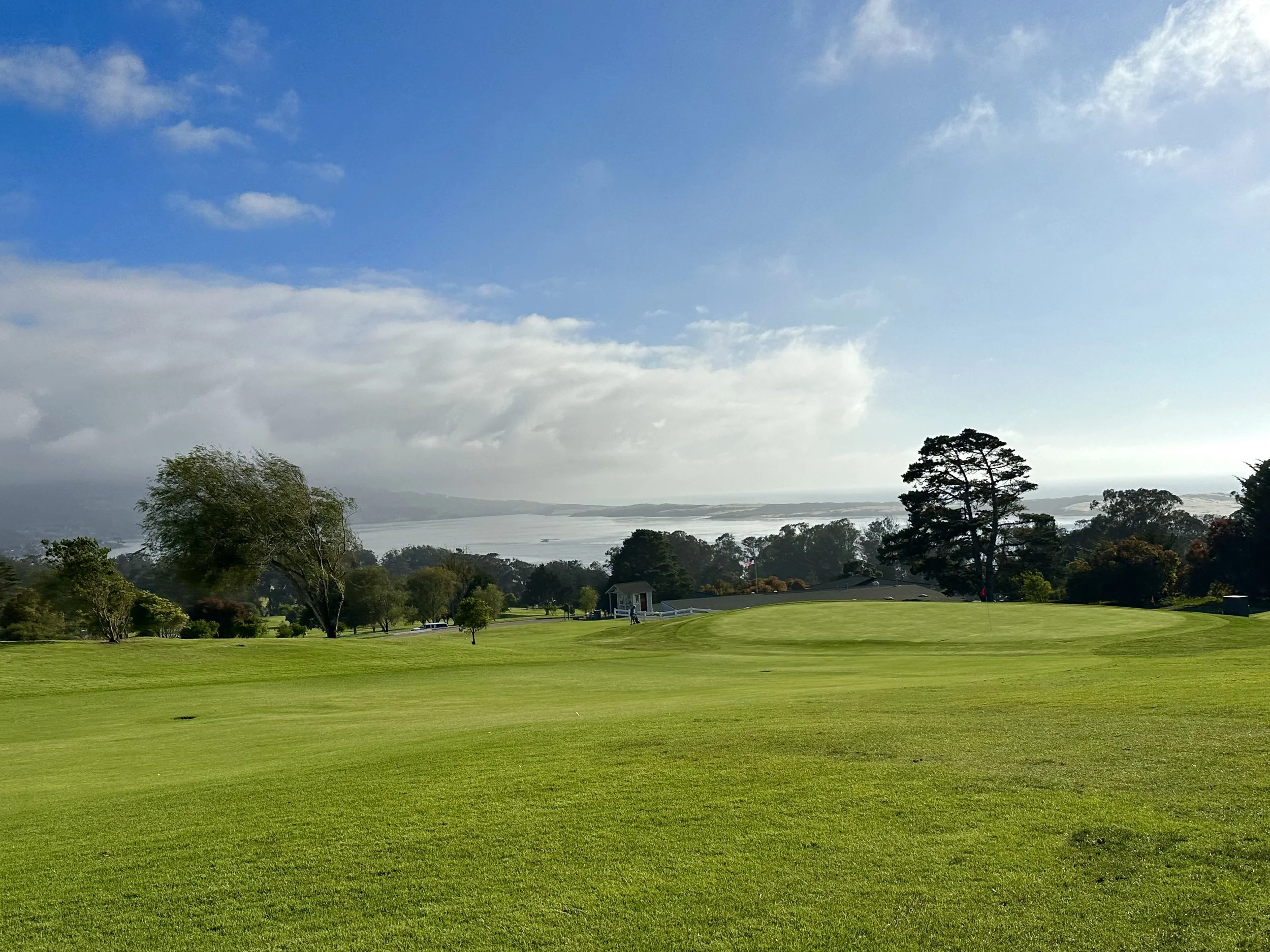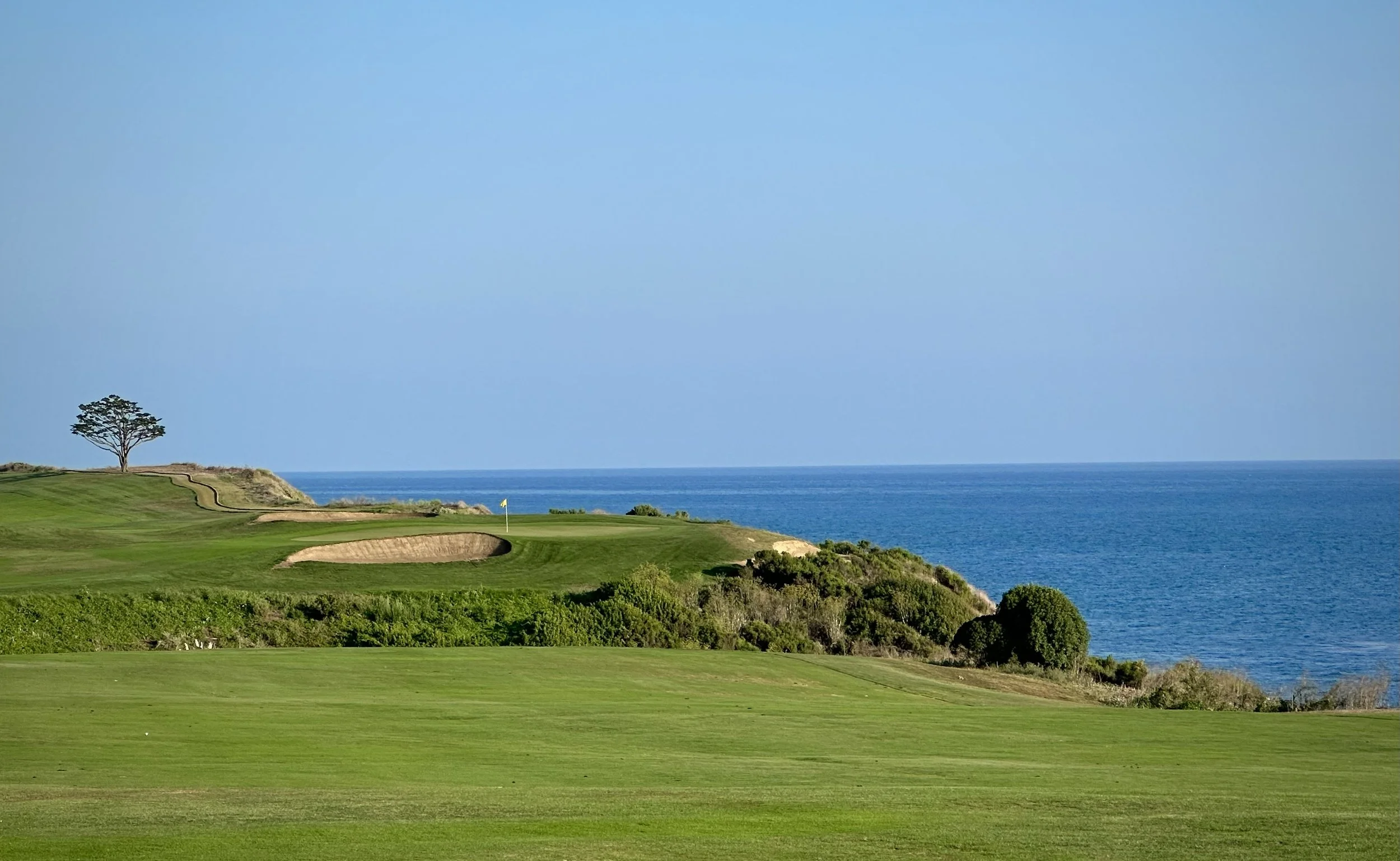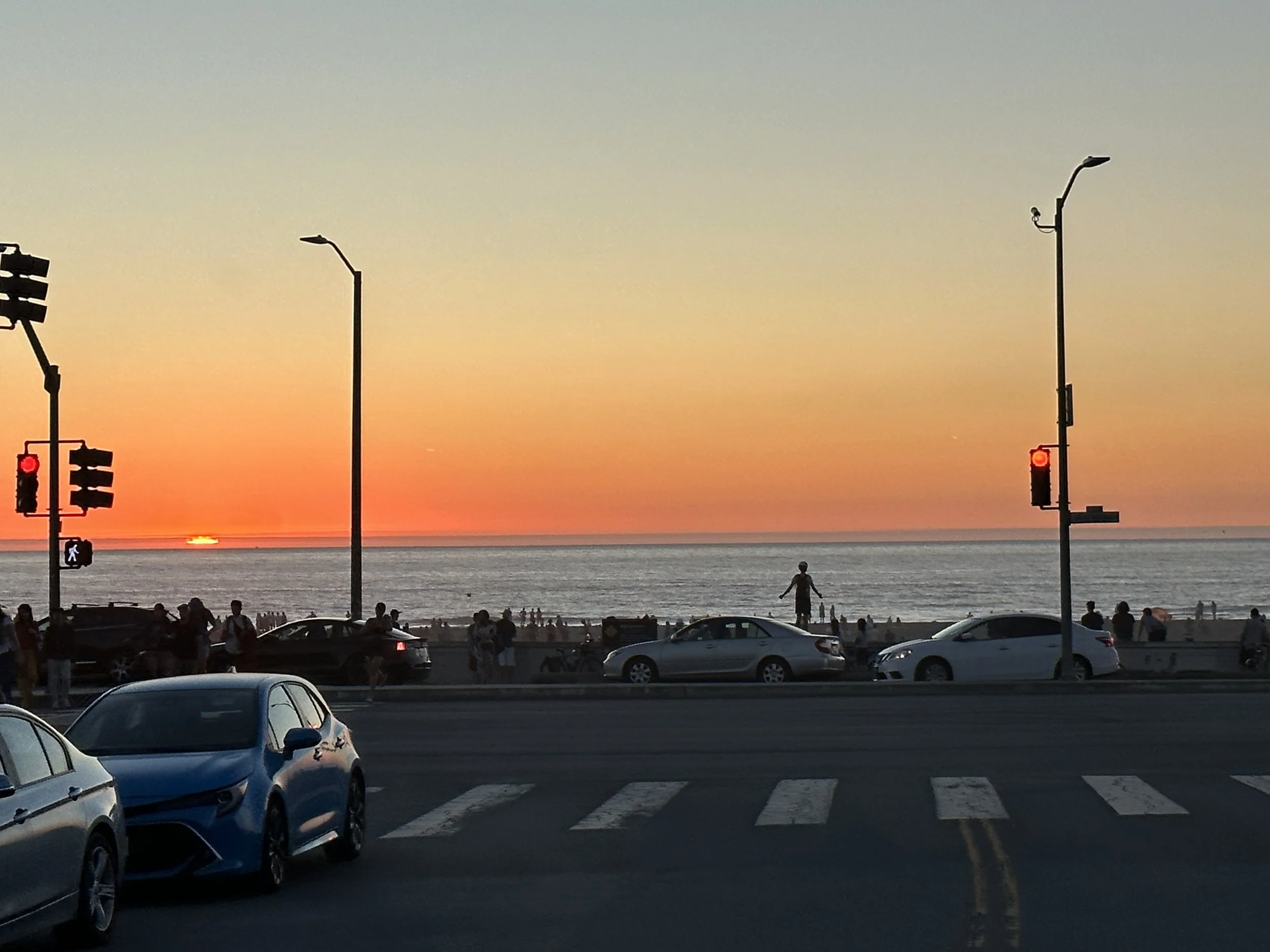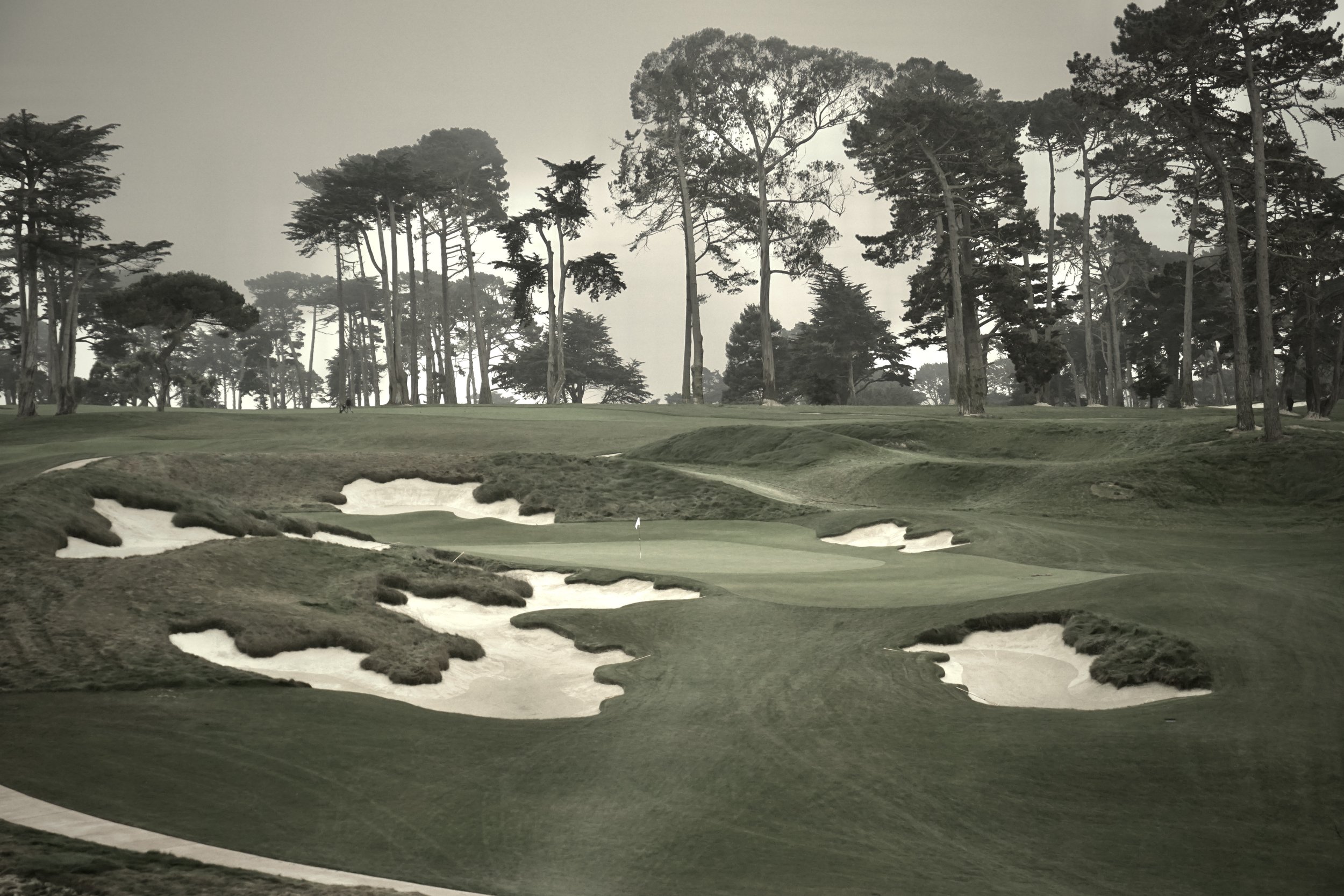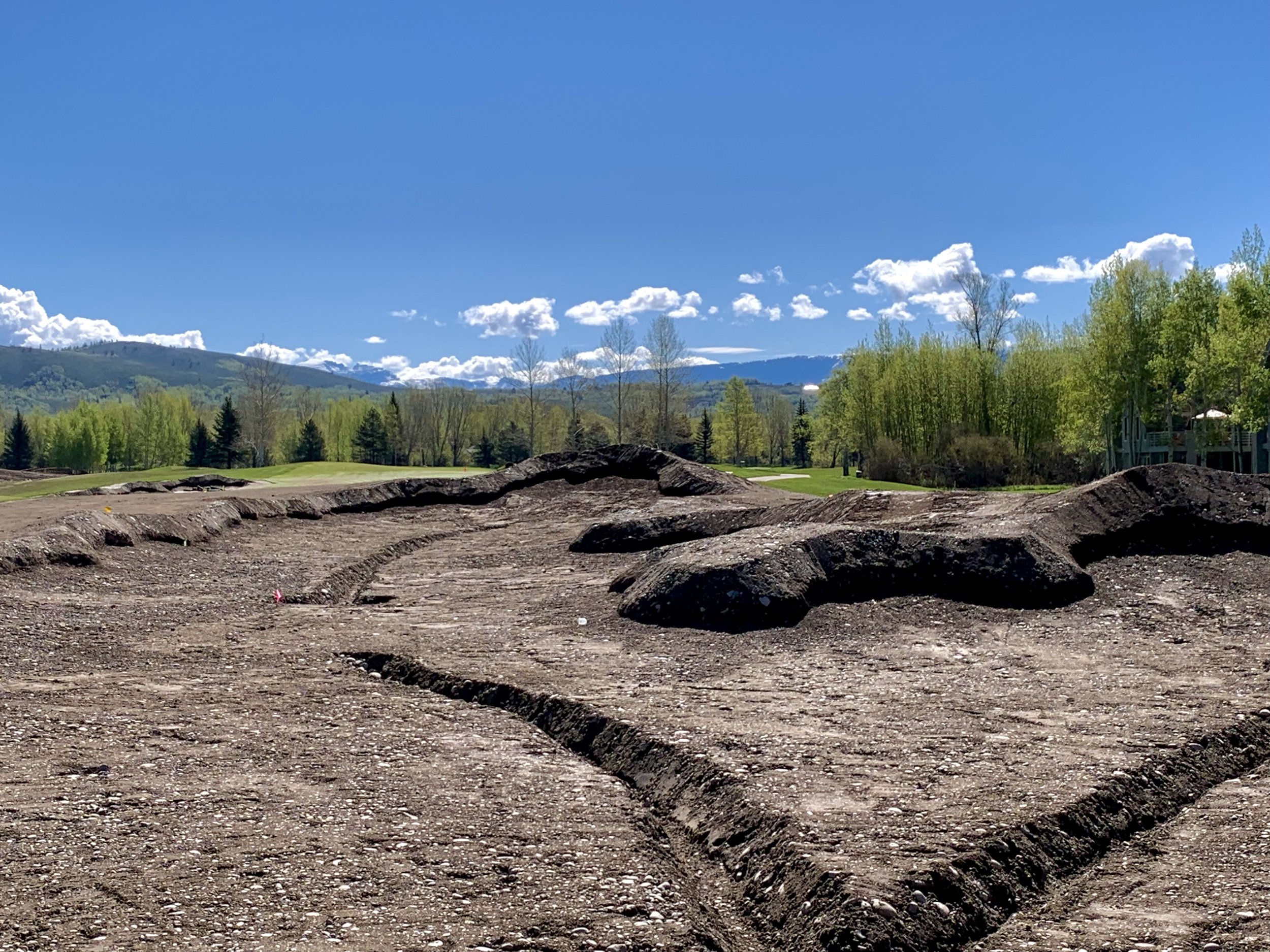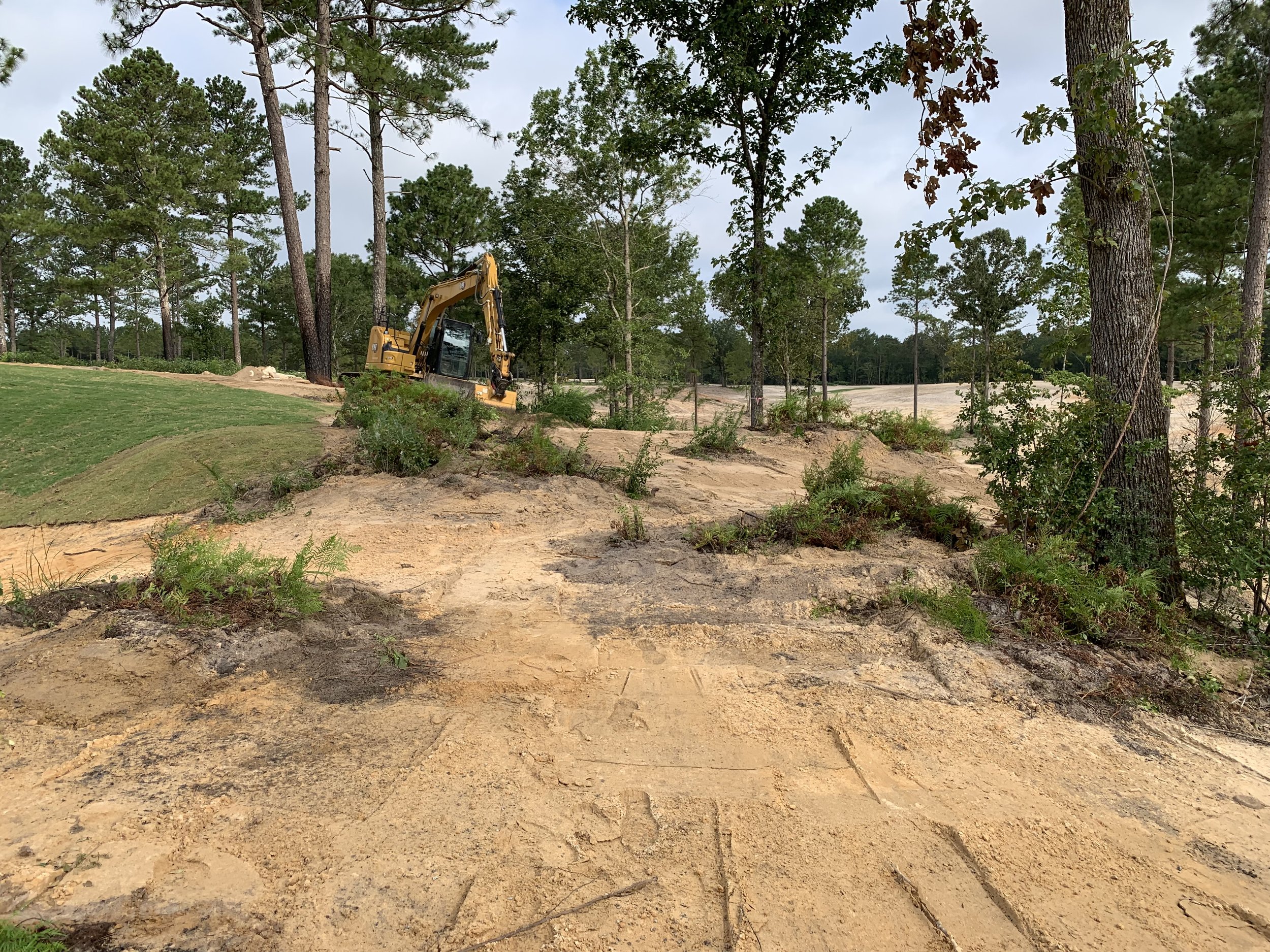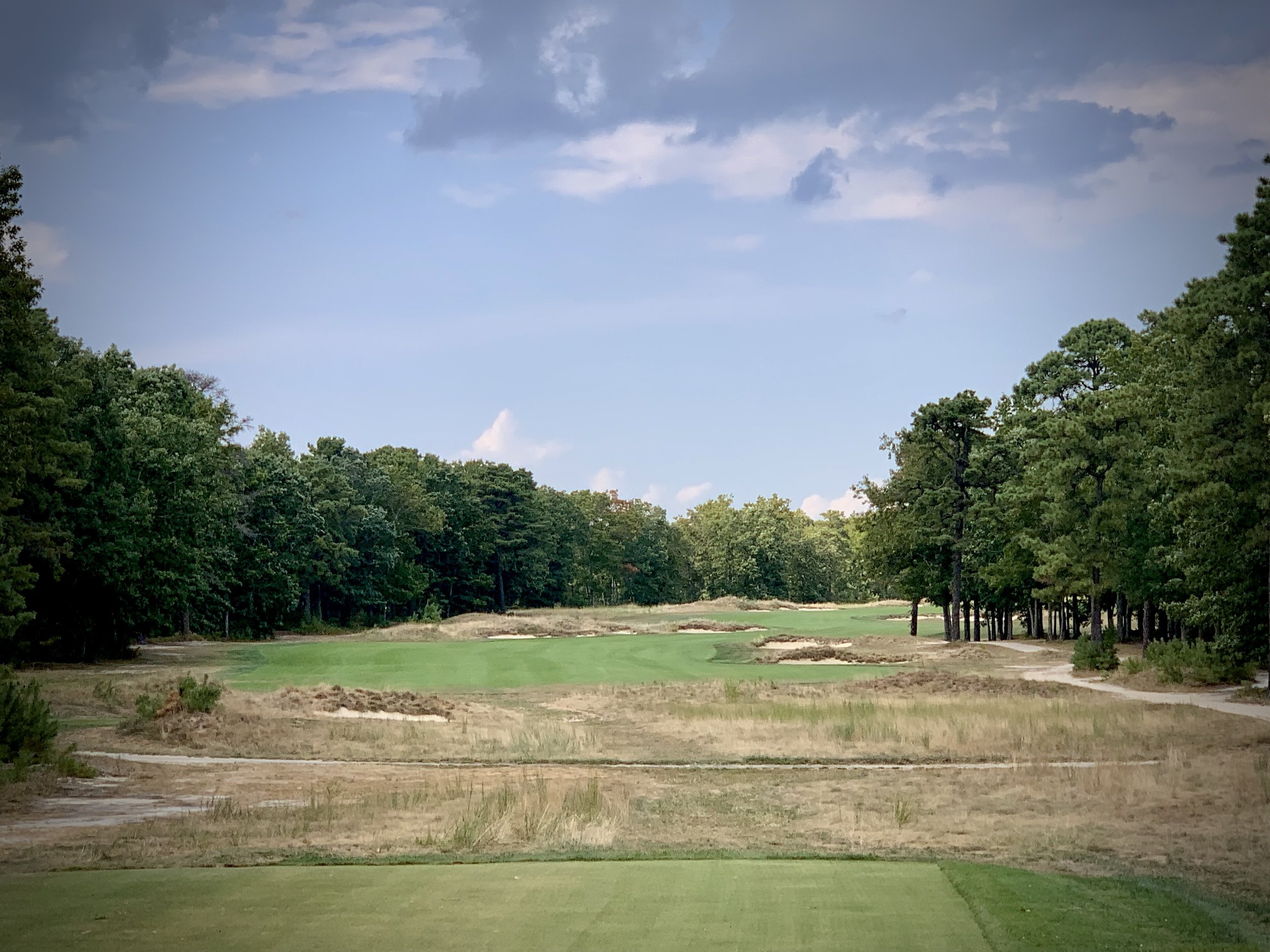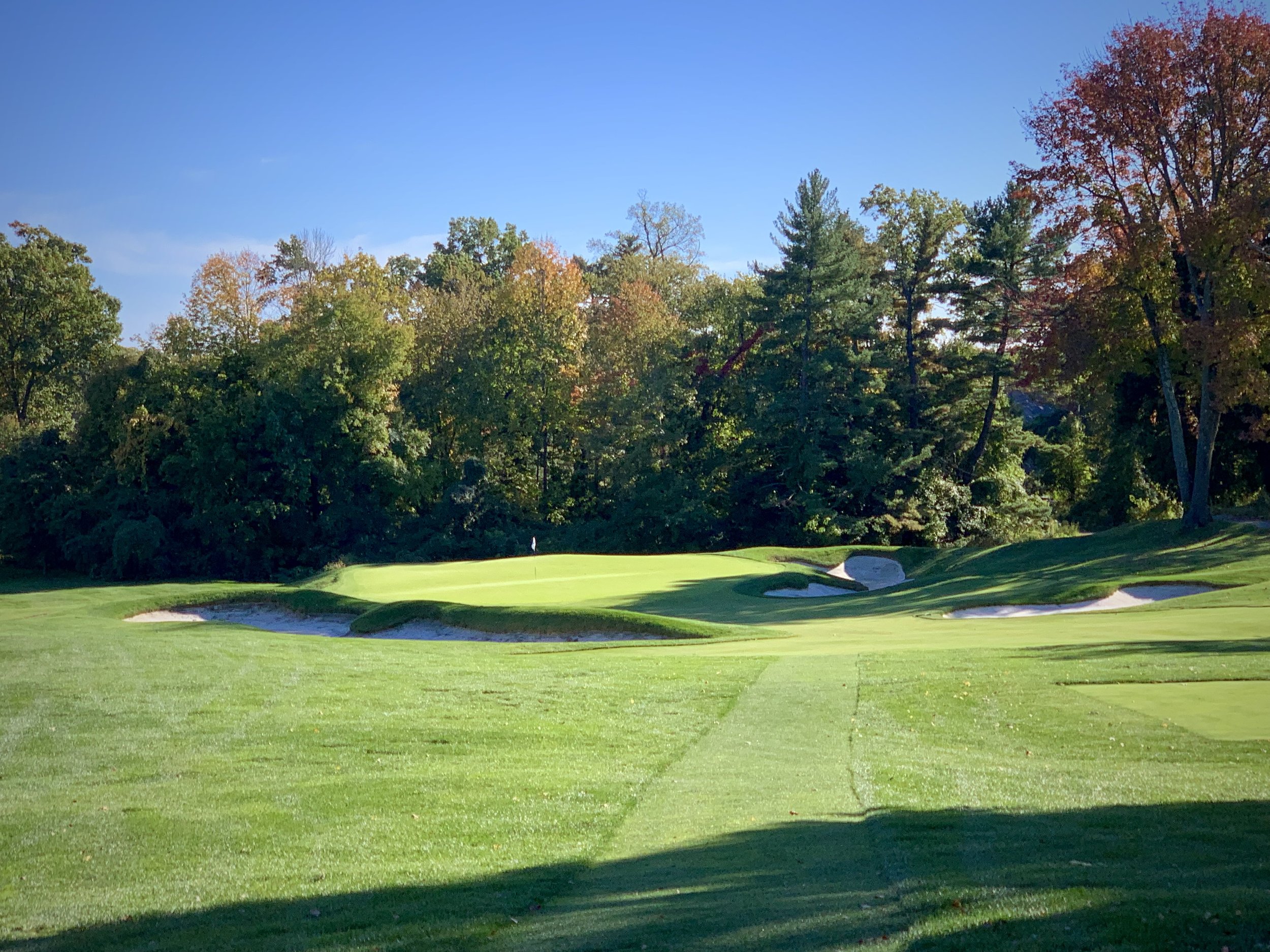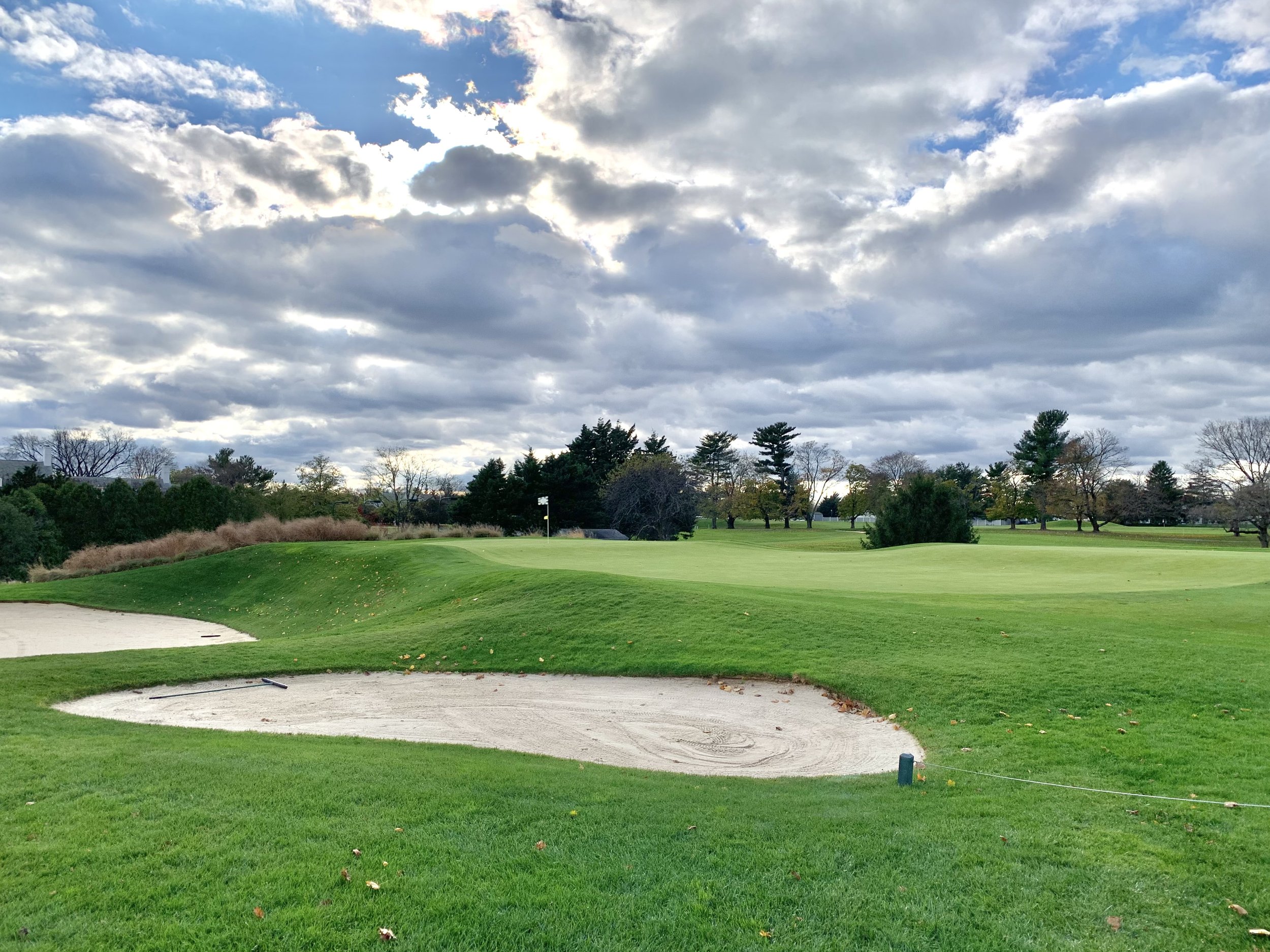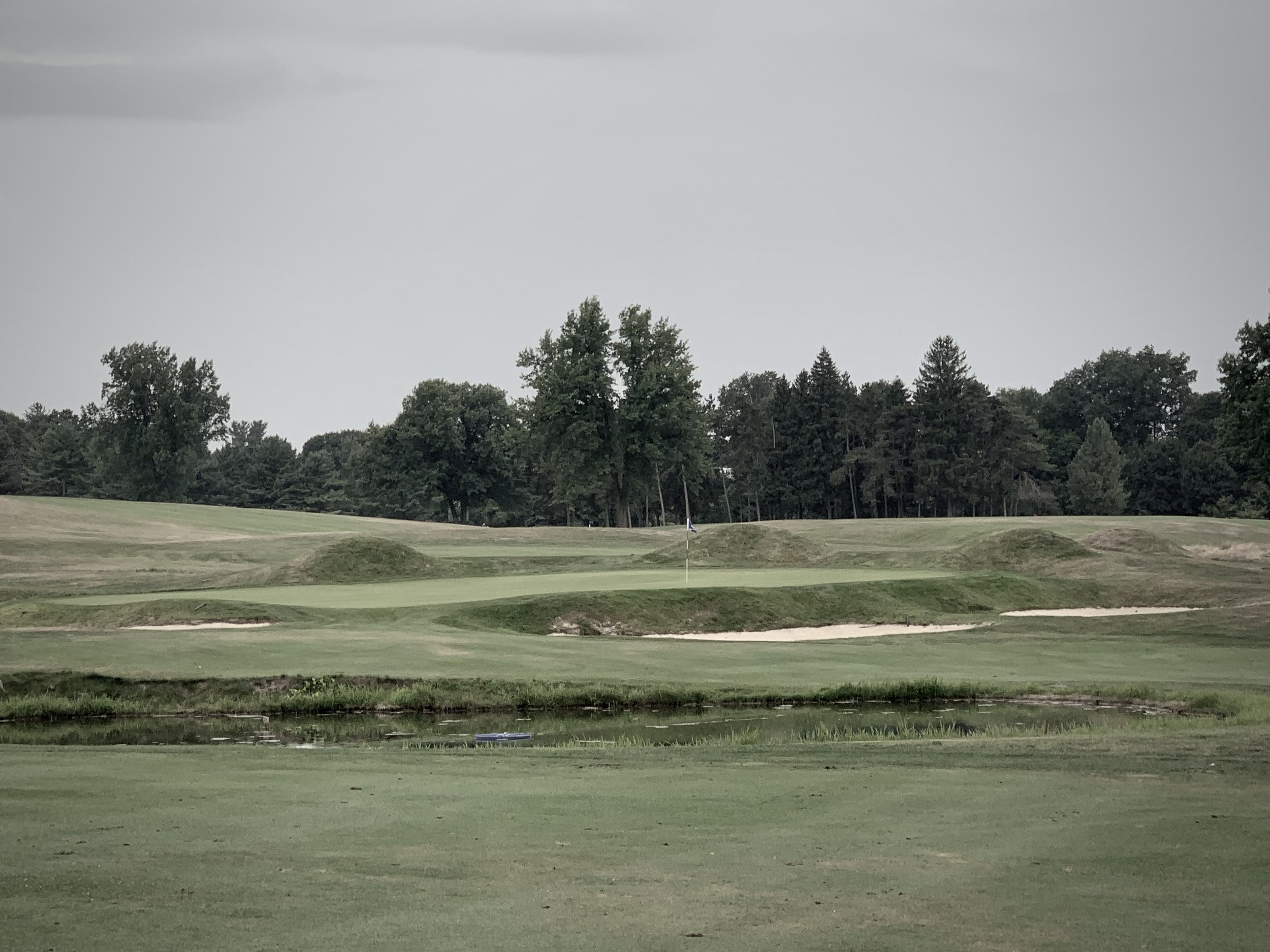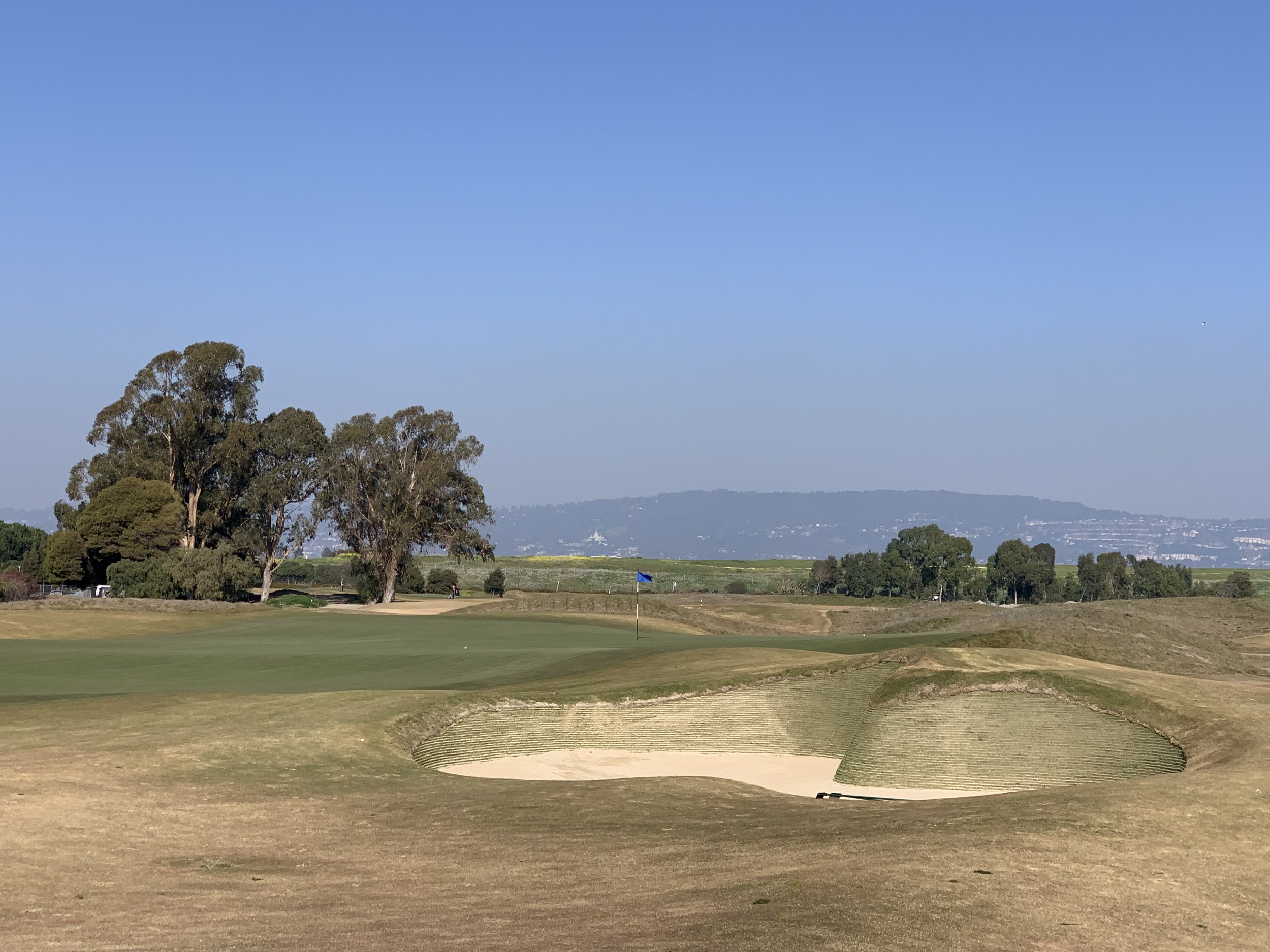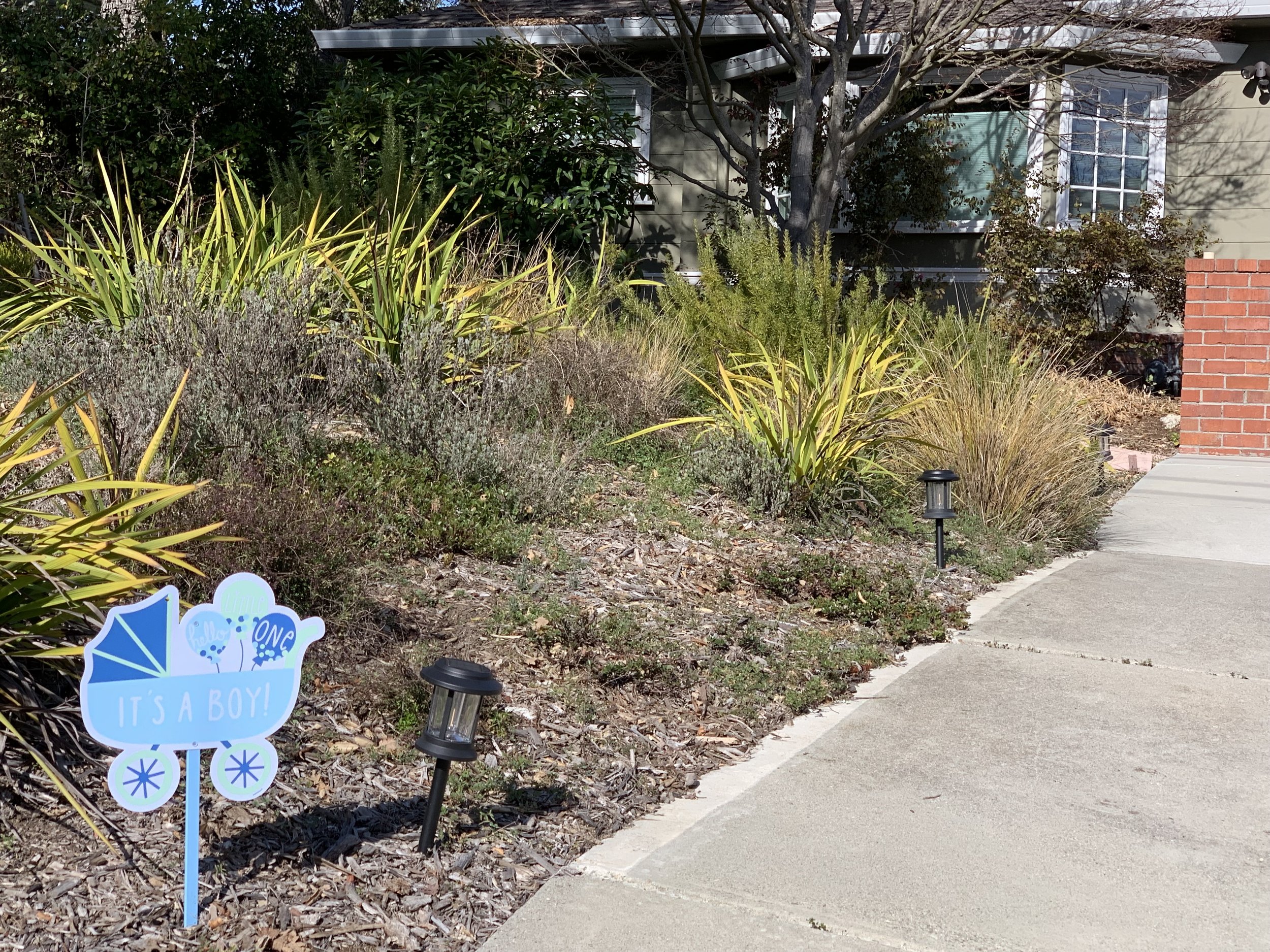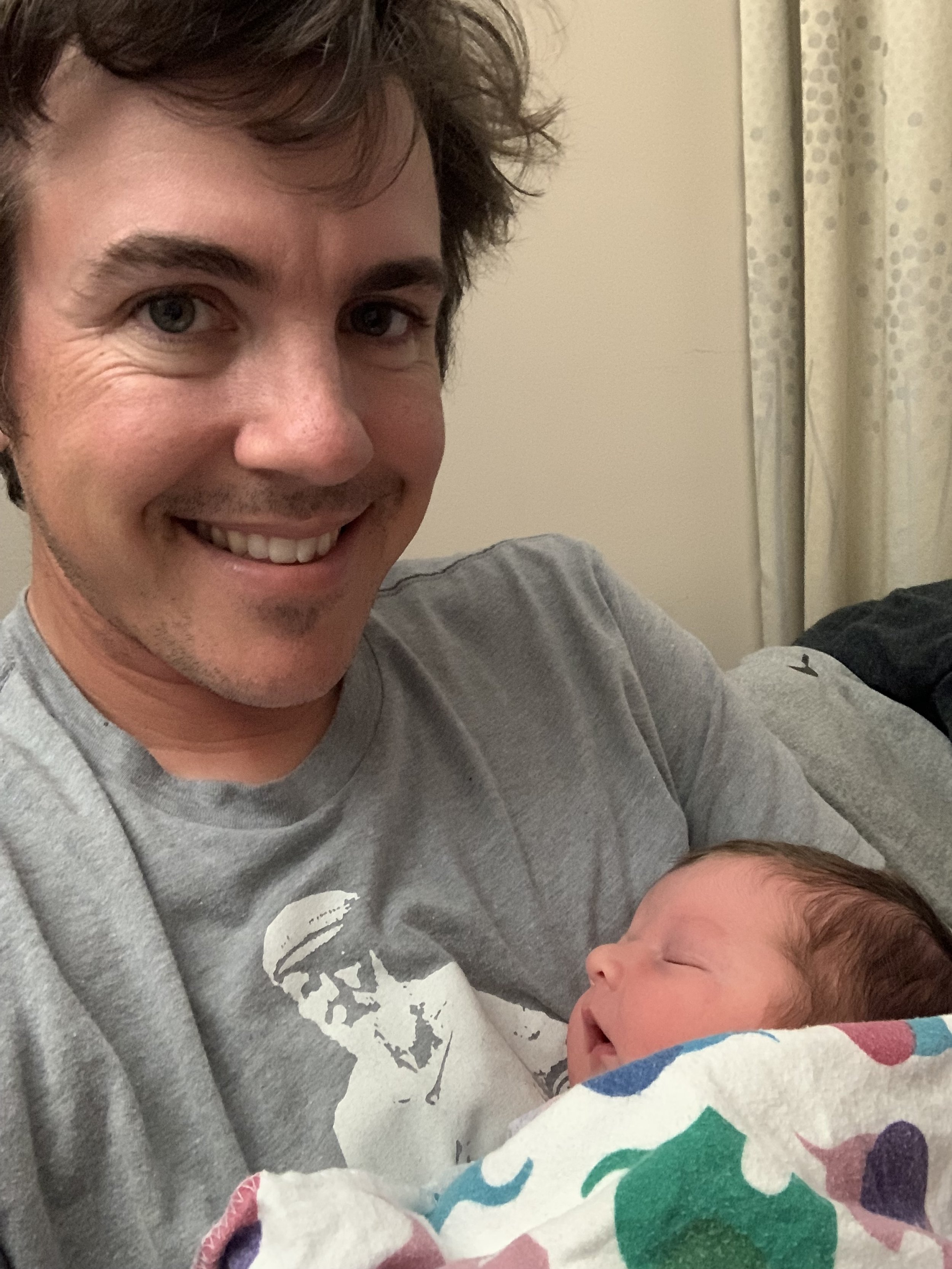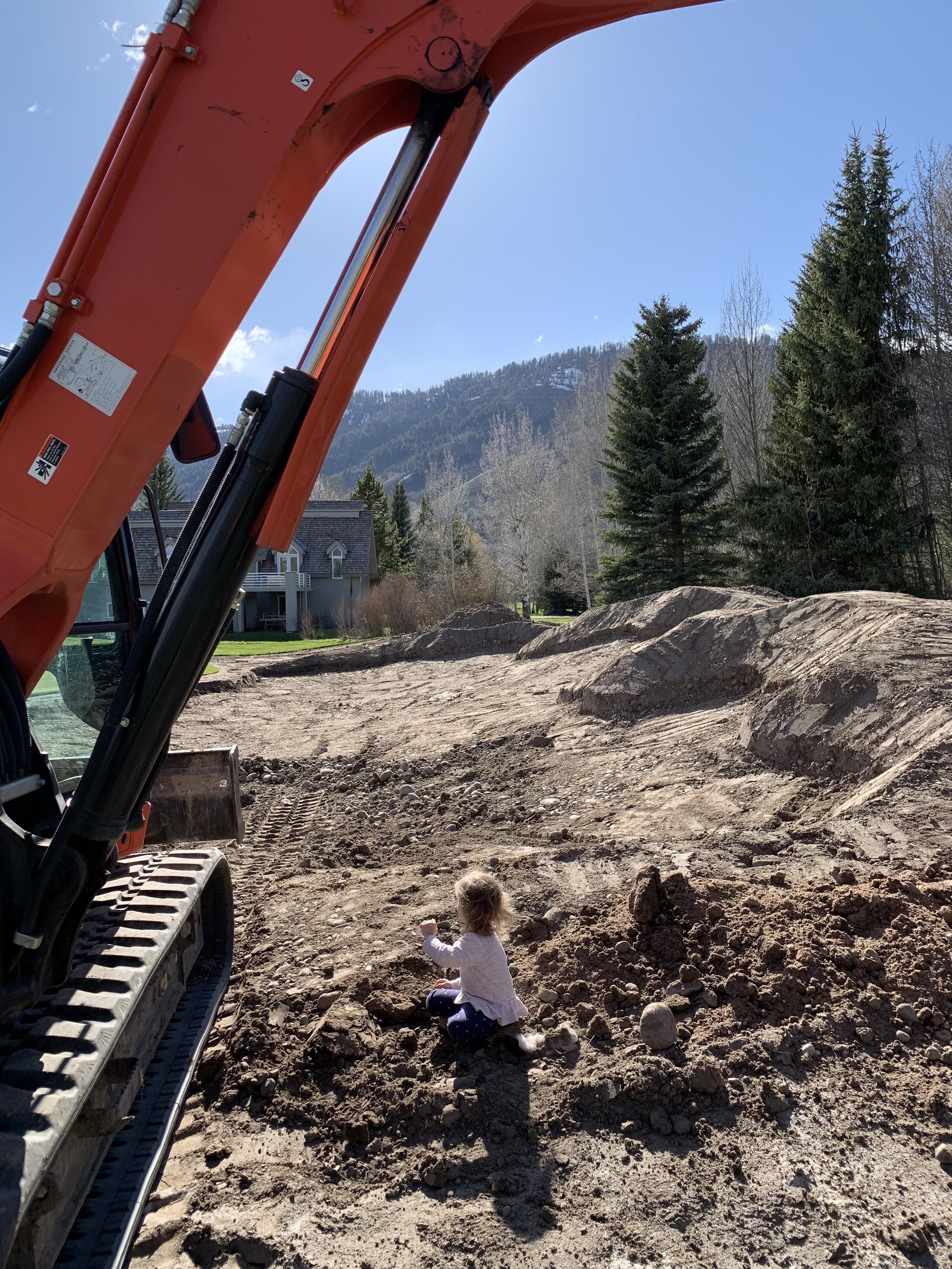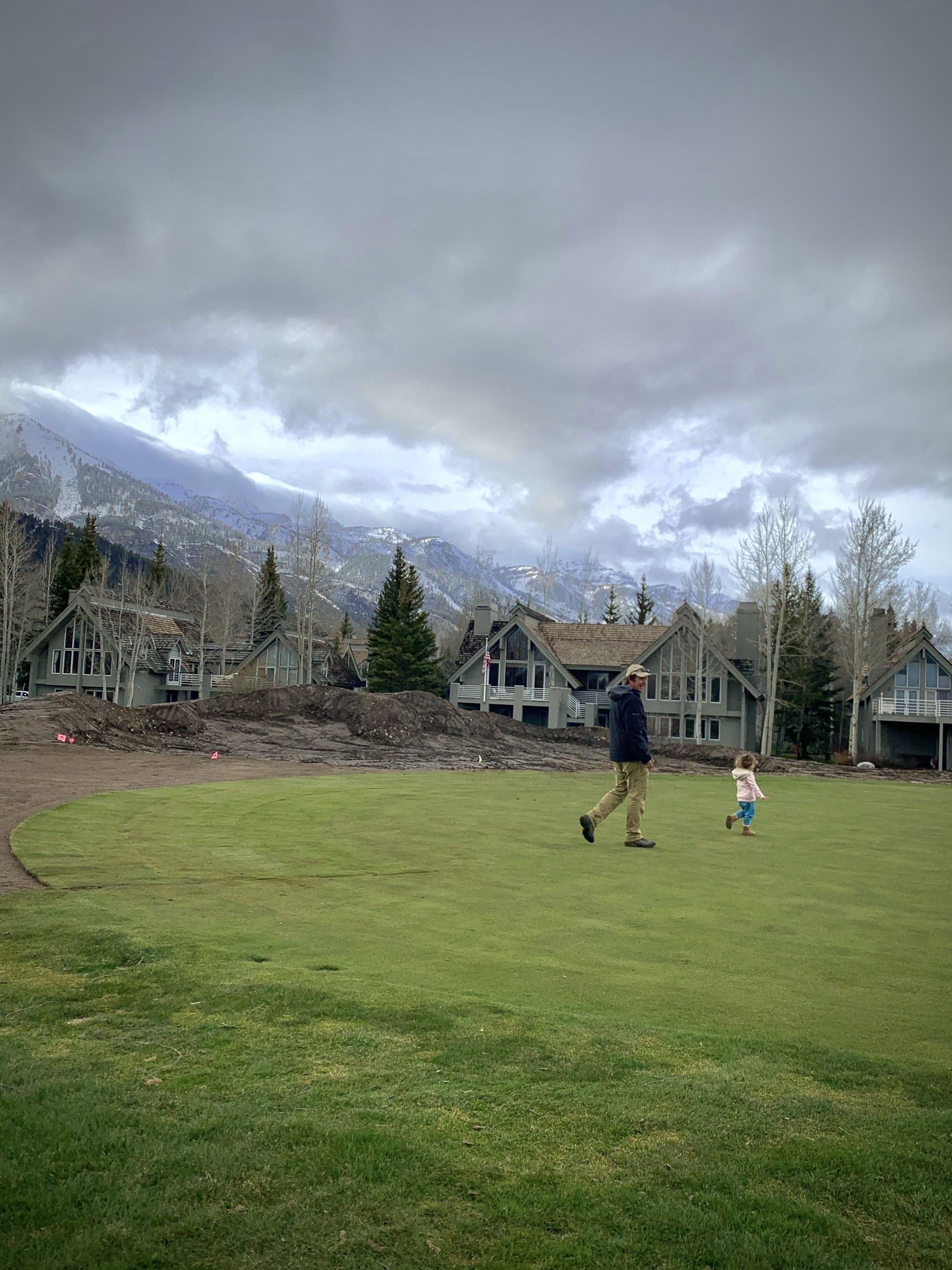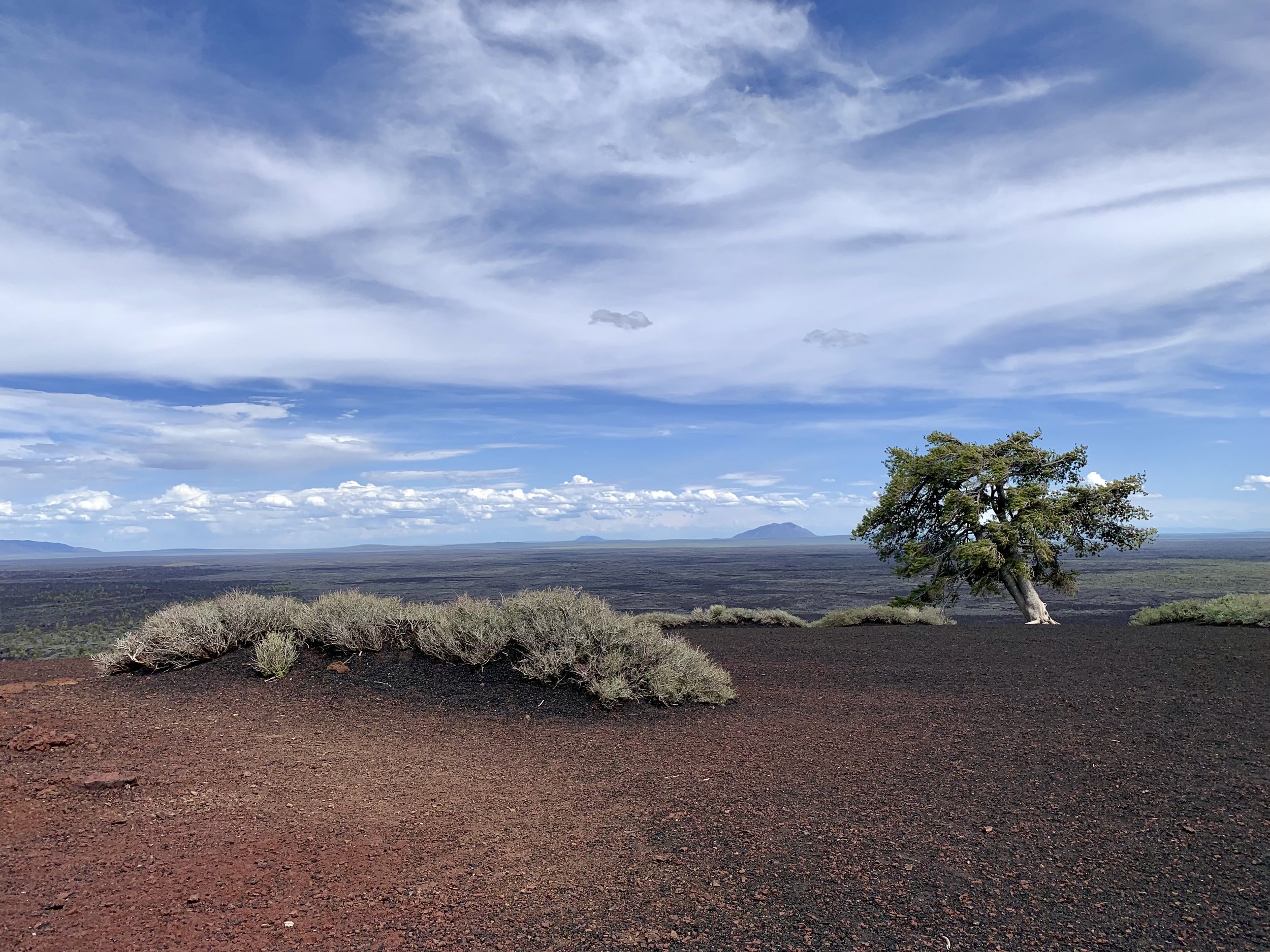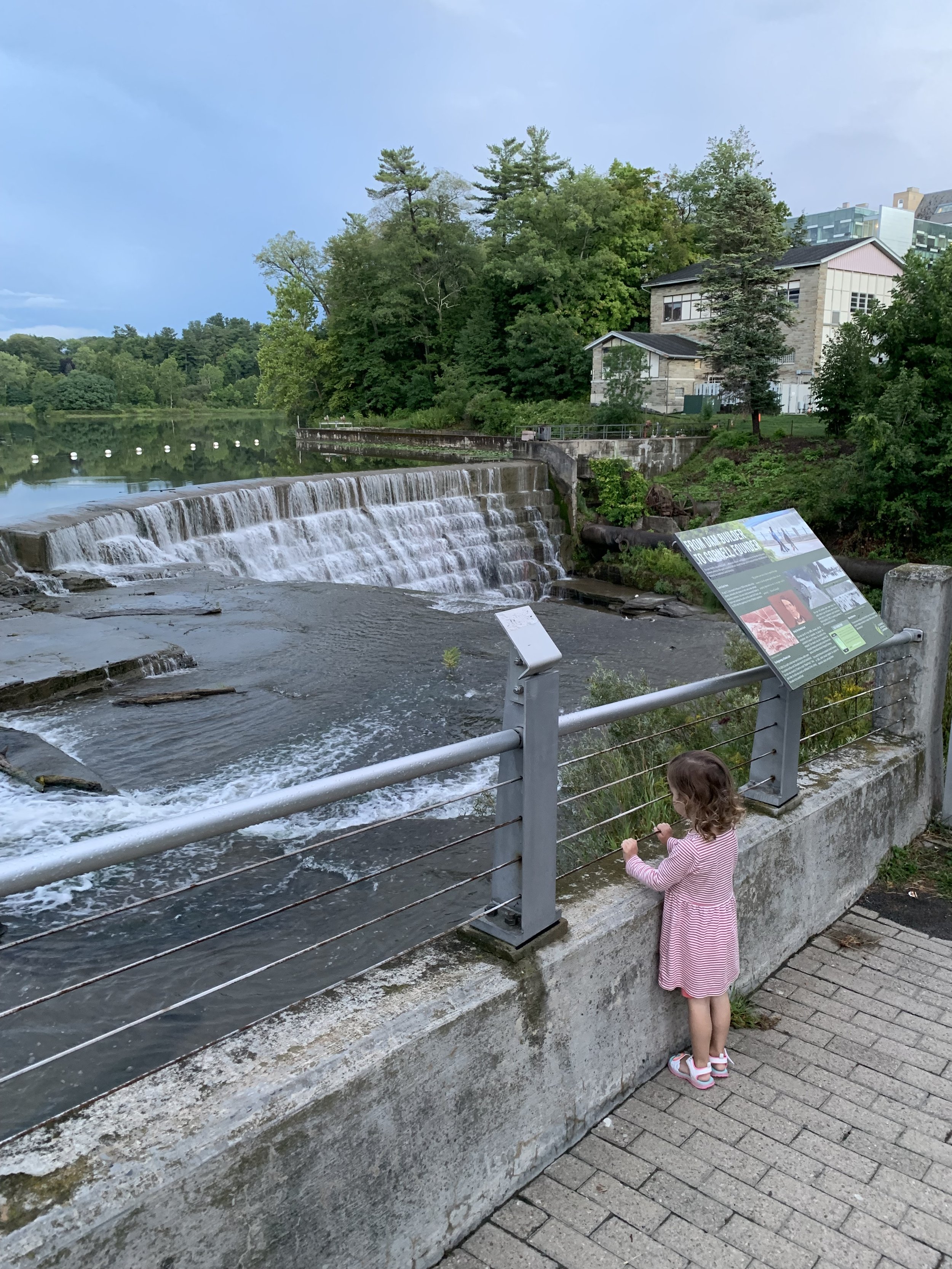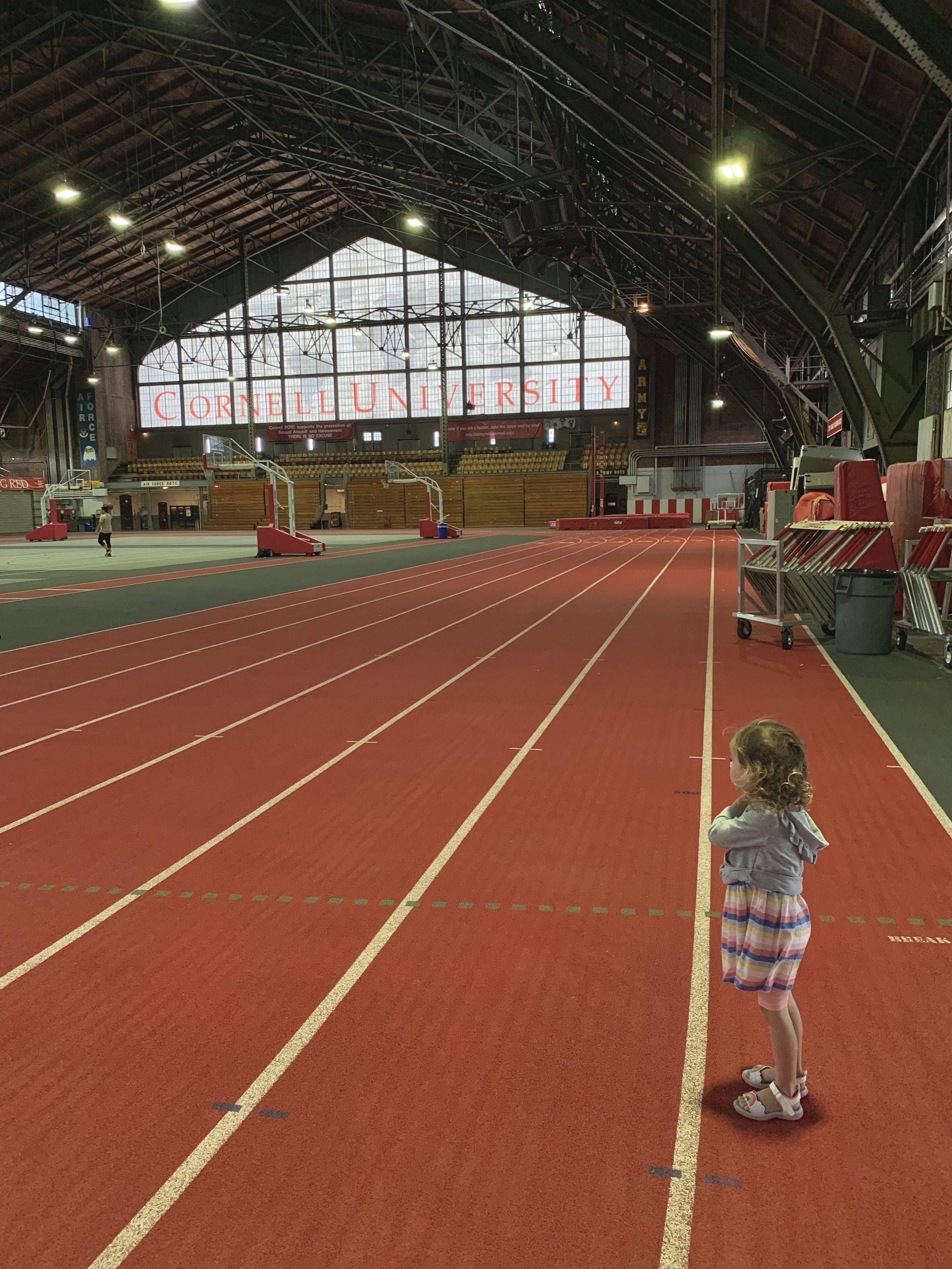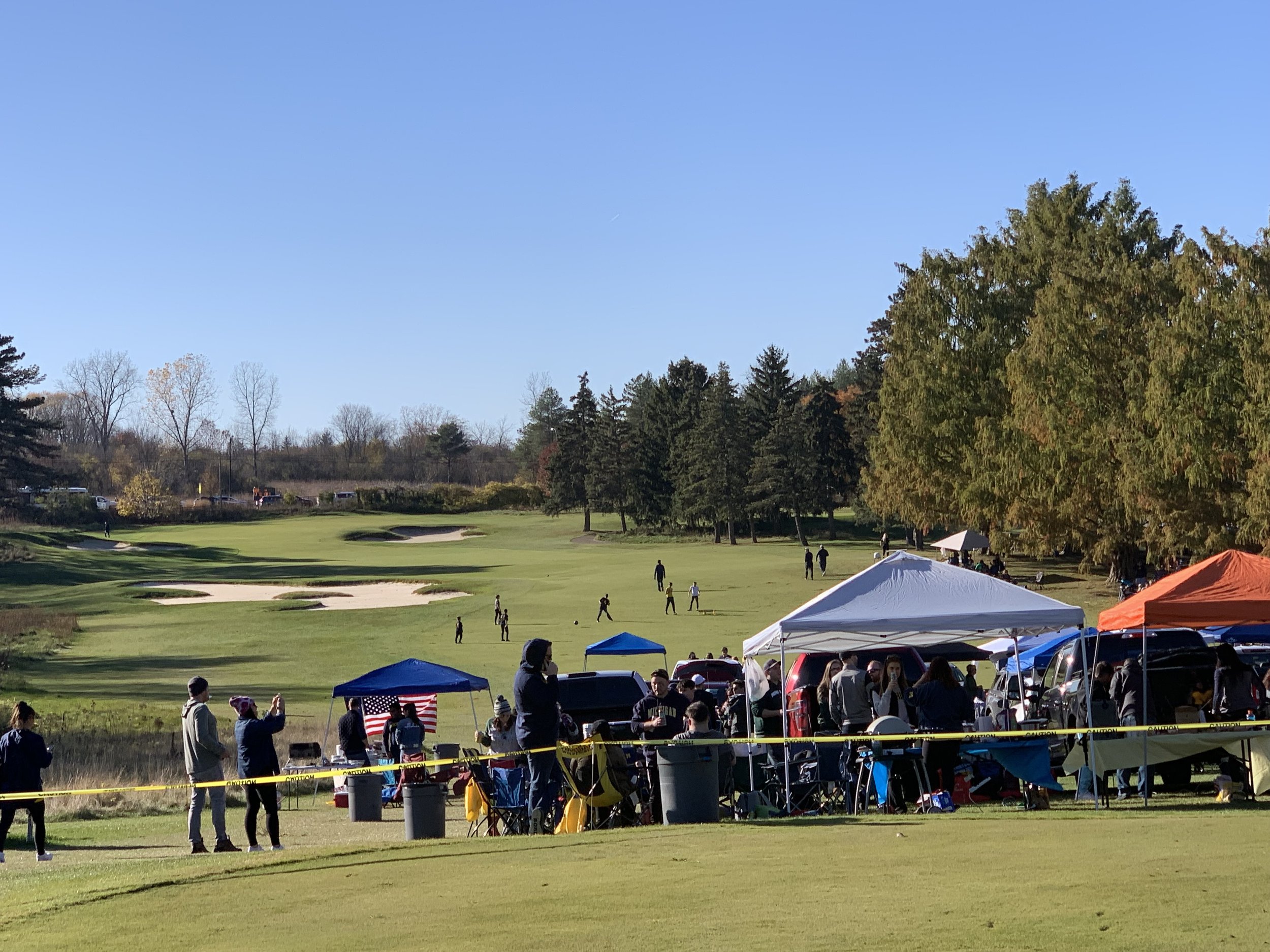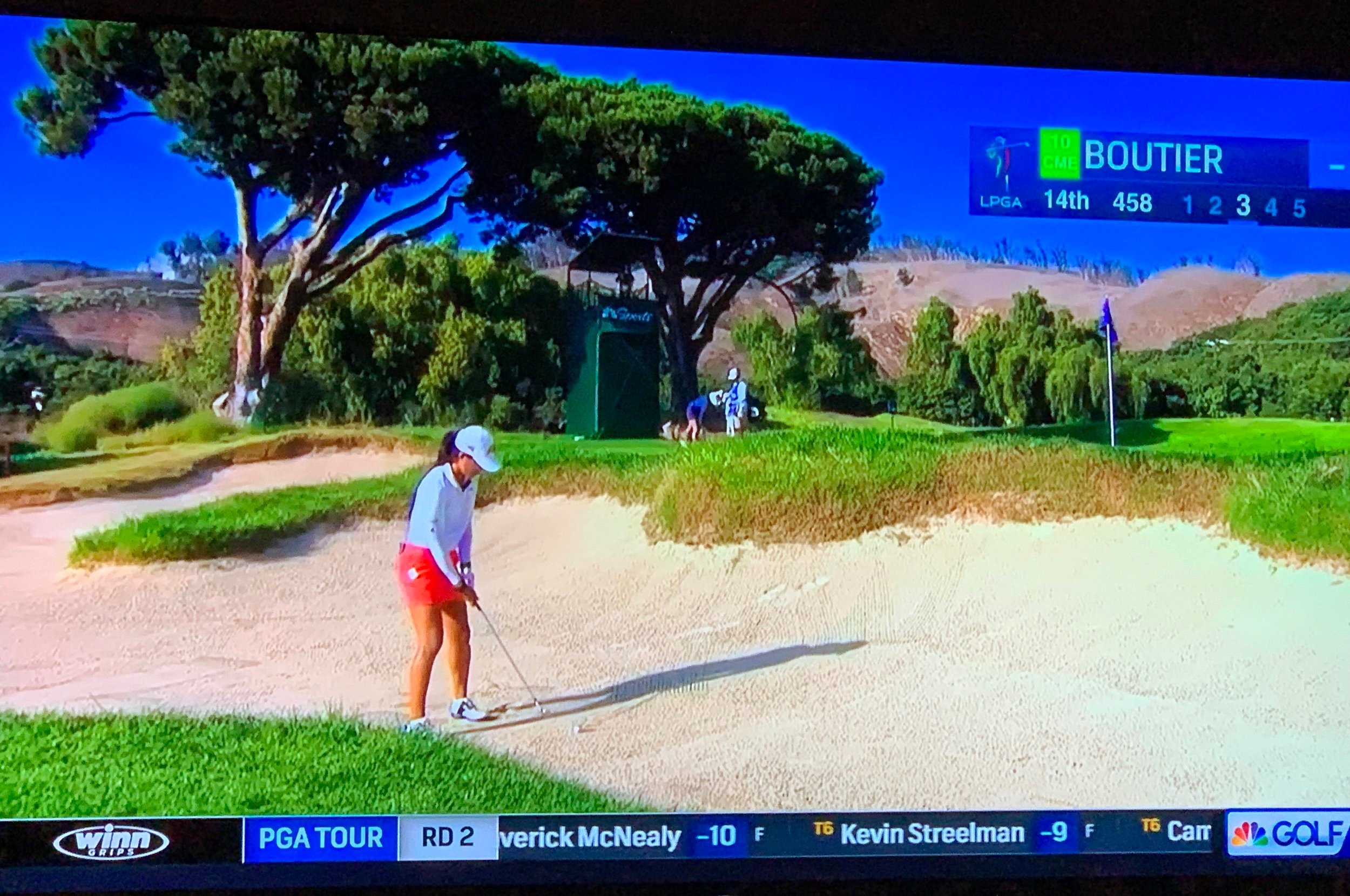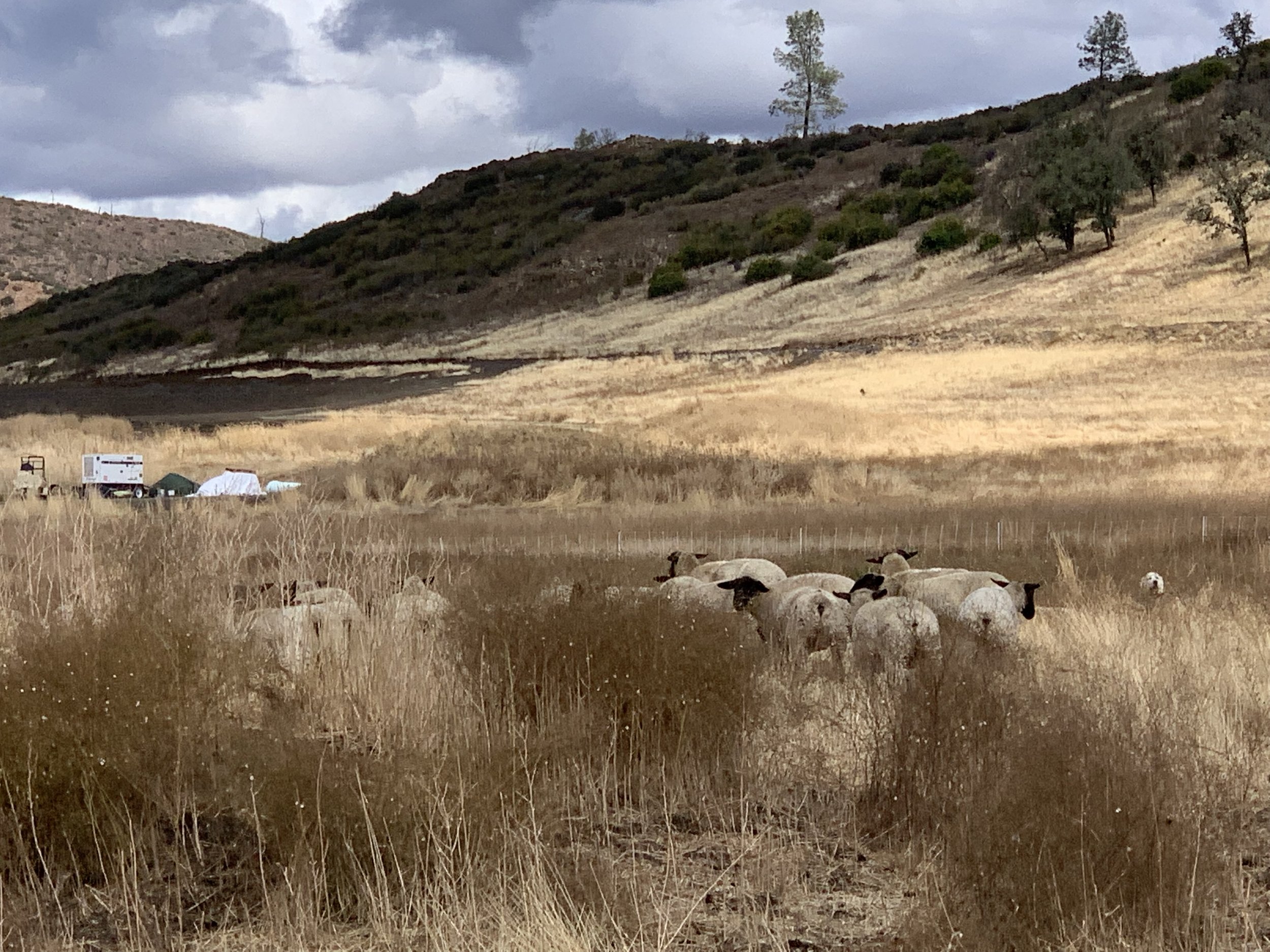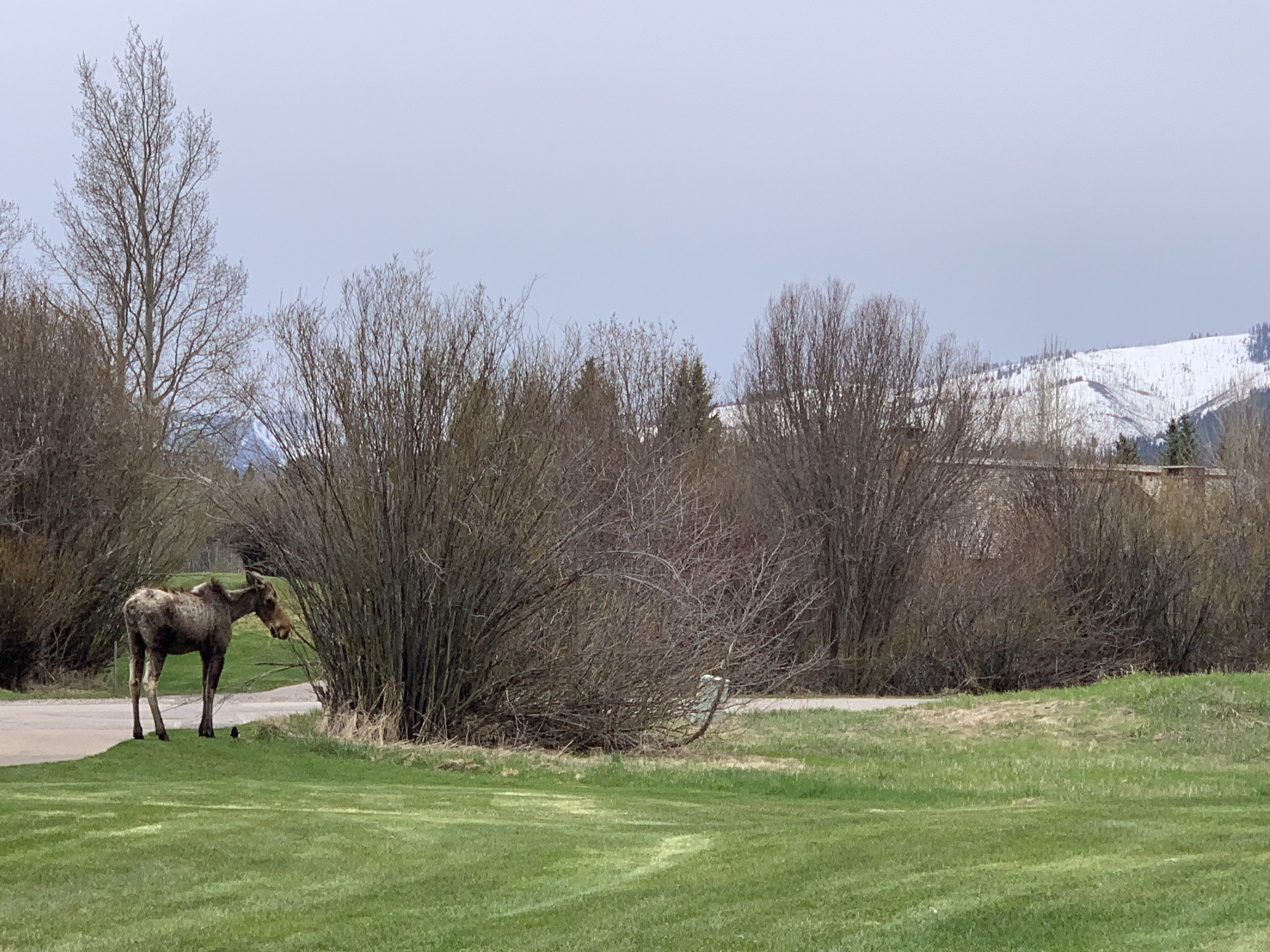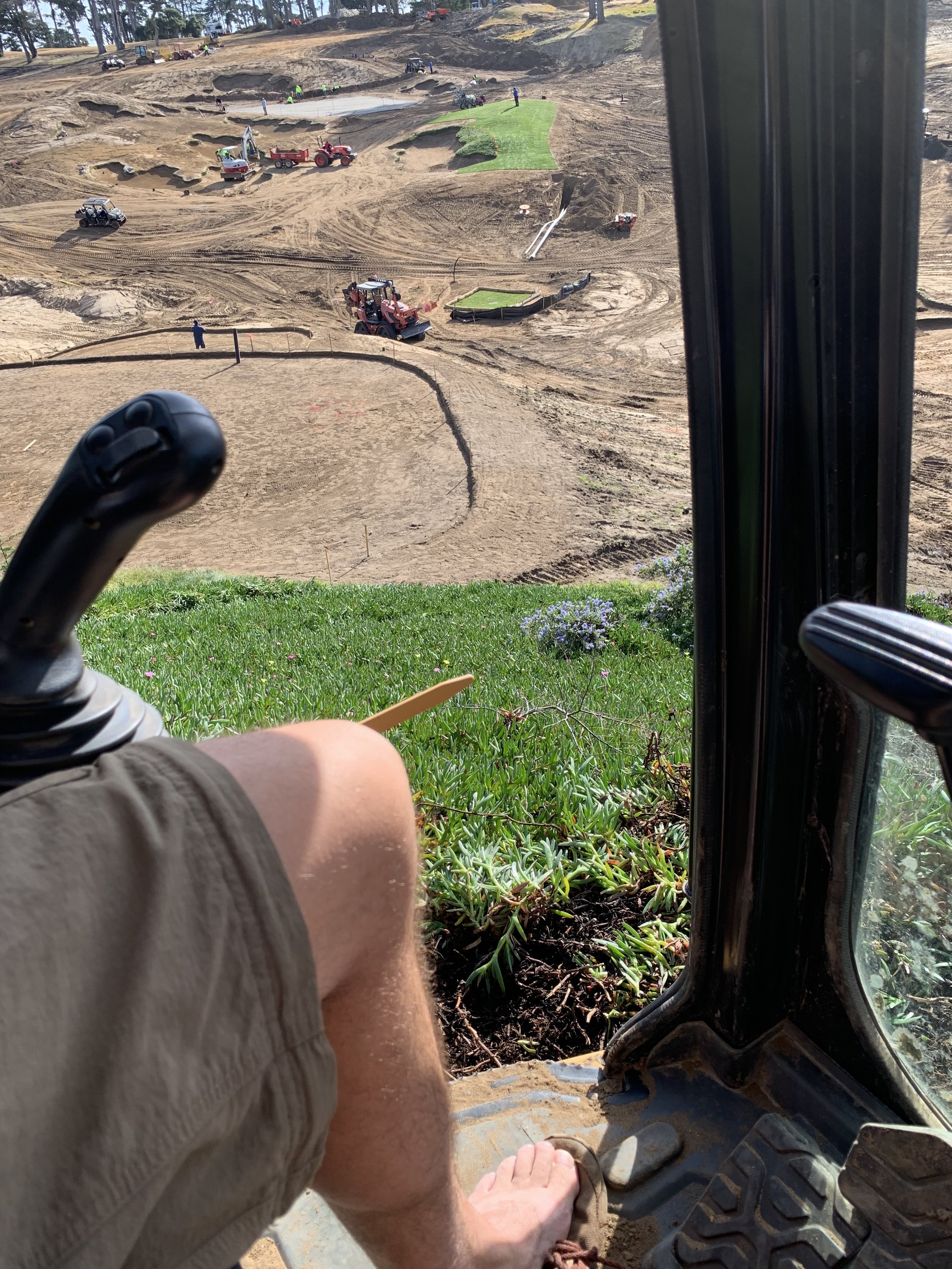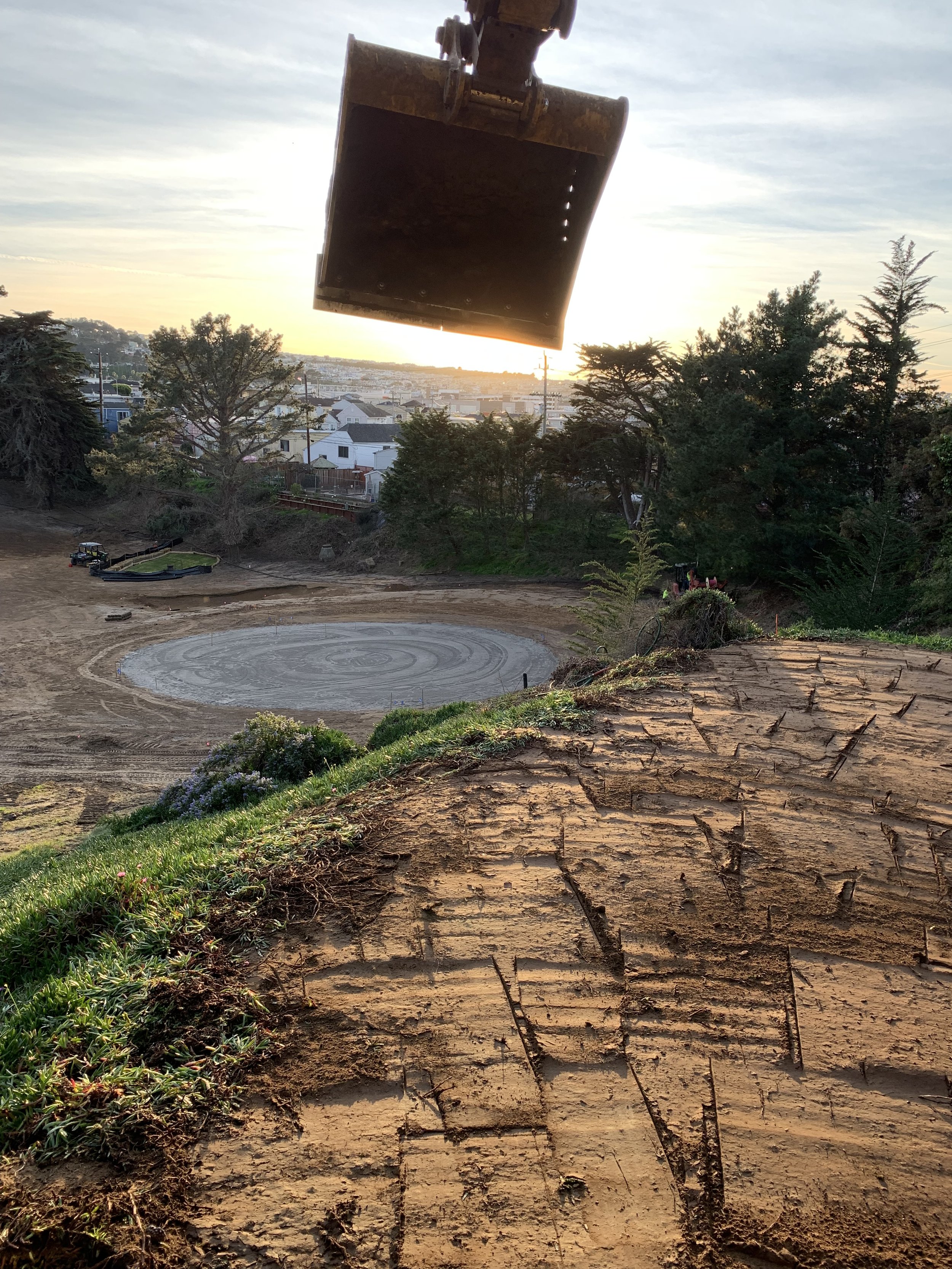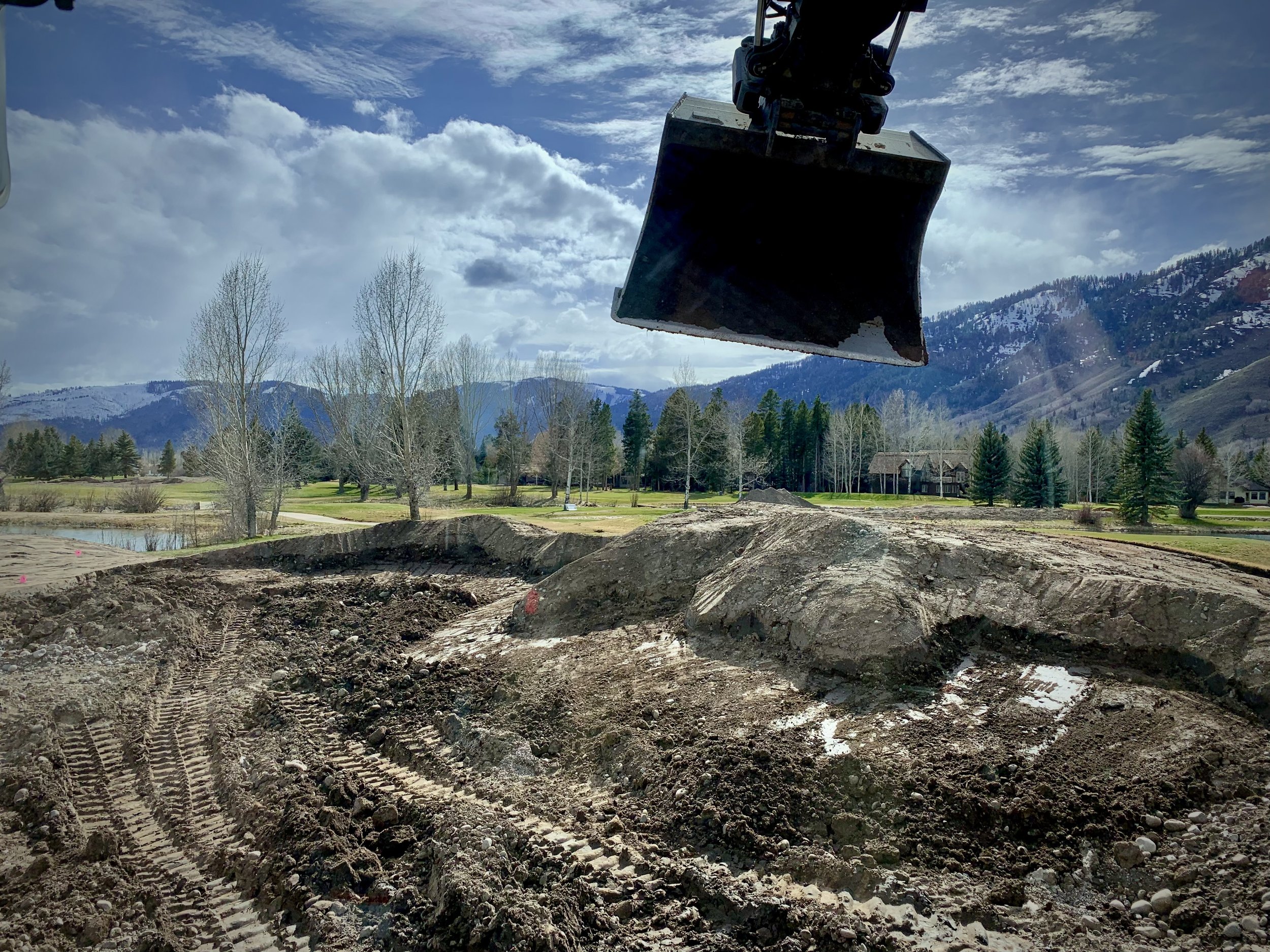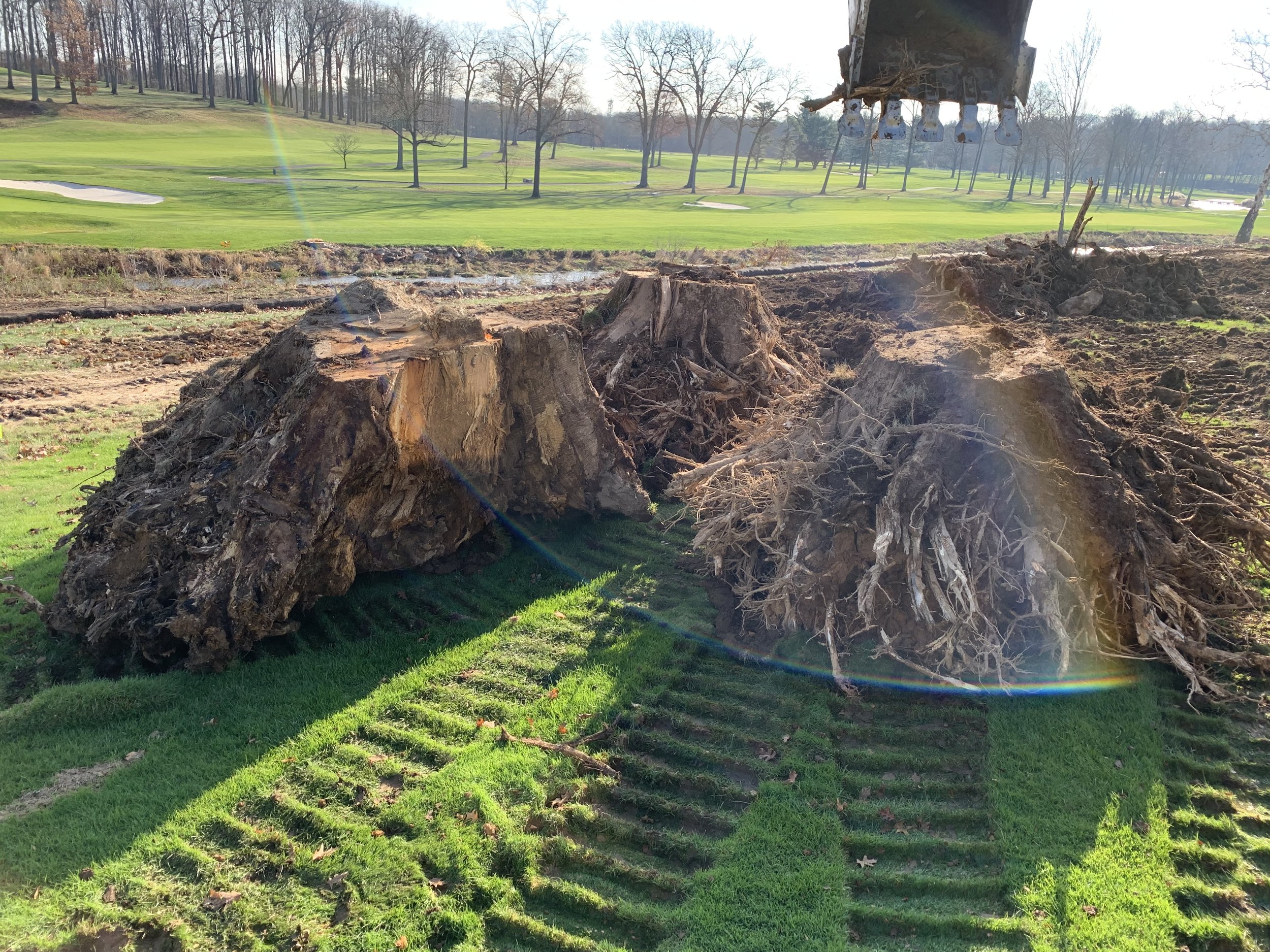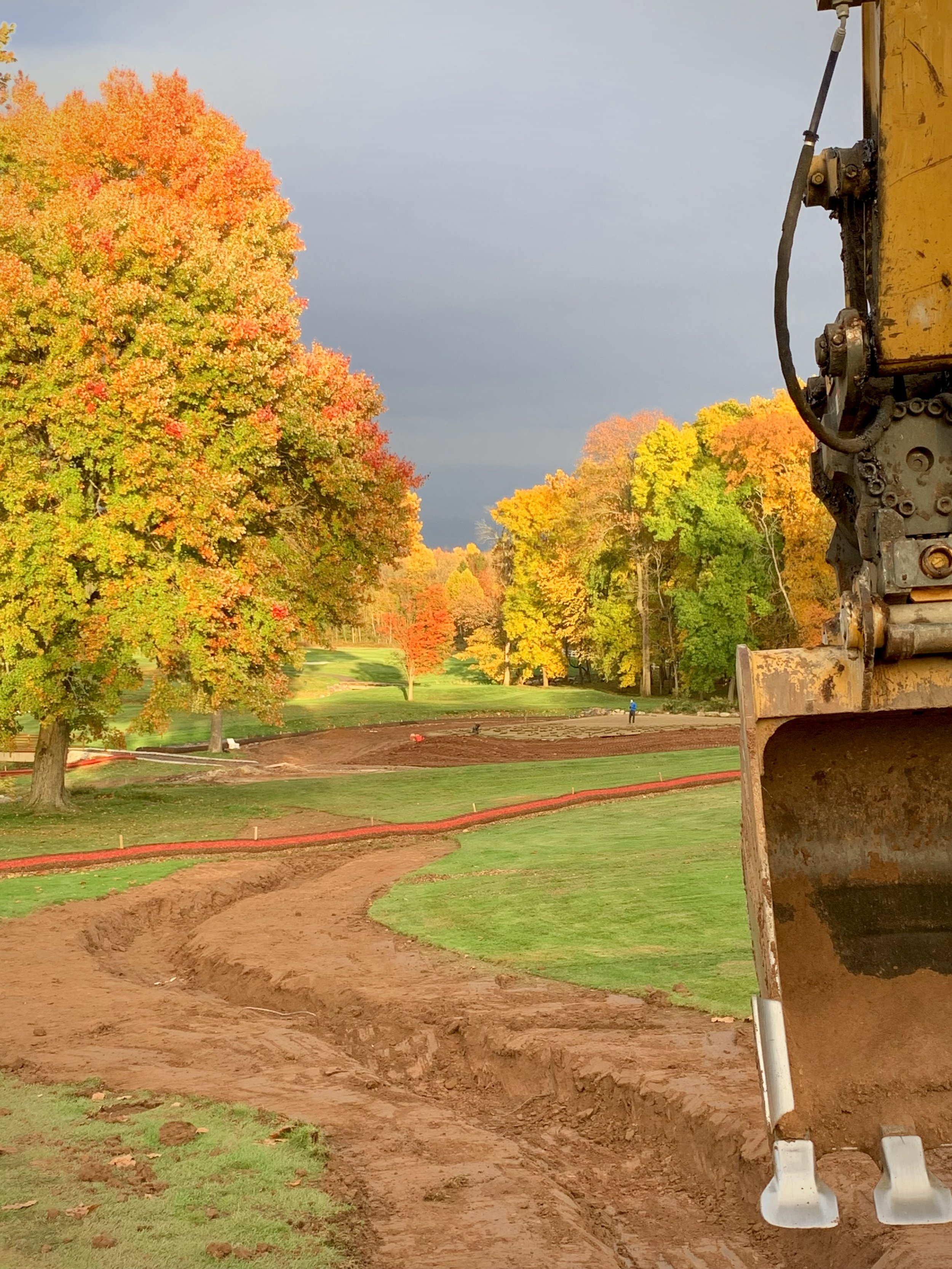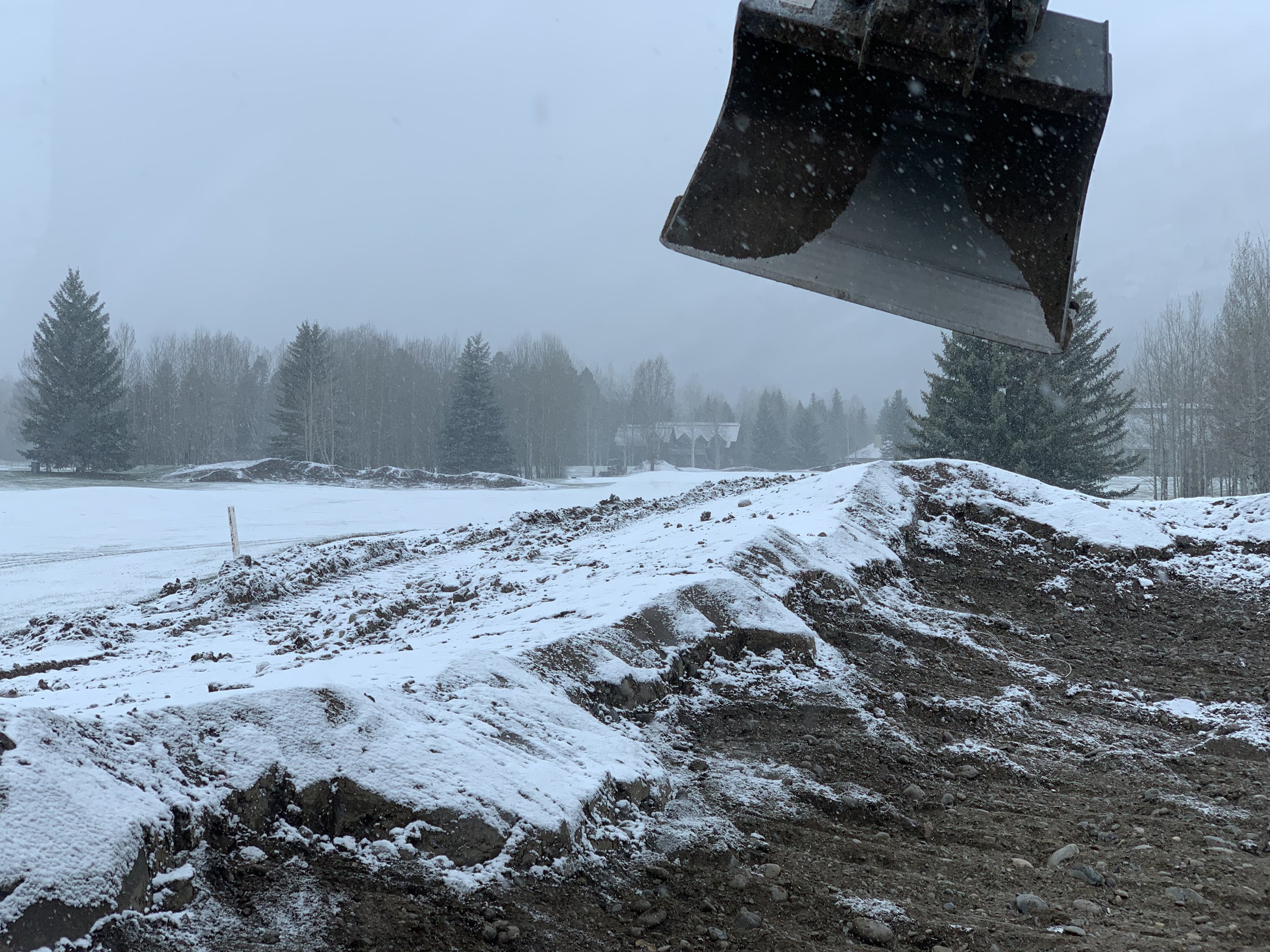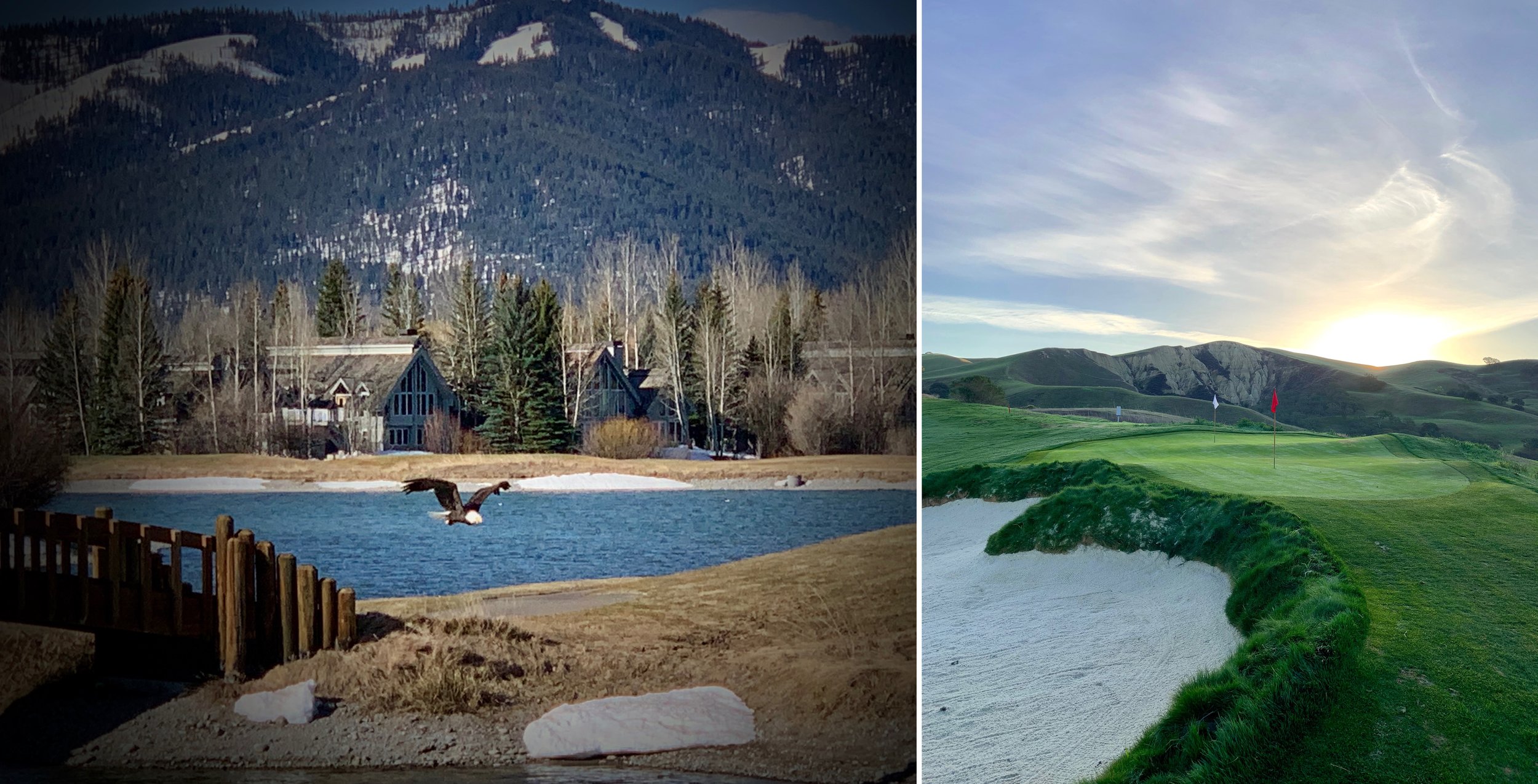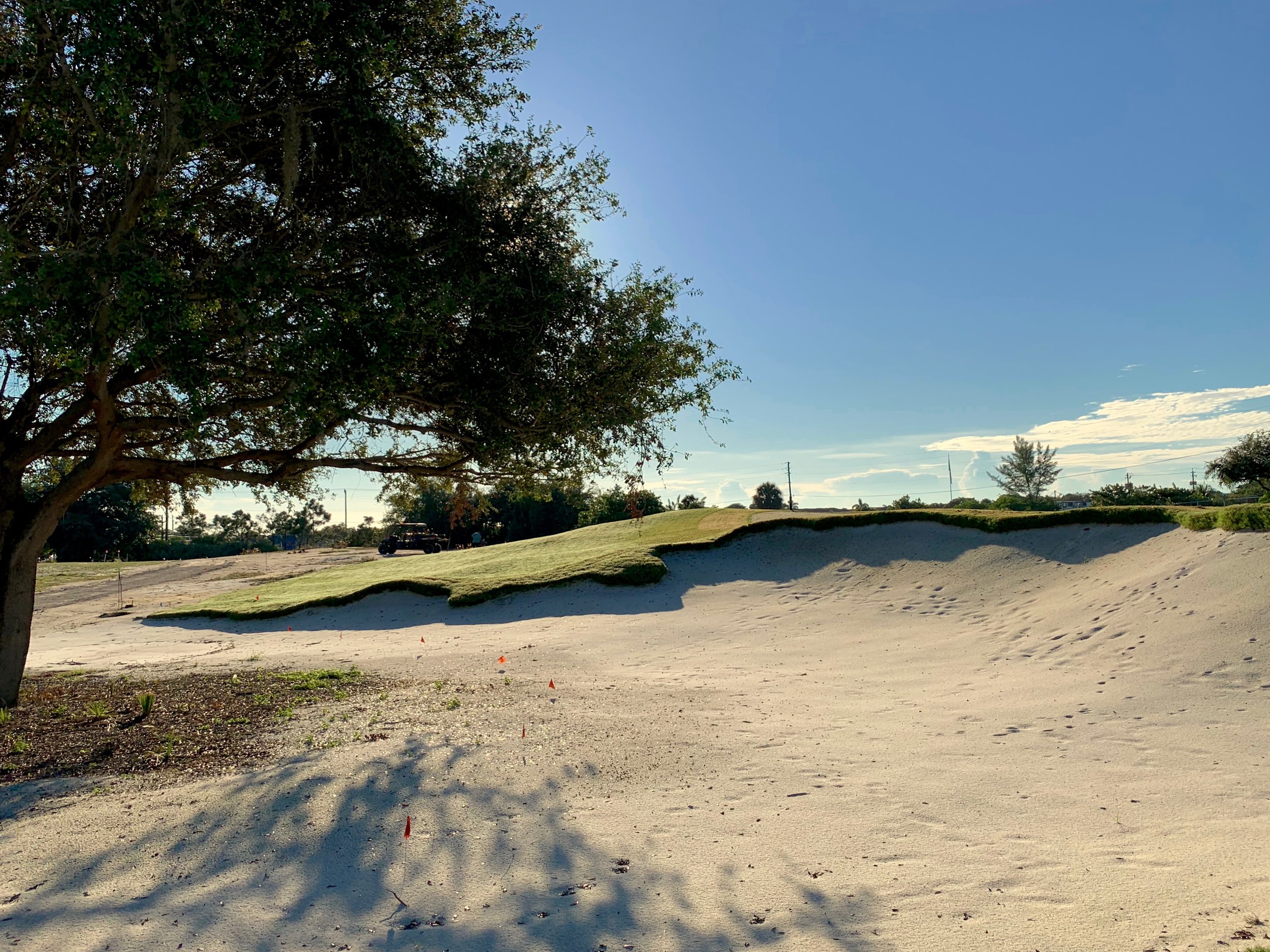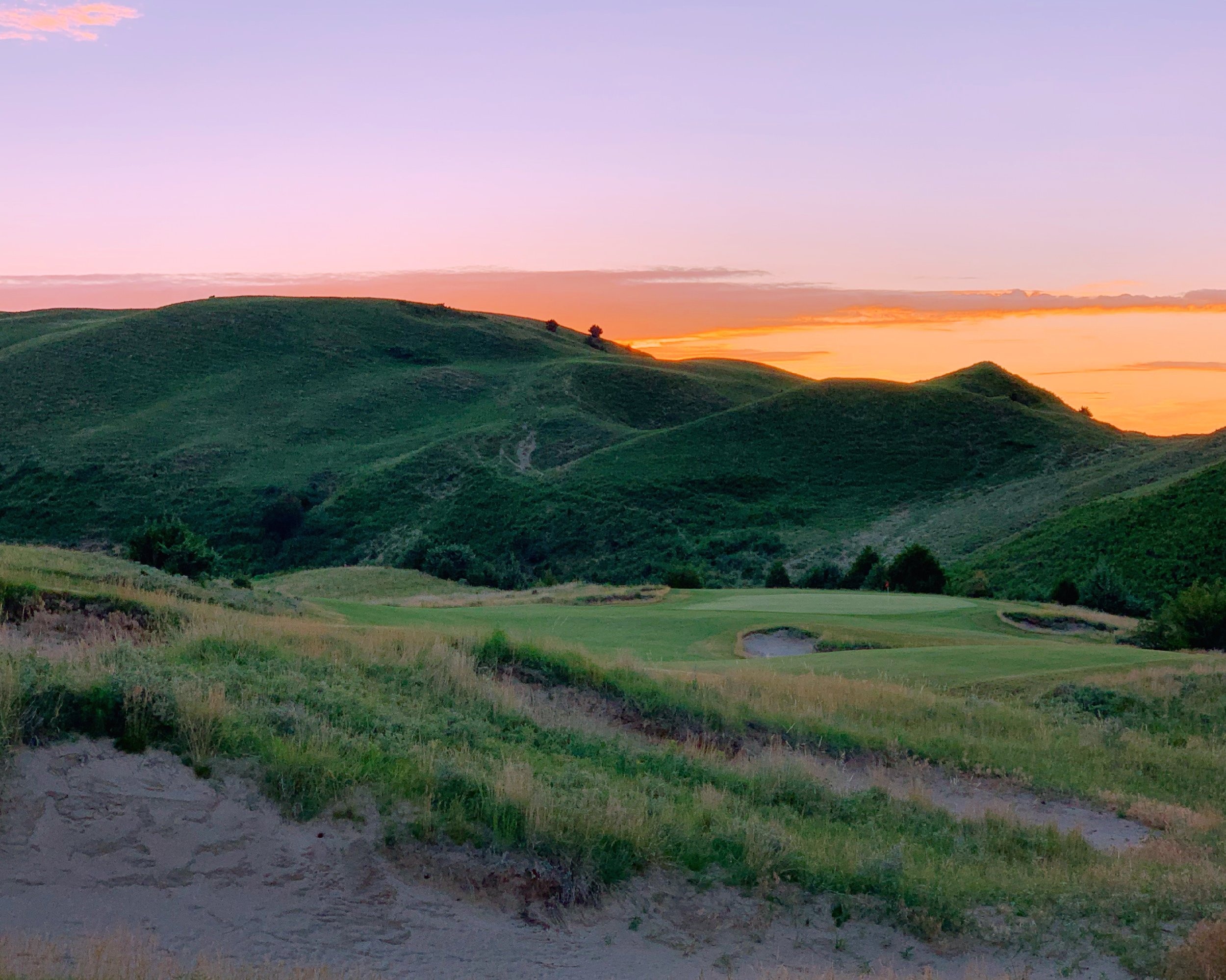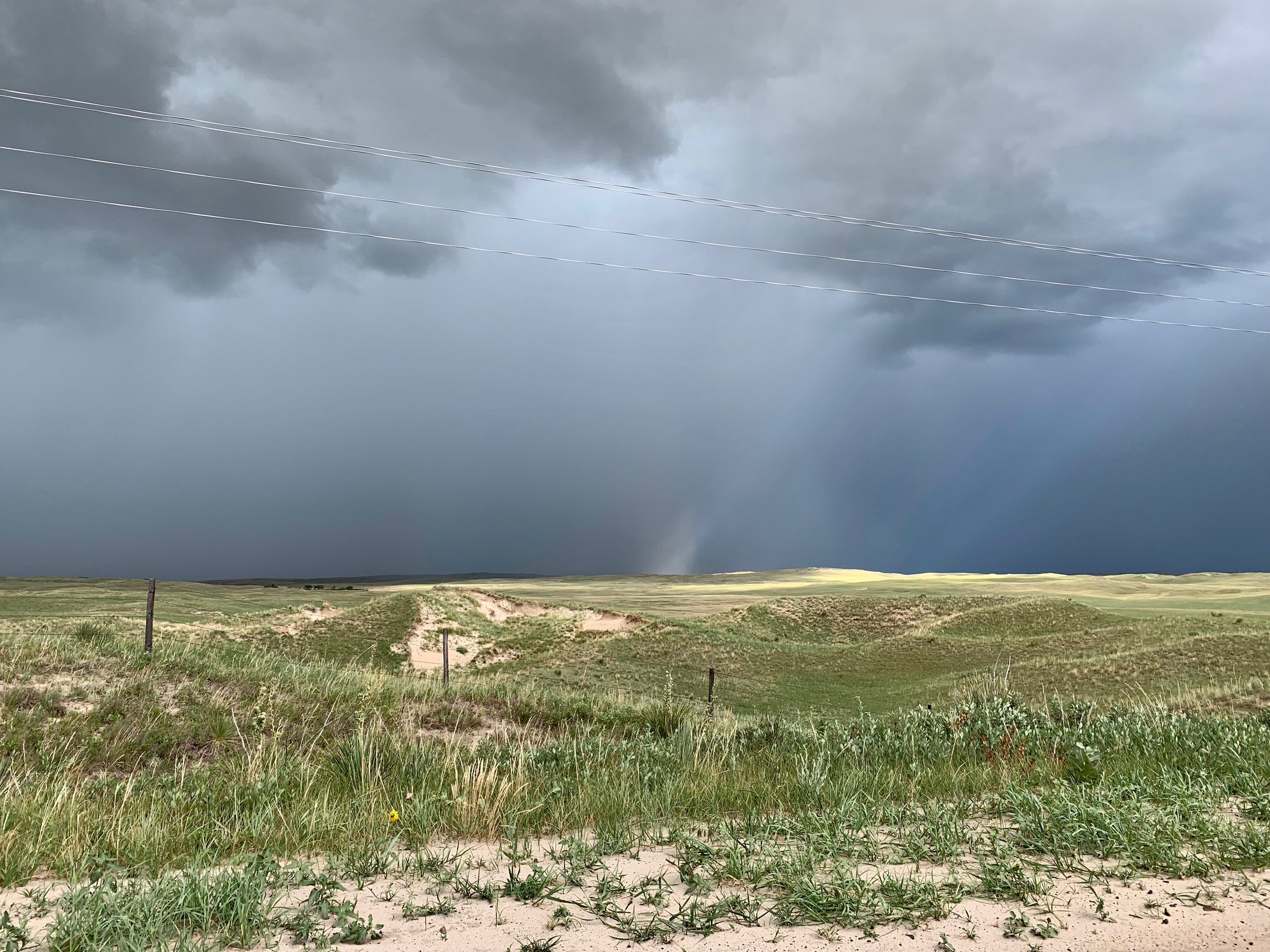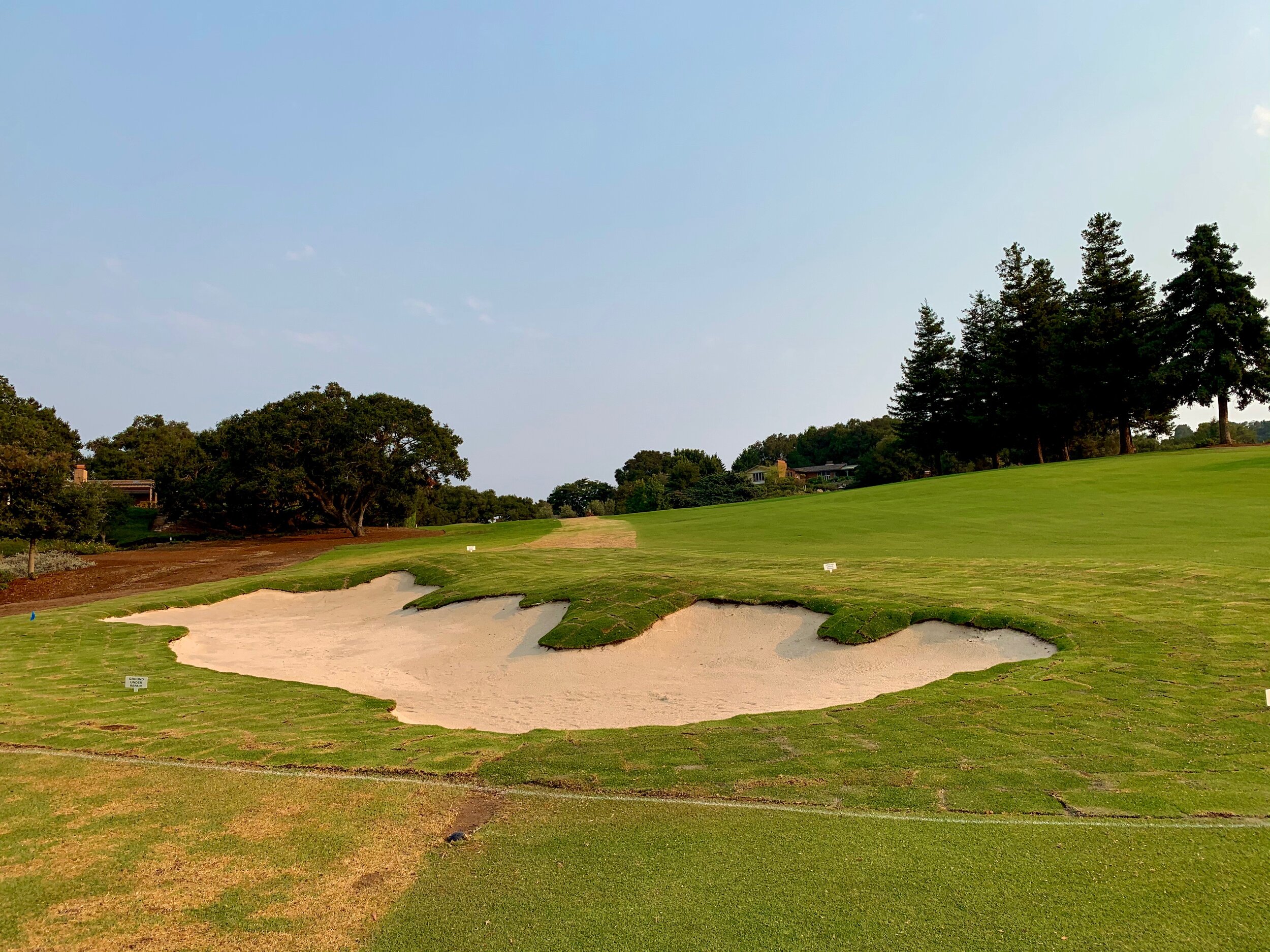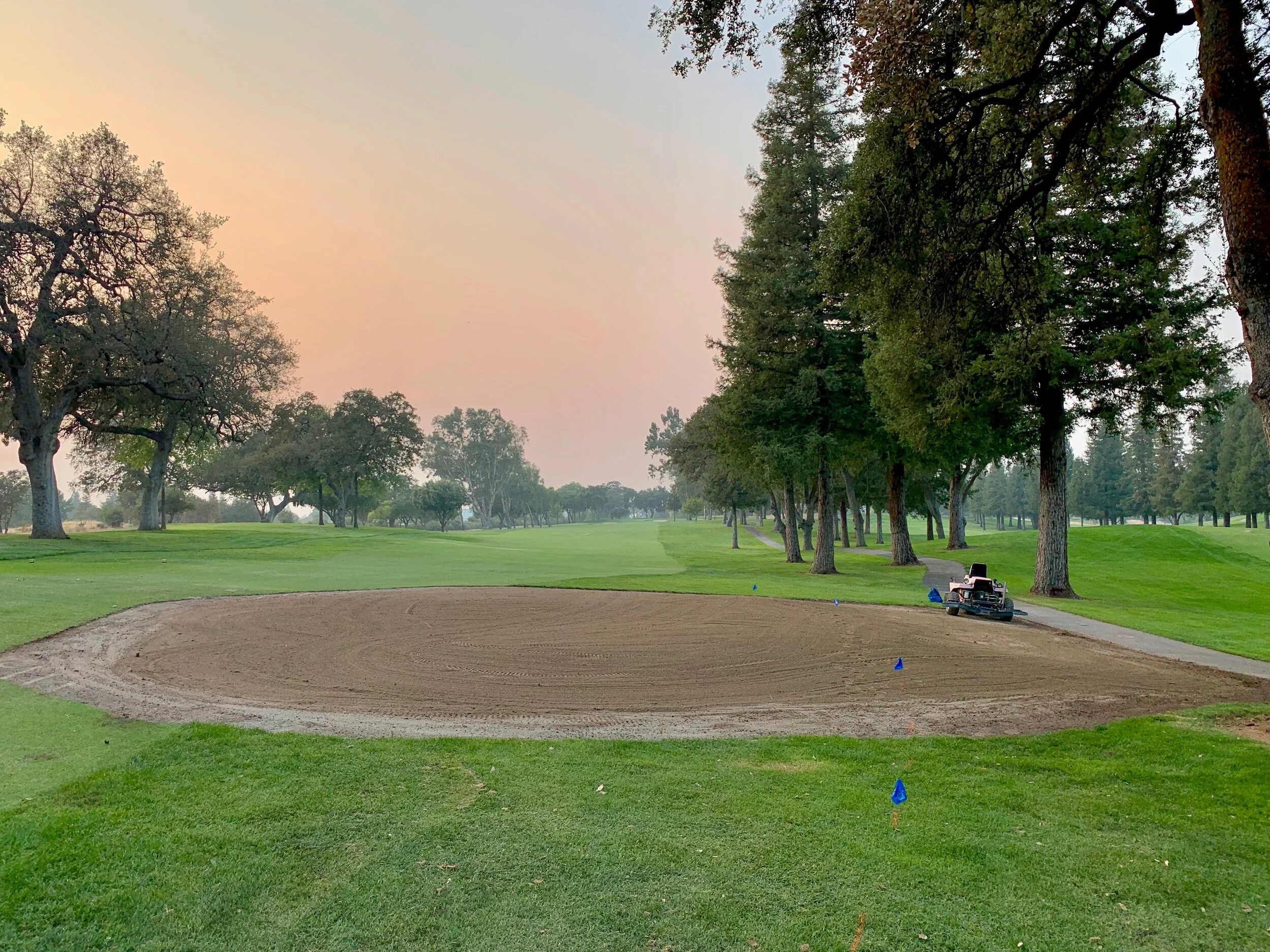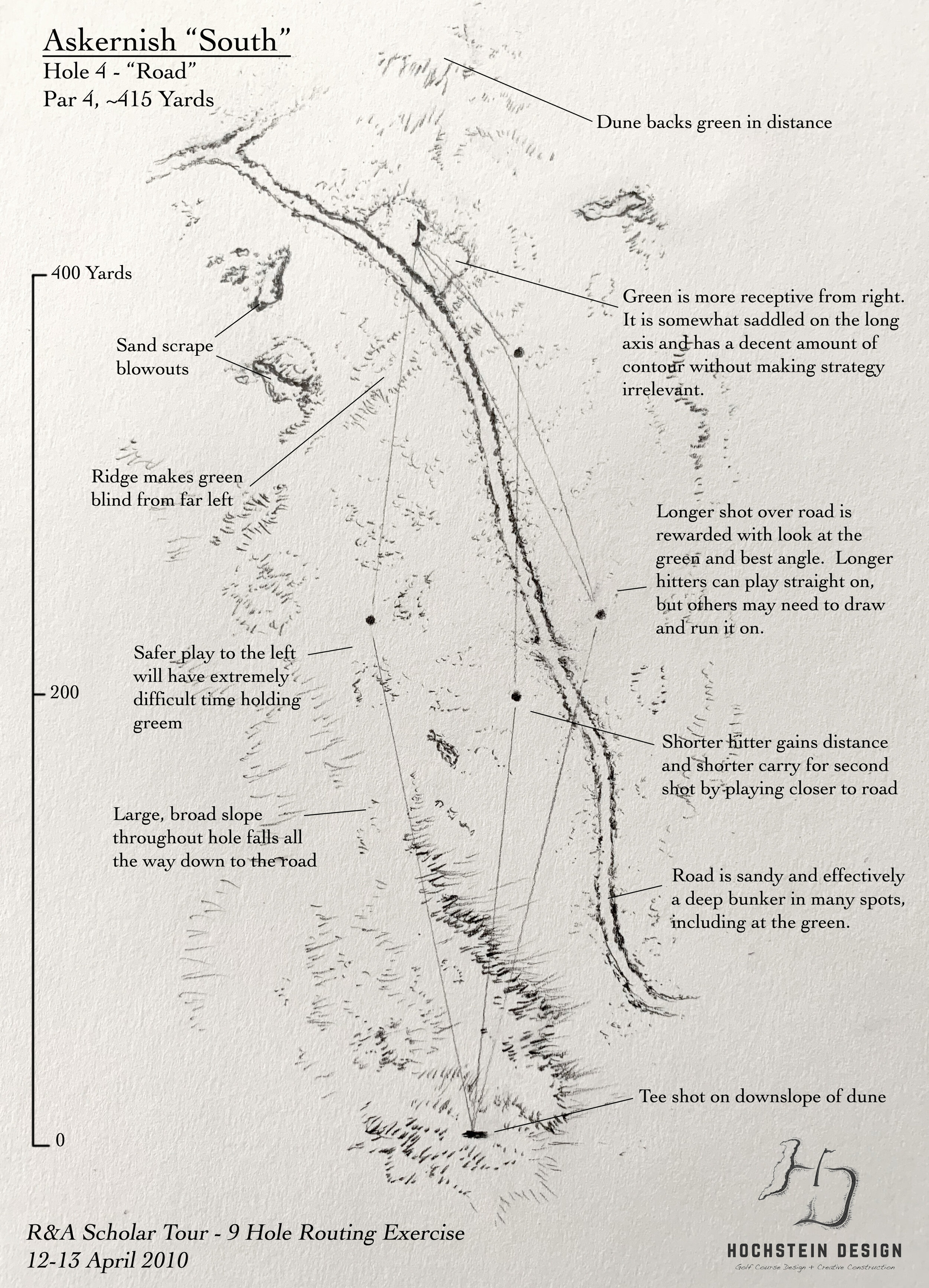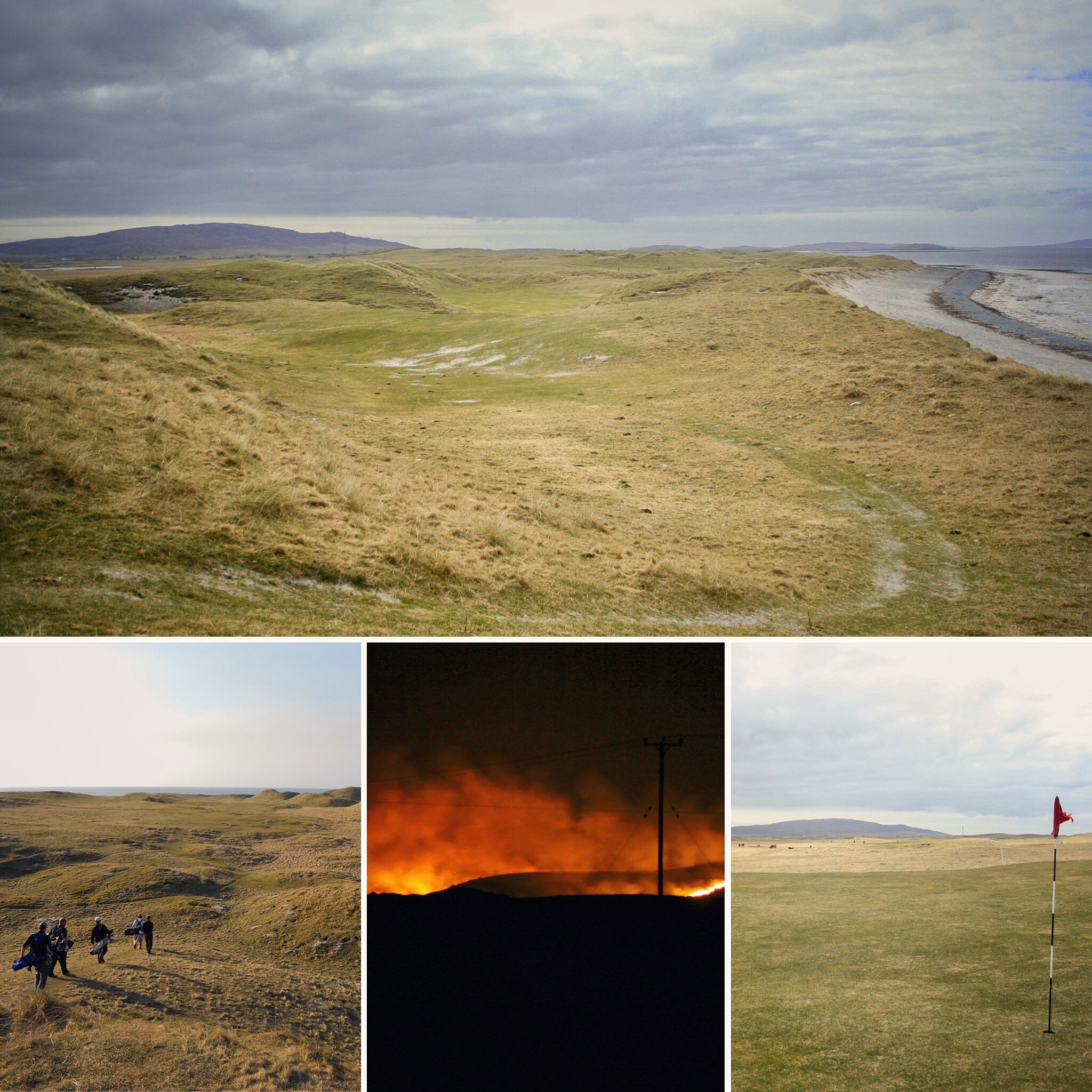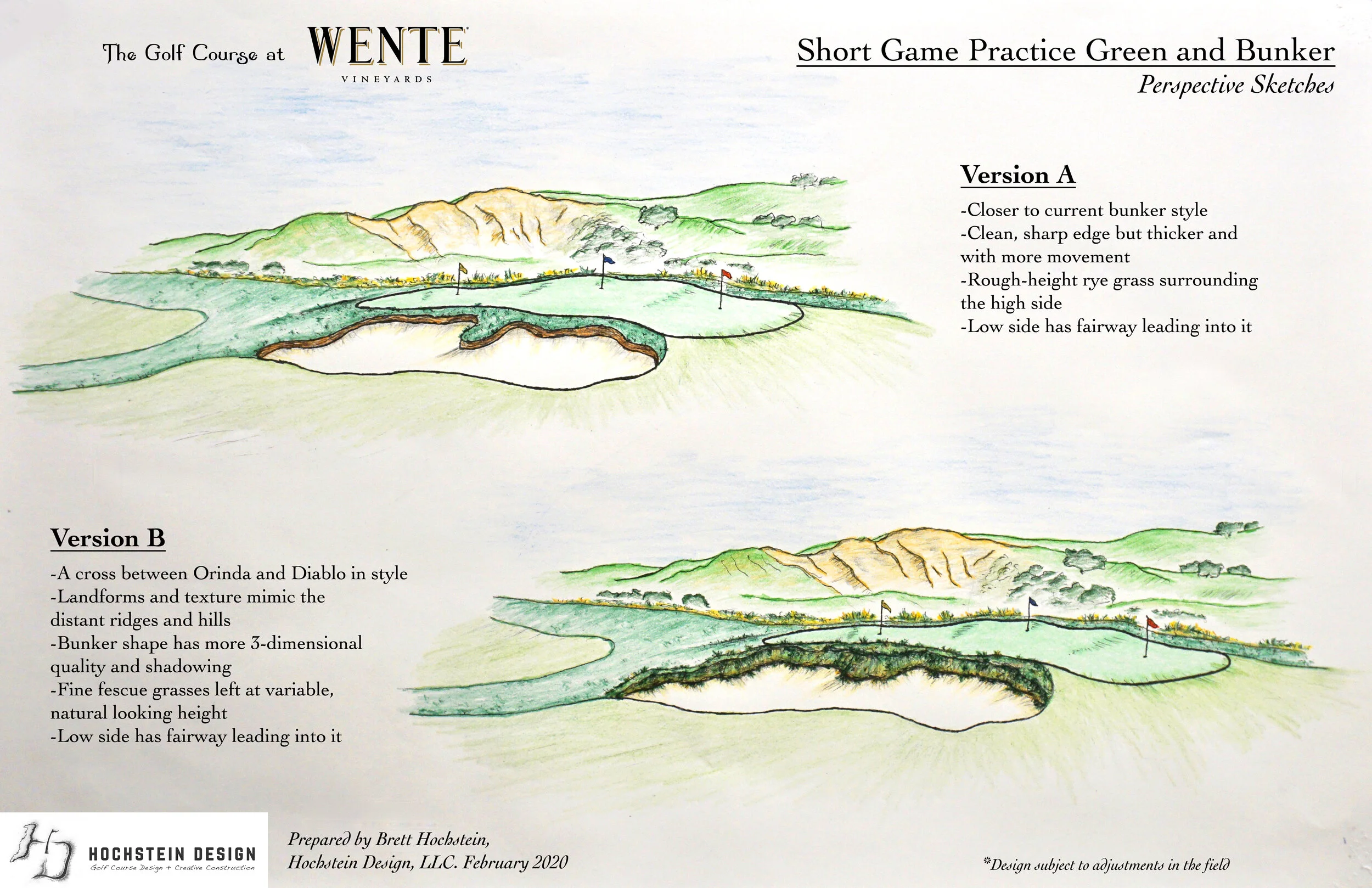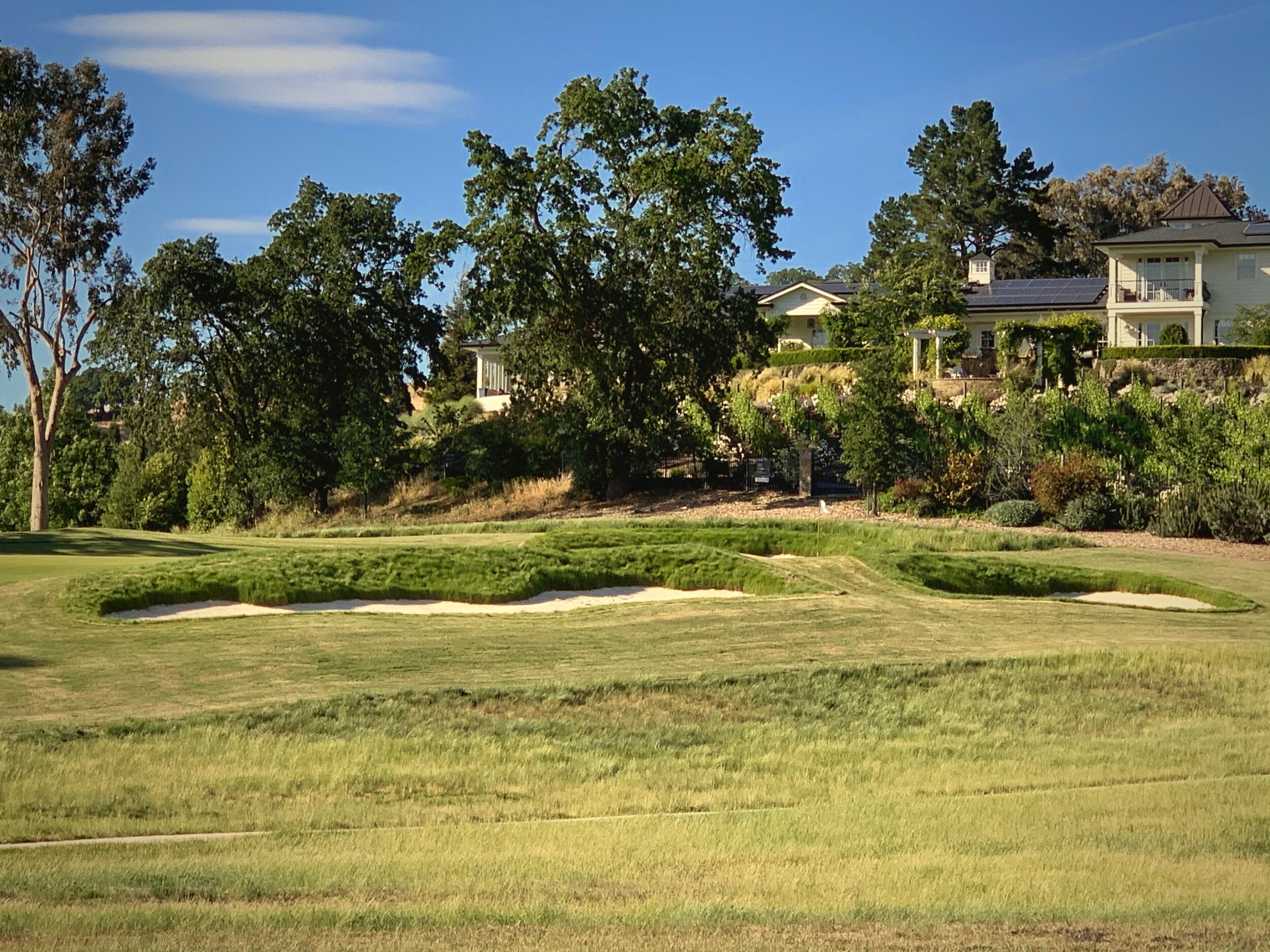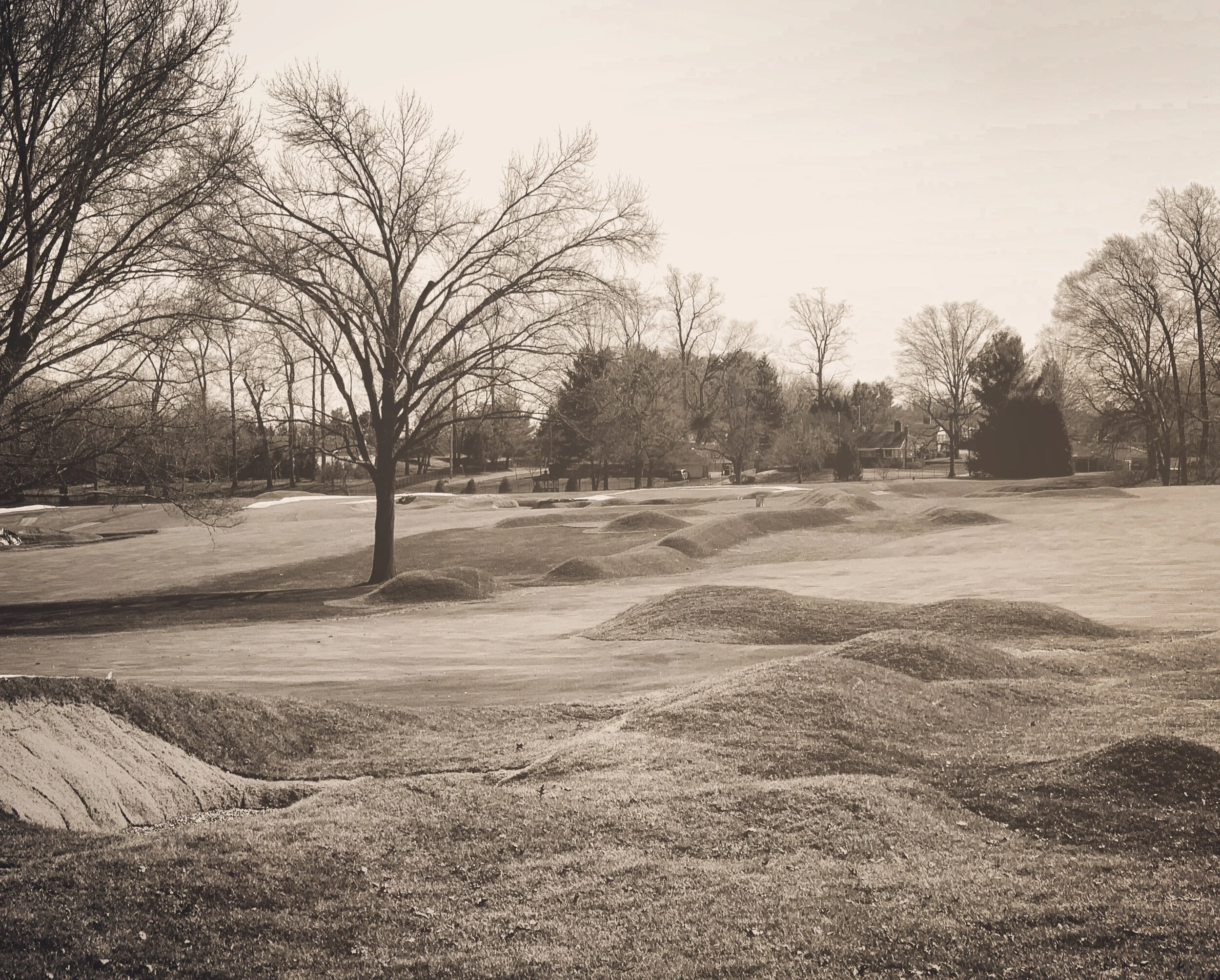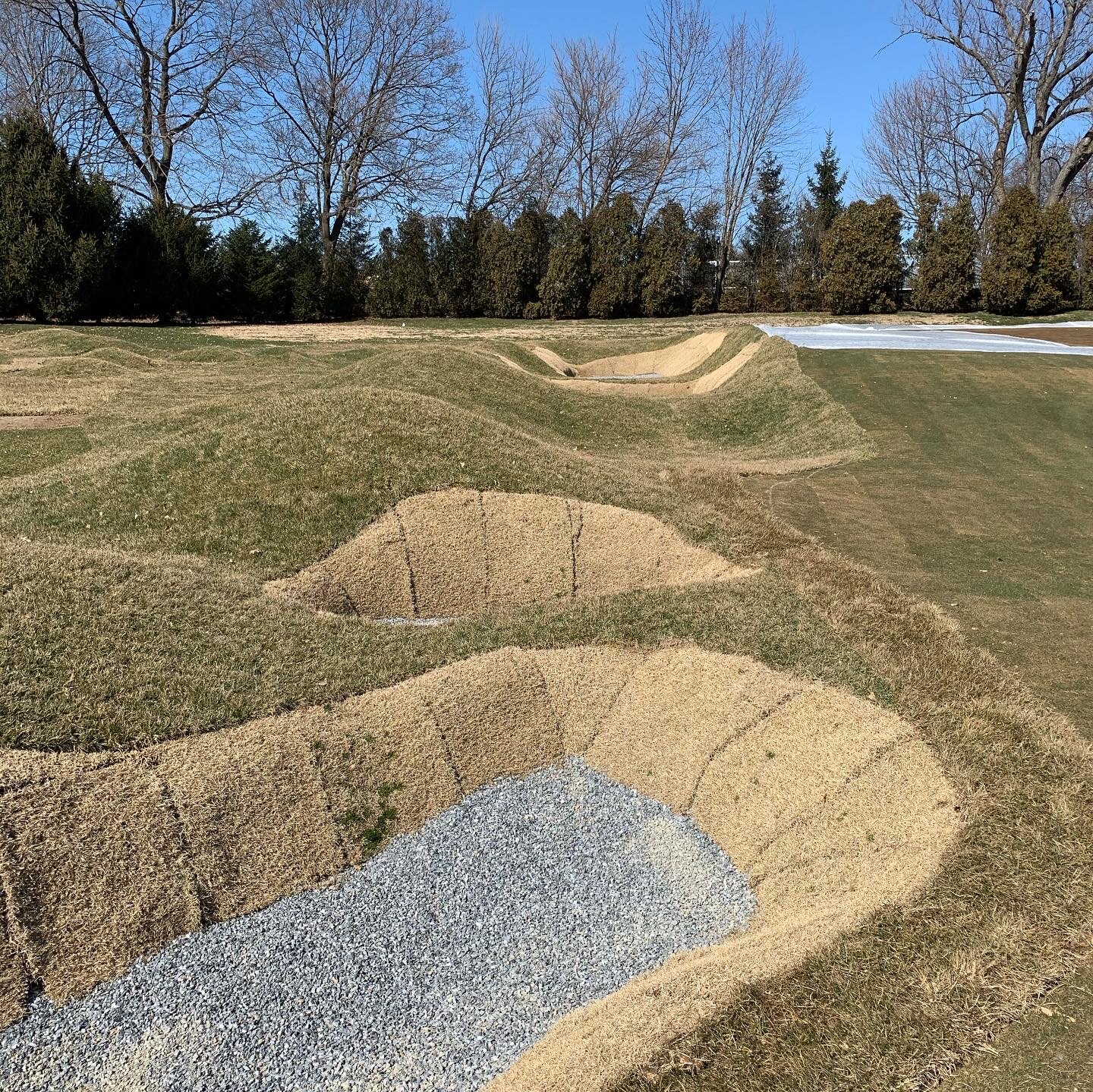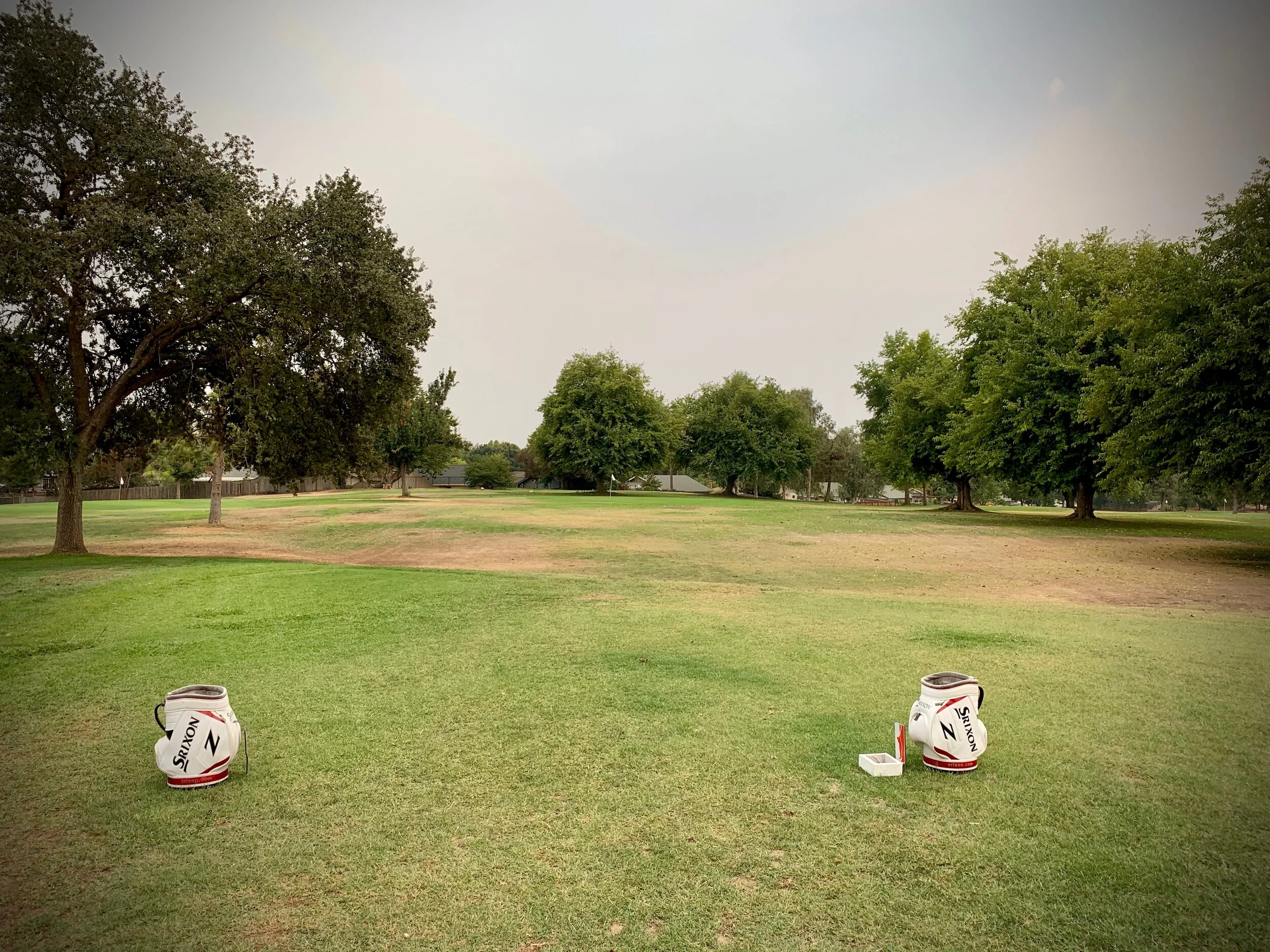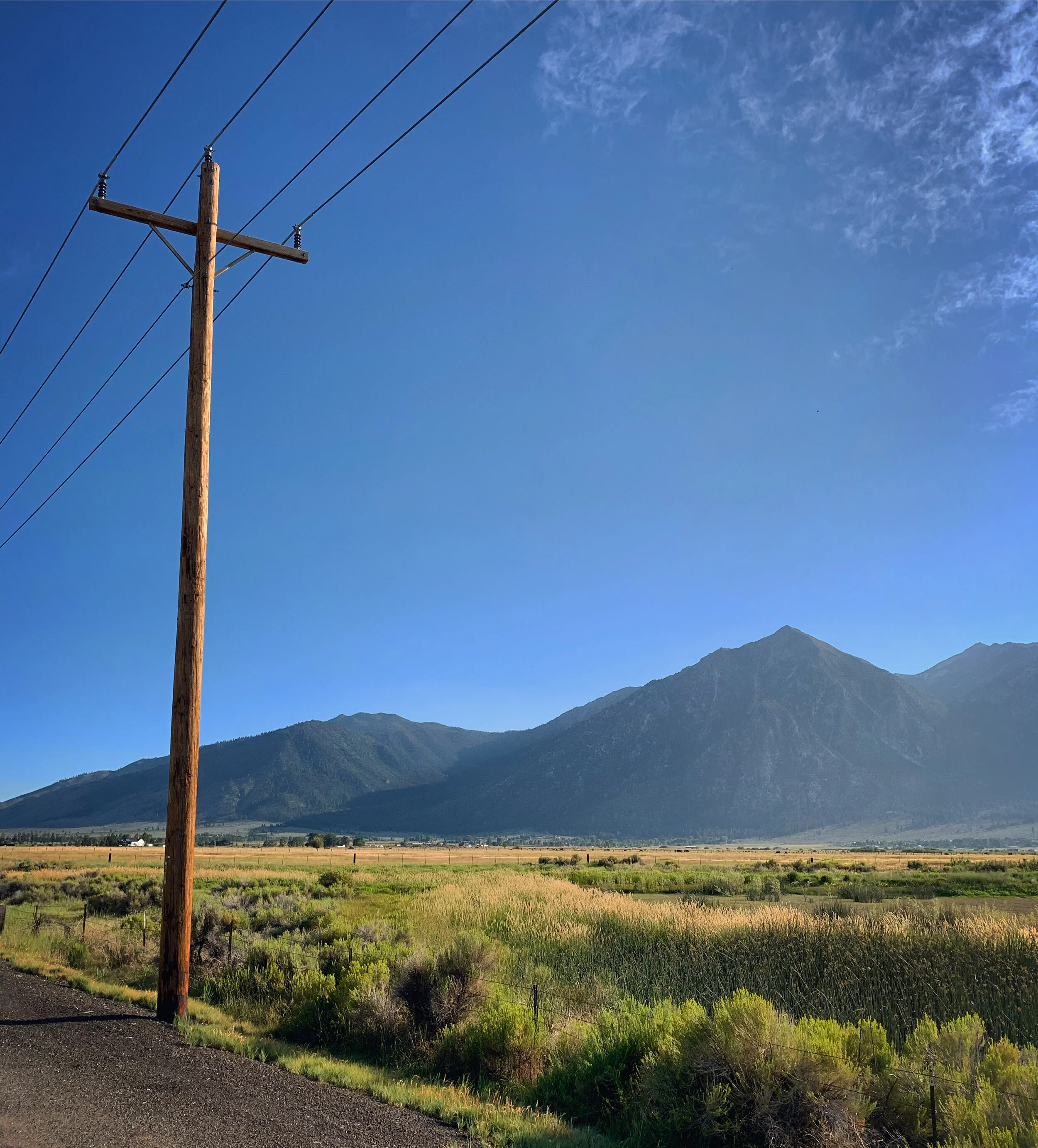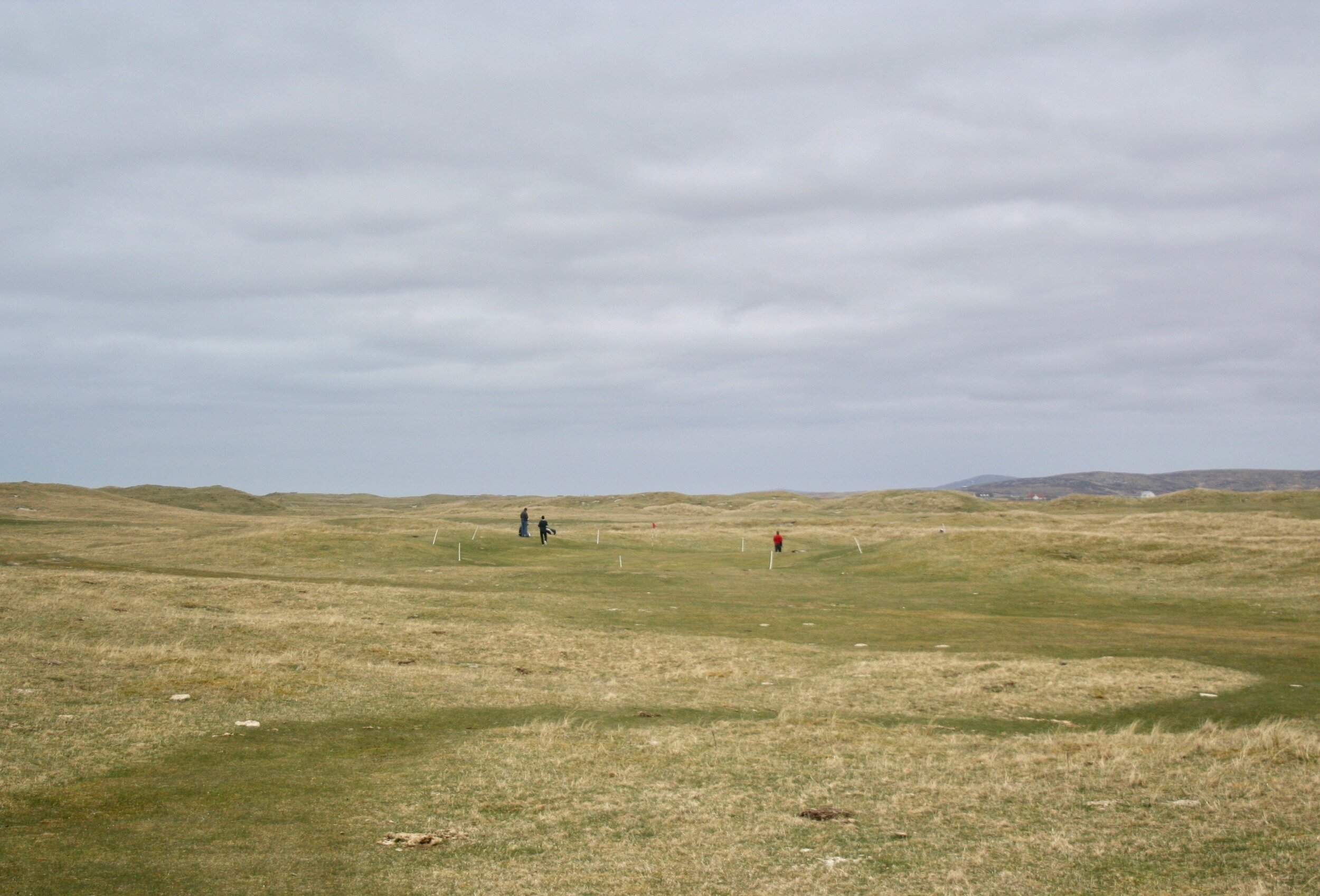Hole 18 at Pasatiempo with its famous cascading front bunkers—taken some time in the early 1930s
As has been noted elsewhere, I was fortunate over the past two years to help out on Jim Urbina’s (further) restoration at Pasatiempo. I say “further” because he, alongside Tom Doak and various crew members from the Renaissance Golf team, already did a multi-year restoration back in the mid 2000s. The work done was really fantastic, and I can’t say enough about what the crew was able to accomplish, knowing both what they started with and what their sorts of limitations were.
With that pre-2000s version of the course, the routing and general shapes of most greens were still largely intact , but the aesthetic parts—bunkers, trees, etc.— were a long way off from MacKenzie’s time. Bunkers were missing or in different spots, and none were in a Mackenzie style at all following big renovation work by Robert Trent Jones over the years. Trees also overcrowded the corridors and blocked views, and critical features like the barranca short of 12 green were missing or completely different. Jim, Tom, and that crew had to start from scratch in many cases, trying to find common-link starting points from past pictures and aerials, and interpolate from that as best they can. They really did a lot of legwork in locating bunkers, measuring out their proportions, and bringing them mostly back to their MacKenzie form. They succeeded so well in doing this that I believe it to be a big part of the concern and uproar over this latest project when it was first announced. It was great work, and it really made a lot of what we did on this latest go-round that much easier.
They were also limited in what they could do though, for many reasons, and some of those limitations are what drove this latest project to happen. Greens were off limits, as were many tie-ins into them. Work zones were probably more restricted as well. Cart traffic drove some decisions. And of course, there is always the constraint of time and the rush to get holes back fully open for play. As such, there was a lot left on the table that those guys would have loved to get to and address. And that’s where many of the opportunities here in 2023 and 2024 were still waiting for us.
In this post, I don’t want to get too deep into the nitty gritty of the project work, nor do I want to get much into the greens. Those are discussions for a different time and place that should involve more people, especially Jim. What I want to do here instead is share some pictures comparing this recent project work, particularly the bunkers, to the 1929 and early 1930s sepia-toned photos from just after the course’s opening. Those photos effectively served as our “plans” for the project, especially for the stuff that’s easier to see like big contours and the bunkers. Wherever we could, our goal was to build things back as closely as possible as what could be seen from these photos, along with assistance from the 1931 aerials, one of which had great detail but only showed some of the front nine and another that showed the whole course but was grainier and washed-out.
Trying to build back to these photos is a fun and challenging exercise. It is also not at all as easy as it may seem. For one, the pictures are often grainy and hard to discern details. You also have to adapt to changes in the ground over time, some of which are more subtle and undocumented. This part can be the hardest, because what you are doing essentially is trying to match 2-D to 3-D, and when that 3-D has changed and shifted (in addition to just being difficult to discern in photos—this is why great bunkers get photographed way more than great greens), it becomes a rather challenging and dynamic puzzle trying to make the 2-D fit.
The starting point of this process for me is to find out where the original historic photograph was taken. Again, this can be quite challenging, especially if a lot has changed. The key is to try and find common fixed points—a mound that hasn’t moved, a green edge that seems about the right spot, a house, a road, a mountain, a water tower, a tree (which has surely grown!), a further distant green or bunker, or often times at Pasatiempo—fairway ground contours. You then have to carefully look at those fixed points and try to spatially line them up as if your eye is looking at a 2-D photo. For example, if the peak of a mound in the old photo is ~20% to the right of a distant building on the way to a still-existing tree stump, make sure you’ve got that ratio matched up. Ideally, you have at least two of these points of reference, because doing so can help to “triangulate” your position, not only getting your angle correct but also distance, which is key to make it all work. To help check that your “eye” is right, take some photos at different zooms, and then put them in an album alongside the historic photos. Then you can toggle back and forth and see if it looks like you got the spot right. This process can sometimes take a couple hours if your available information is lacking or just harder to see (such as contours), and it really takes some self-scrutinizing and double checking to ensure it is correct. Even then you might find that a spot wasn’t quite right at first and adjust it later, as I did for one of the photos on 10 after the left greenside mound on 16 was restored, which was one of my (admittedly flimsy but still best) fixed common points used for the shorter approach picture. This was fortunately no problem, as only half the bunkers on 10 had been completed, and those still lined up pretty well to the old picture from the new spot.
Sometimes cross-referencing aerial photos can help, as it did in the case of hole 3, and sometimes it’s pretty easy and obvious to find your spot, as in the case of one of 18’s photos, using the still-existing barranca landform of the forward tee to line things up. Sometimes the picture is taken in a nice and close spot as it was on 13 (allowing for lots of quick checks), and sometimes it’s 500 yards away and up 100 feet of elevation climb, as it was on 1 (allowing not for quick checks but great for getting your exercise in). The goal to start though is finding that spot, wherever it may be, and doing your best to match the current ground up to that.
True perfection—getting it exactly as it was 90+ years ago, down to the inch—with this process, however, much like a perfect score in golf, is more virtuous than attainable. There are too many subtle changes and mysteries and too many other big things that have changed that you need to tie into. There’s also modern standards and expectations that need to be held to—such as having actual bottomed-out floors, something MacKenzie’s bunkers didn’t always have (some on really steep banks would effectively just have sand slapped onto the slope with the bottom edge serving as the lowpoint, not somewhere in the middle as you see with pretty much every other bunker on the planet). Grass types, maintenance practices, and drainage are also factors, as are general changing conditions of the site, such as many more trees or way fewer trees. So, you can’t quite get it perfect, but that does not mean you should not try for it. Perfection should still serve as your goal; it’s the amount of time available and historical importance that dictate how close you may be able to get. At Pasatiempo, we had both, and I, like many on the project, took the goal of perfection as seriously as possible, spending extra hours in the evening to ponder adjustments and using a shovel to make edits down to the inch. This project and this place deserved nothing less.
The following images show the results of that effort for a few of the more notable holes that Hochstein Design was involved with (which was about 2/3rds of the project). These efforts, to be clear, were also greatly aided by support and extra-careful finish/drainage work by the Earth Sculptures team, irrigation investigation by the course maintenance team, and important consultation and decision-making with Jim Urbina himself and Justin Mandon, Pasatiempo’s MacKenzie-minded course superintendent involved with every single element of the project.
With so many great restorations having been completed in the past 10-15 years, I don’t know how many more opportunities and projects there will be out there like this one. It was a wonderful challenge, though, and I’d relish the opportunity of getting to be a part of another one.
Hole 2
Hole 2, one of the first holes we all worked on, with its lone historic photo taken from short left
The front bunker is one of the smoothest and roundest-edged bunkers from the original design. There seemed to be a slight stylistic difference in that respect between this end of the property and the opposite far end at 13, where the bunkering took on a more rugged and irregular nature, something more like what you would have found at Cypress Point. It is an interesting difference and something I’m trying to find information on (information that probably doesn’t exist, but curious nonetheless). As such, the mantra always remained, “put it back as you see it in the photographs,” and here that meant moving some noses around and shifting the high points to match the broader greenside contours behind (which, like most spots, were drastically lowered after removing sandsplash+topdressing). The low backside, which you can’t see here, is based more on the aerial photo, and may have even more “going on” than the high side, which makes it cool to view from up near the green or on 3 tees.
With the green building up so much over the years, the back bunker mound and landform really had to be built up to match again. The far left part of it was extended left and built up slightly, just to keep every ball from resting up against the lip. Which is important, because this bunker gets a lot of play, especially with the new greens as firm as they are.
Hole 3
For fun and validation, I photoshop-copied Homer Hayward from the old photo right onto his approximate spot in the modern-day photo.
Hole 3’s construction story could probably take as long to tell as it did working on it (that’s a lot of big bunkers!), but let’s keep it short. Using a combination of the aerials and the above black-and-white photo featuring Homer Hayward, we were able to figure out the general spots of bunkers based on the house that was built in the 1930s, a couple of subtle landforms, and placing straight perspective lines on the aerials and figuring out where certain lines crossed, which gave us the approximate spot that the photo was taken. These findings were then validated after discovering original MacKenzie bunker sand buried deep below the surface, both on the back right pair of bunkers (low right in these photos) and the big arc-ing back left bunker wrapping around the green (top middle and right in this photo). It was that sand found in the high bunker (along with another hard look at the photo) that led to the restoration of that part of the bunker much higher up the slope, as opposed to greenside as it had been before. A look at decades of aerials further confirmed this finding, as did the shape of the old “floor” after that sand was excavated out. An incredible hole with incredible bunkers, and definitely the most fun and fascinating bit of golf archeology I’ve thus far gotten to be a part of.
Lining up MacKenzie’s capes and bays gave an idea of where the photo was taken from.
Extending the house lines in the 1940 aerial helped indicate both bunker and green placement, giving solid evidence for greatly expanding the front.
Hole 10
Studying the foreground landforms on hole 10 at Pasatiempo revealed a need to extend the bunker scheme further over to the left, which also fits the scale of the space and landform better.
Given the amount of things going on here, the obstacles present, the pesky groundwater, the apparent need to stretch everything further back down the barranca, and the crazy amount of fill material needed to raise the barranca floor and restore the left part of the “half-pipe” up in the approach—the front bunkering on this hole makes a solid run as being our personal biggest overall accomplishment on the project. With six bunkers down in the barranca, all of them with their own character and all of them playing off one another, this required A LOT of walking back to the photo spots to see how things were looking. Speaking of which, these photos took me the longest to find the spots, and after finding them they made it apparent that a lot of work needed to happen. Like everything else though, everyone else could see it and was on board with the work needed to make it happen.
Kudos to Theisen Downing and Israel Esparza for their great work in the back bunker; I enjoyed looking at it with them and helping paint it out. That was a tough one to put back after gutting out the stumps and roots of the ancient oak that was unfortunately lost the previous year.
The closer up view on 10 confirmed the need to “flash” that little bit of the first backside bunker (bottom left on foreground side), which in my opinion, even though it’s a tiny amount of sand, brilliantly ties together the whole complex and the further up right side bunker.
Hole 13
Saving perhaps the best for last on the project with hole 13 being the last one we helped out on before departing for England.
What a complex. This set of beauties, along with the double-winged green, really “make” the hole on what otherwise might be the most subdued corner of the property. These bunkers mess with your eye well back in the fairway, making distance-judgement difficult (at least in the times when you relied on your eye for that) and teasing a go-for-it attempt up the little runway in the middle.
Even though it may not look it, there was a fair amount of material hauling here and shifting some of the main positioning of edges and lines, getting them to match more closely to the aerials as well as eliminating a cart access way in between the two big right bunkers. The previous work was so well done, especially considering there was nothing to start with, that it took a lot of scrutinizing the pictures to notice the need for those edits.
This was the last hole we got to work on, getting in to everything except the left greenside bunker, which Israel and his guys did some nice work on. What a treat to finish with though. They say something in golf about “that’s the shot that keeps you wanting to come back.” Well, these bunkers were that “shot” and left me wishing we had another nine tucked away somewhere to work on the next summer. Fun stuff.
Hole 16
The further back in the fairway view of 16 at the tail end of grow-in.
The closer up view of 16 offers the rare case where there were more trees in the historic version of the course.
Hole 16 was a real point of focus on the project, and how could it not be? It was Mackenzie’s proclaimed favorite par four, after all. I’ll leave a lot of the discussion, particularly the green, to Jim and Justin in Matt Ginella’s excellent documentary video series put together by his Firepit Productions team. I will make a few notes about the bunkers though, both of which benefitted greatly from the restored and re-fattened contours tying into the famed green above them.
On the right, the main points were shifting the fingers down closer to where they appeared on the photos, getting the curves in the lowside back, getting the finger and bays of the far right back in place, and trying to get the little “hook” back on the front left corner. With tight spacing and modern drainage (and stance) standards, no one was sure if we could get that back, but it was certainly worth a try, a try that we were ultimately successful with, thanks again to extra efforts and care by the Earth Sculptures crew. This was a bit of a strange one to translate from the old photos given apparent changes to the barranca (read: wash-aways) and the lack of trees on the right today, but I think it works well for the current space.
On the left is what I believe to be Israel and his crew’s finest work on the project. It’s my favorite bunker of that size on the course, and I think they (as well as the Renaissance guys before) did an awesome job really capturing its unique shape and flow, particularly the way it vanishes out to the left.
Hole 18
It was pretty easy to find this old spot for 18 given the existence of the front tee landform.
Last but not least: the 18th hole and its truly unique-for-its-day front bunkers spilling down into the canyon. I’ve long been fascinated with these bunkers, and I was absolutely thrilled when finding out last time around that Renaissance had brought them back. It was definitely a dream come true then to get back in there and freshen them up again, this time being able to properly tie them into the green with bigger landforms that had gone missing over the years. With as big and steep as these are, this was a rare case of needing to build the top half from above first, then tracking around down low to finish the rest from the bottom.
Another item of note was getting the spacing back on the back bunkers. Israel handled the left bunker and myself the right, which was built up more of the right side, tying in to a reclaimed raised landform to the right of the green. It was also a bit of a trial run at restoring a small “hook” bay of sand, which we’d want to put back on holes like 16. As usual, the drainage guys were able to find ways to drain it while keeping all the little MacKenzie details—no small feat!
As is typical of these posts, I ended up writing more than I set out to, but I hope it helps give some insights into the restoration process at this incredible masterpiece as well as of golf course construction in general. It’s easy to be critical of design and construction work (guilty as charged myself!), but there’s often good reasons for various decisions, both big and small. I’ve really only scratched the surface of such here; the amount of obstacles and constraints encountered is large and daily, especially when exacting accuracy is your goal.
Thanks for reading, and thanks again to everyone involved in this special project, most especially Jim Urbina for inviting me along for the ride and trusting me with the high-pressure, high-stakes work of restoring to Alister MacKenzie.


















